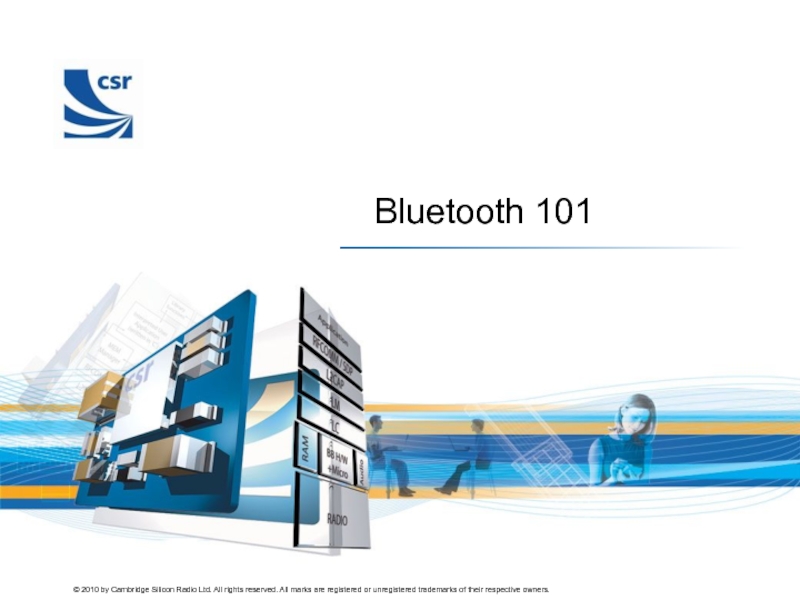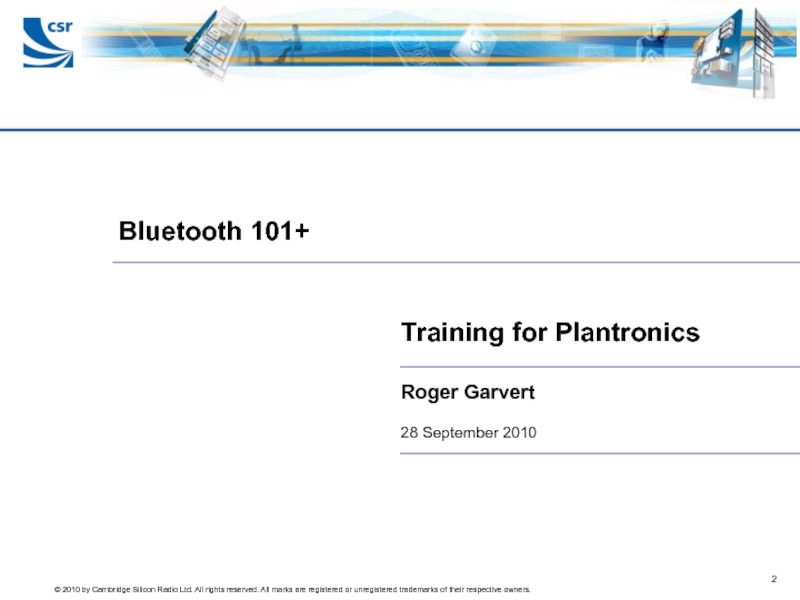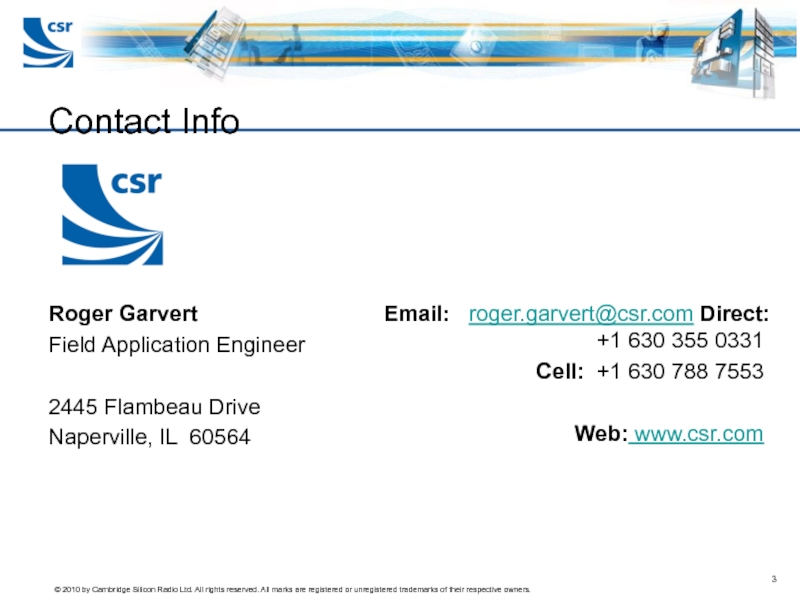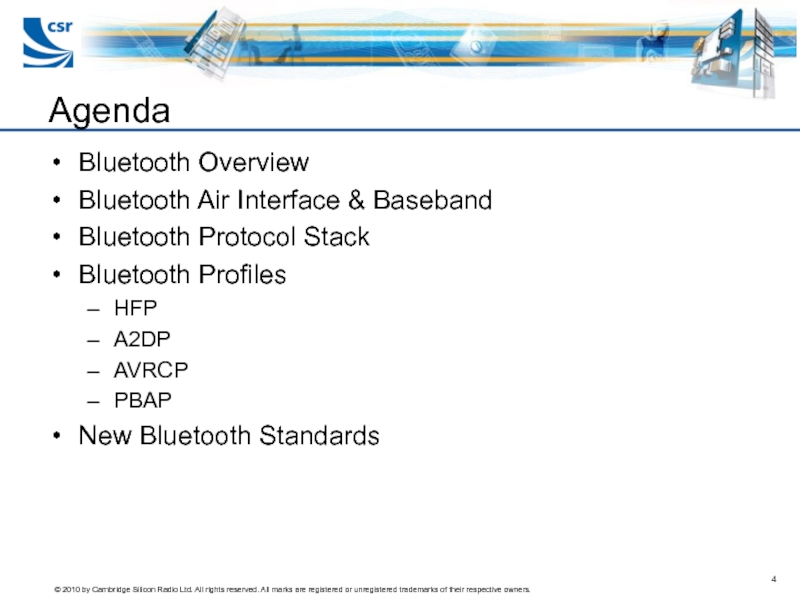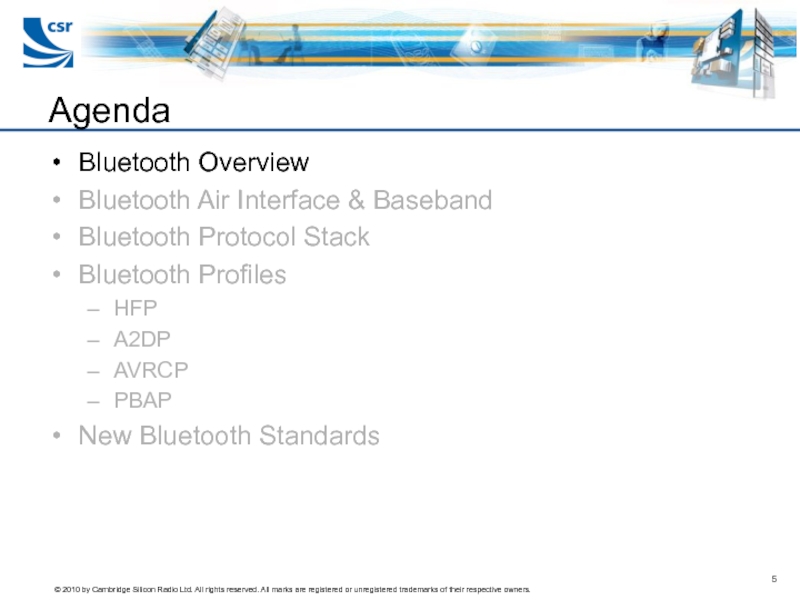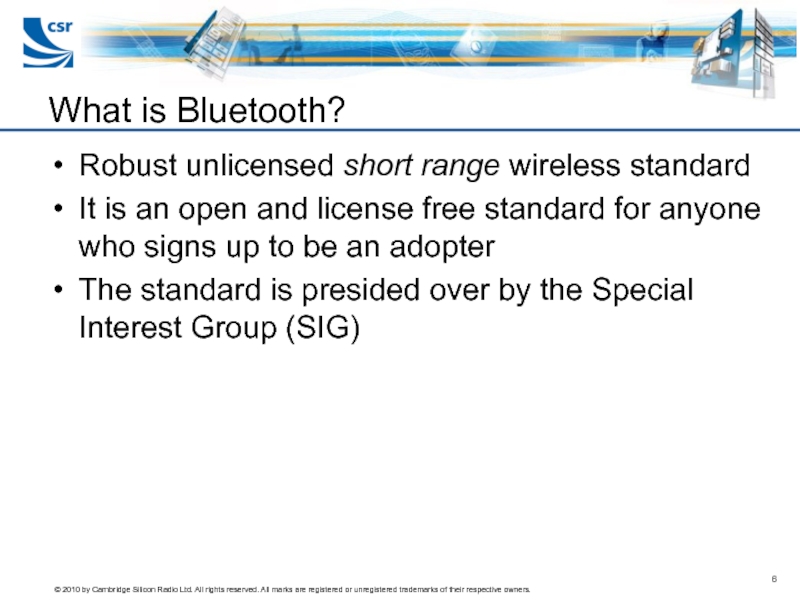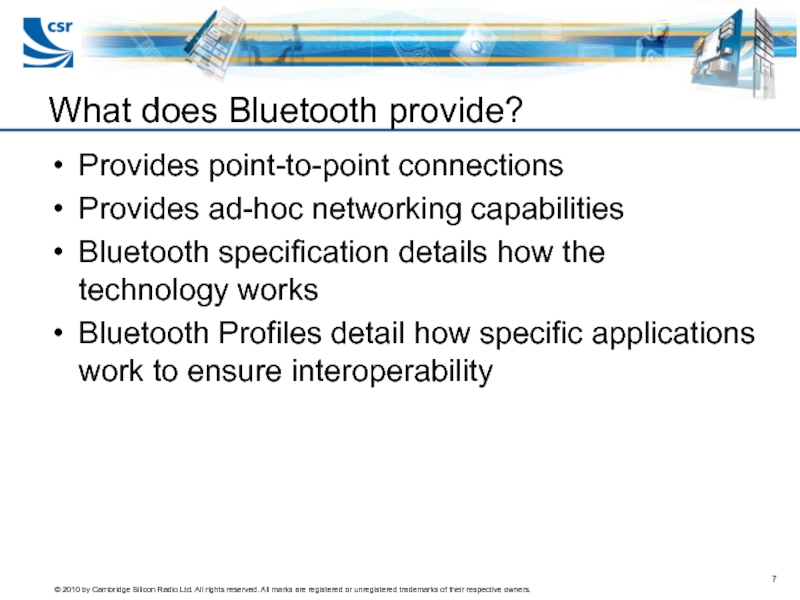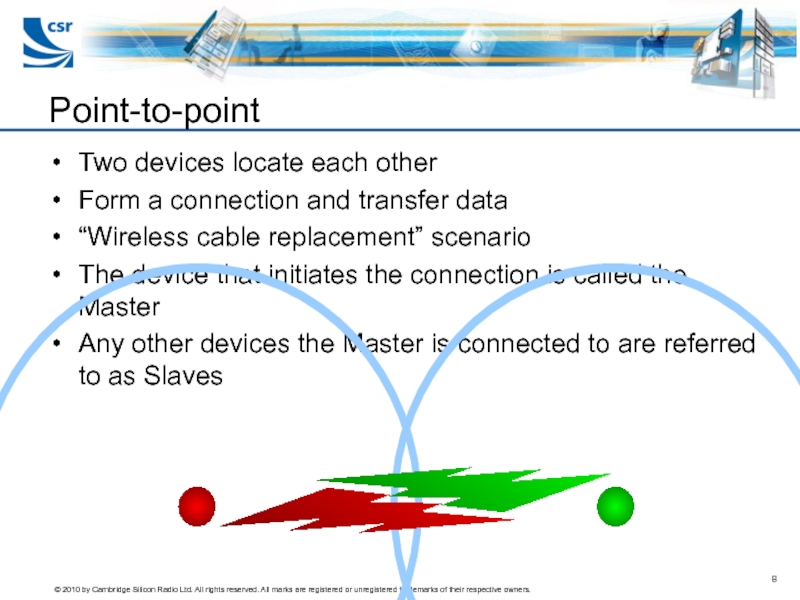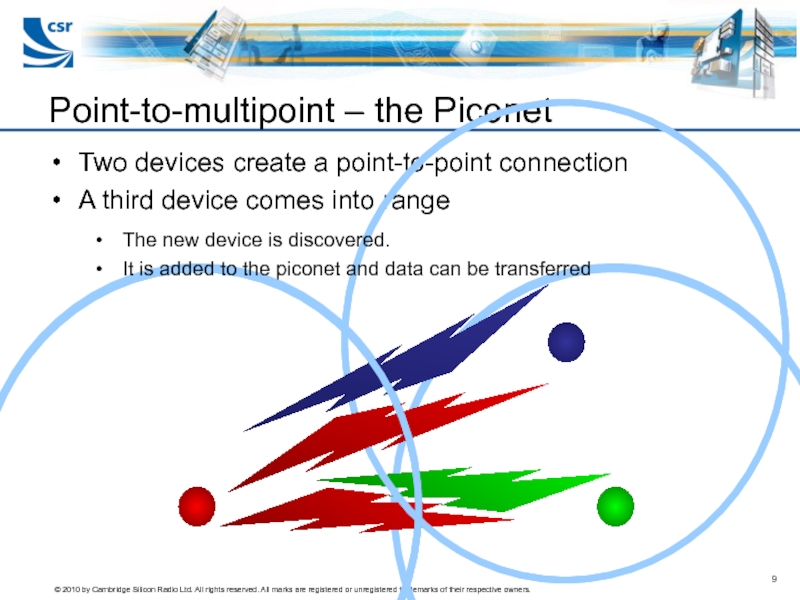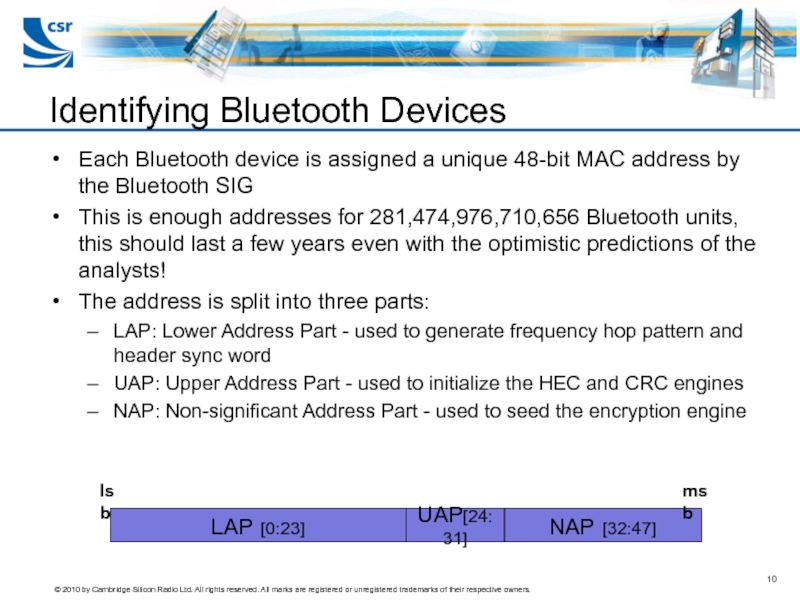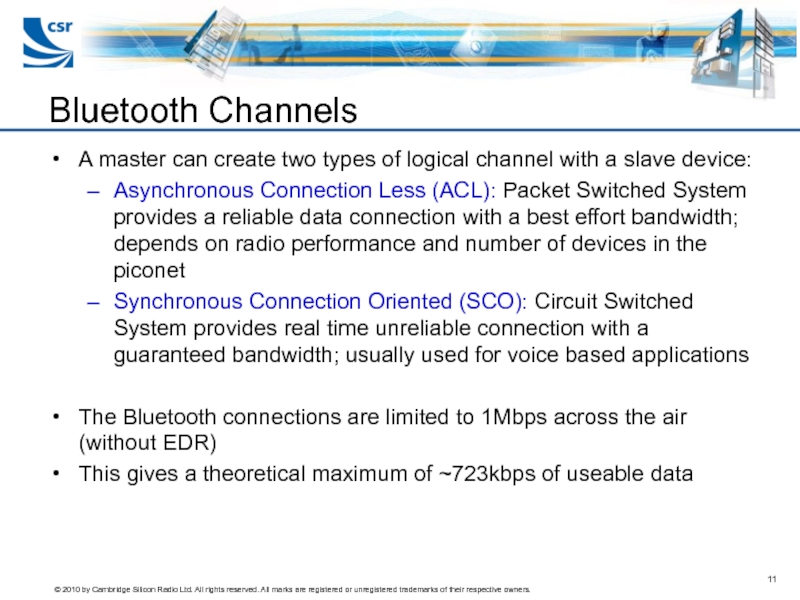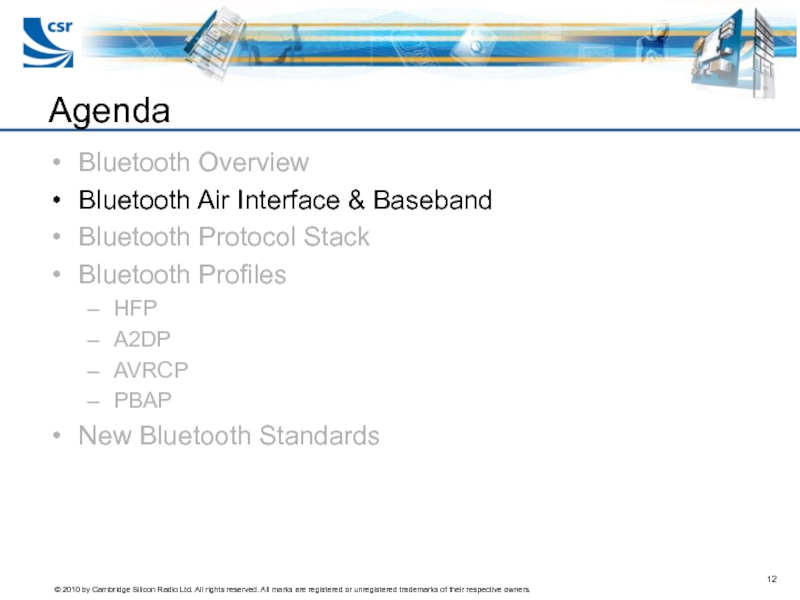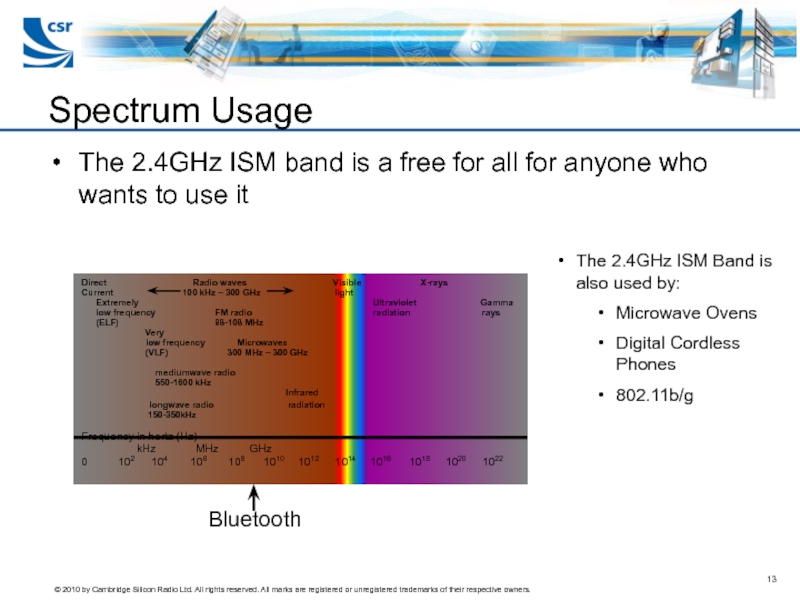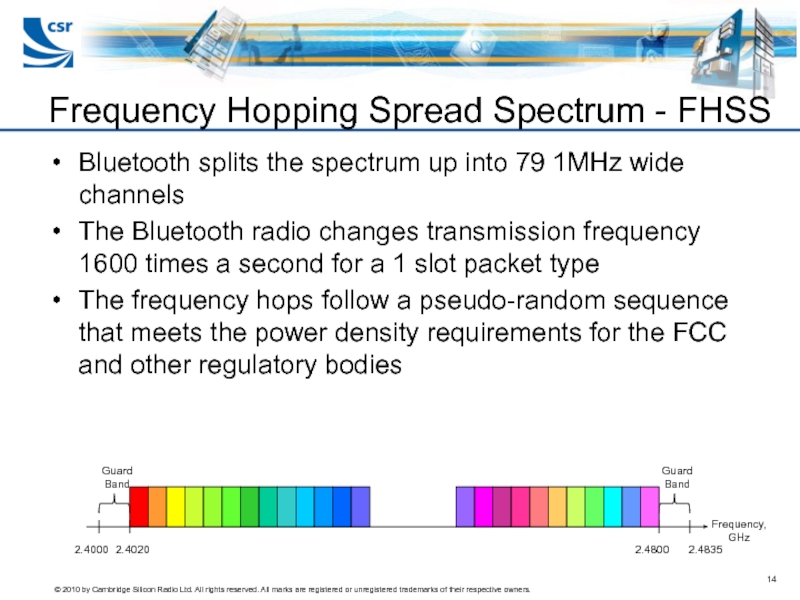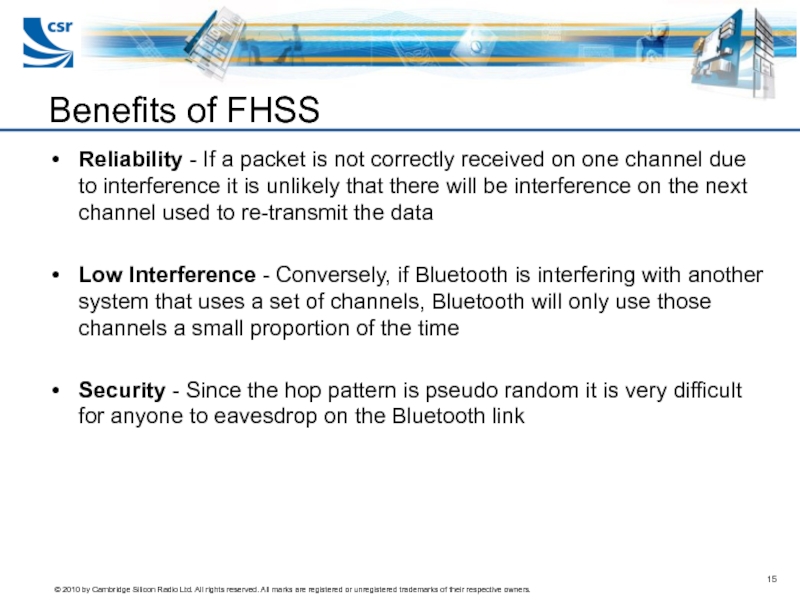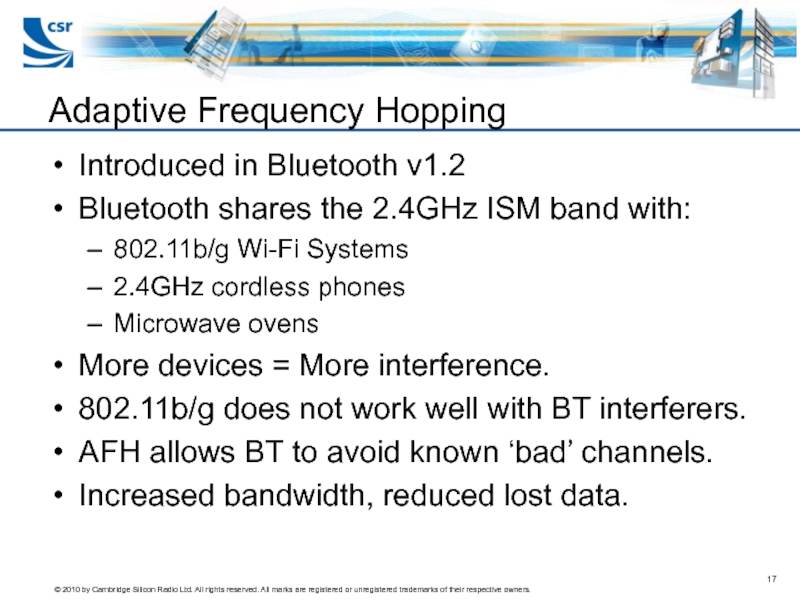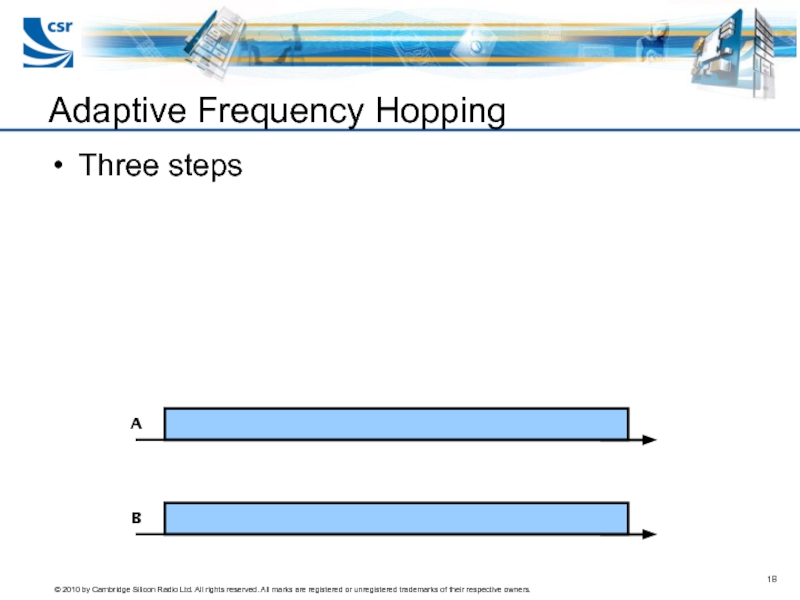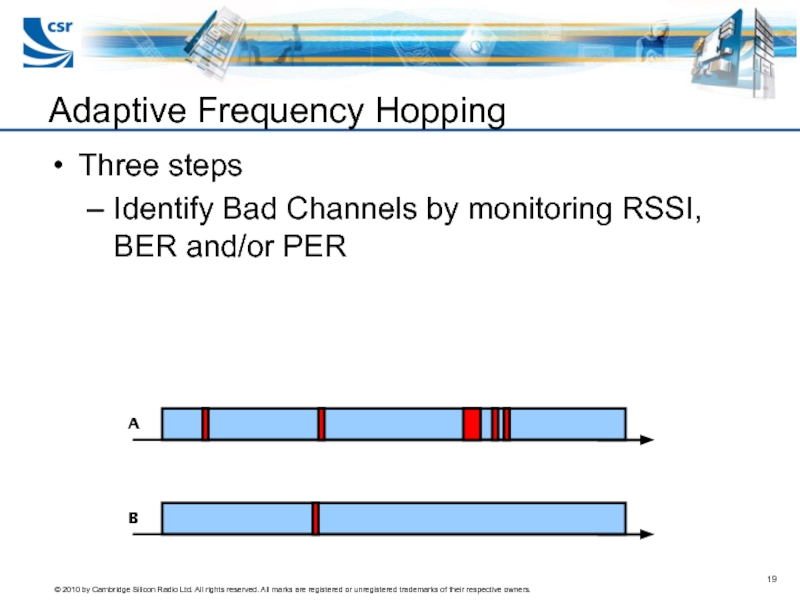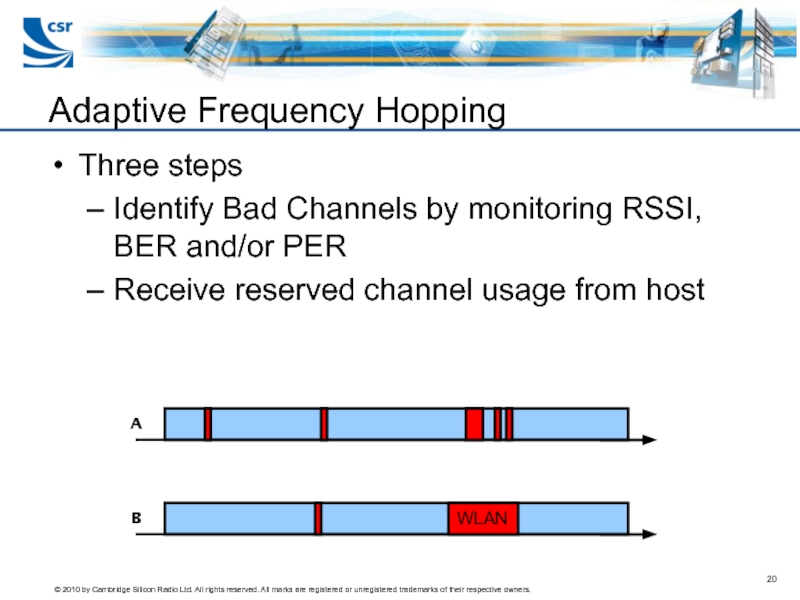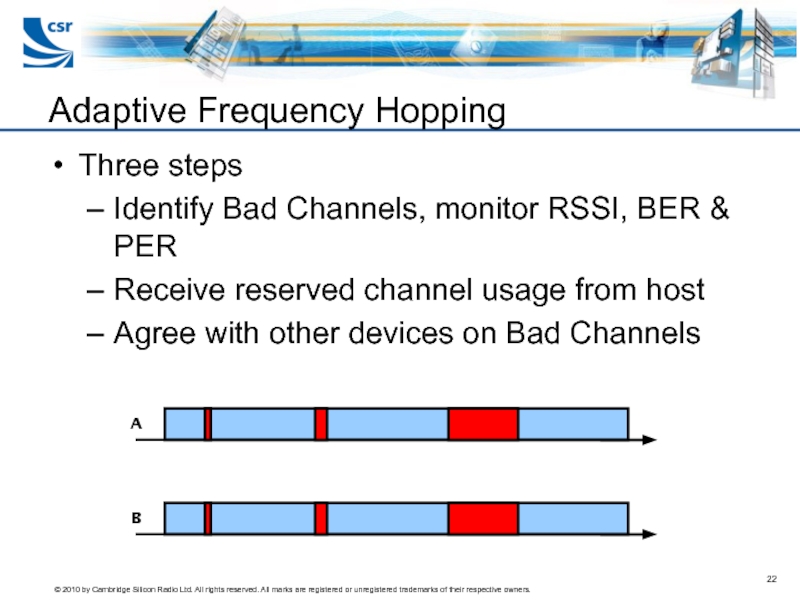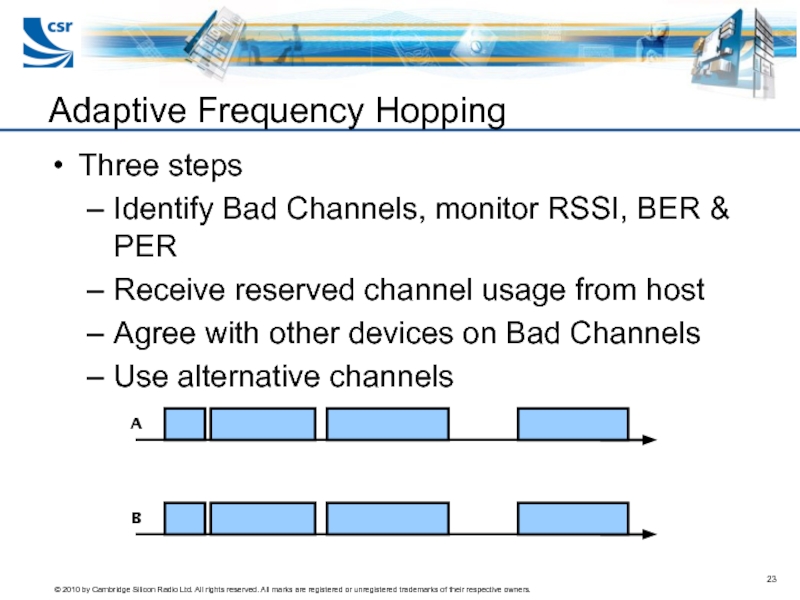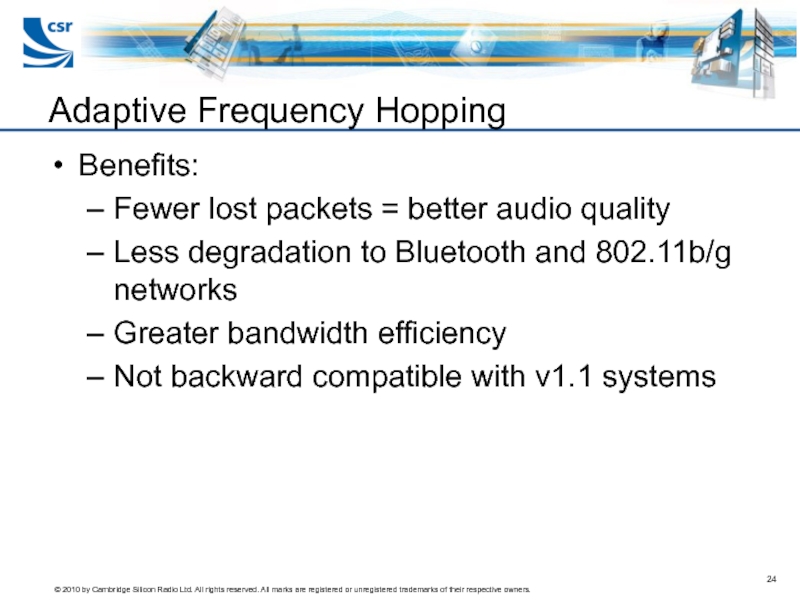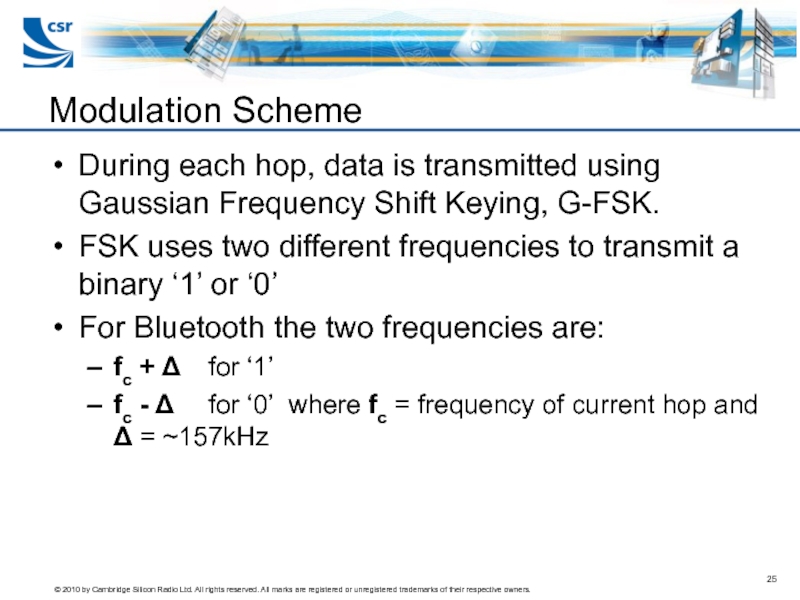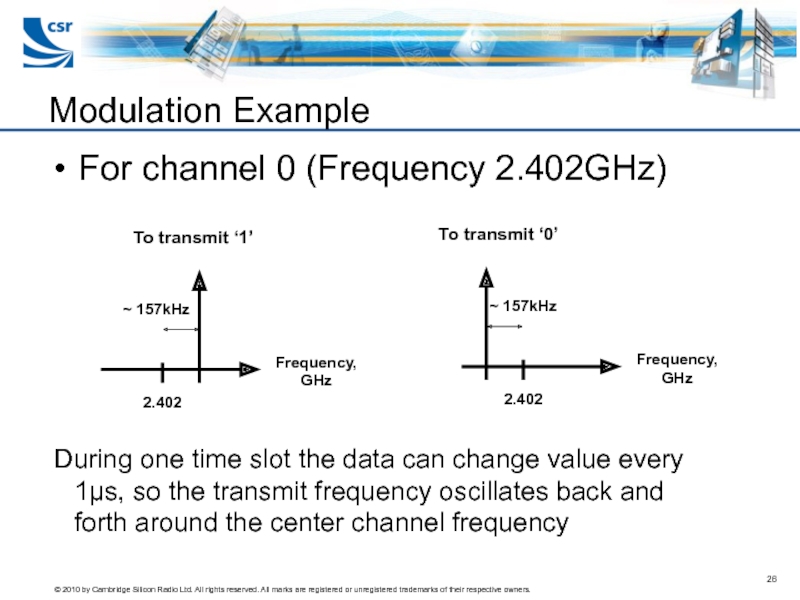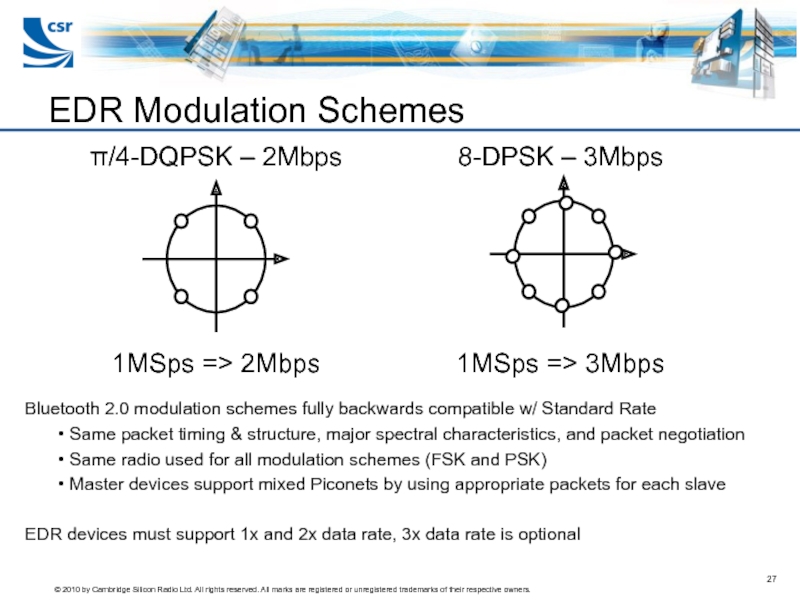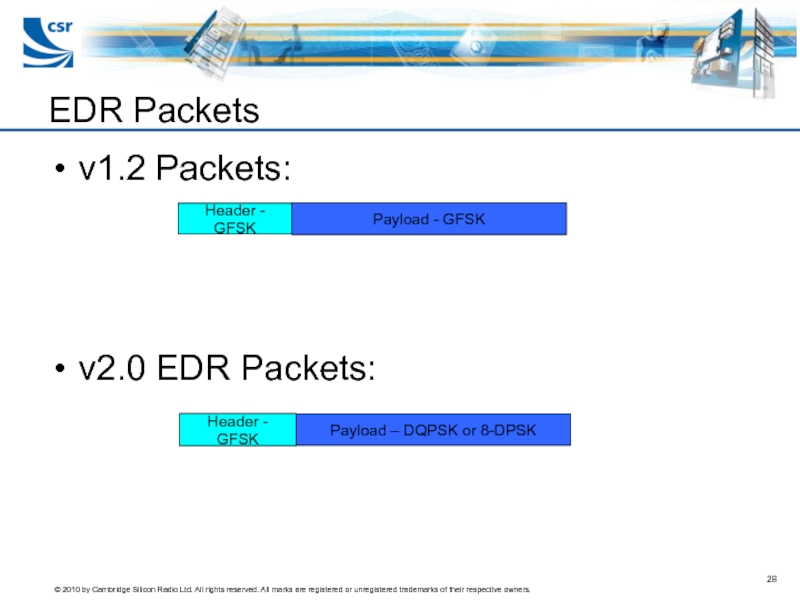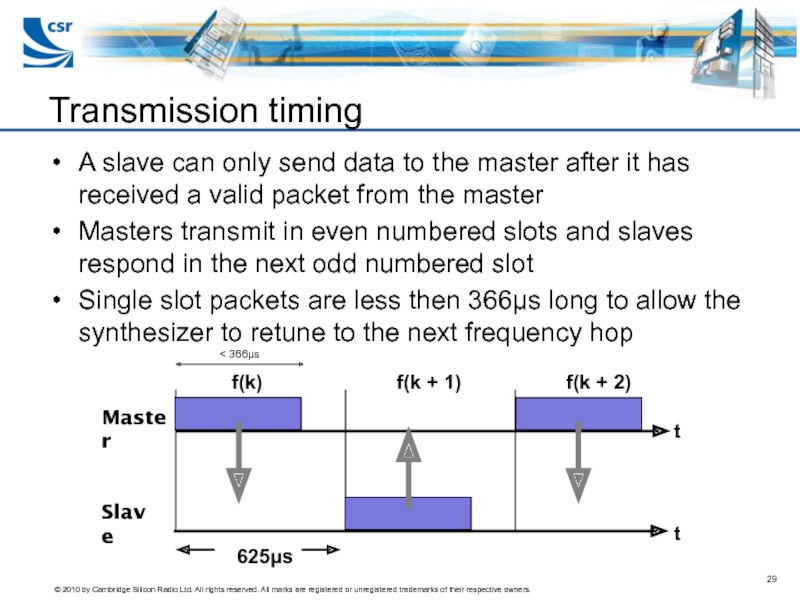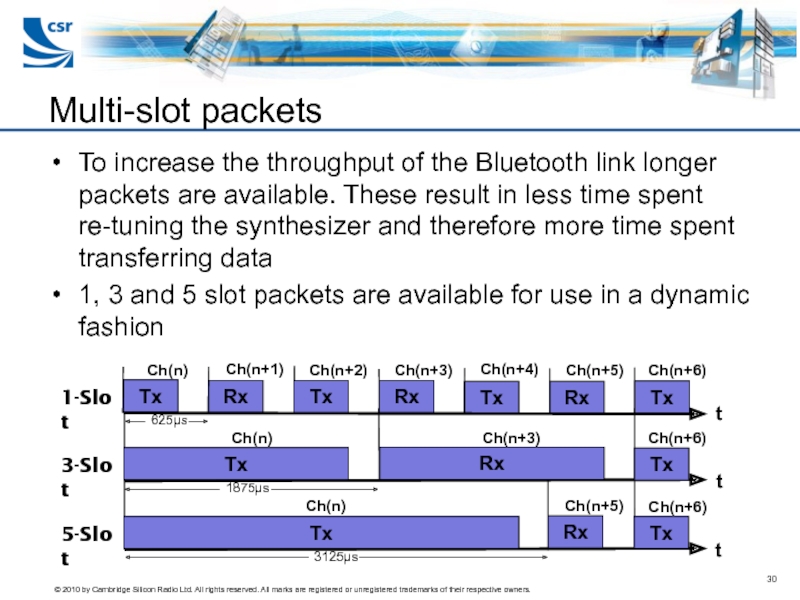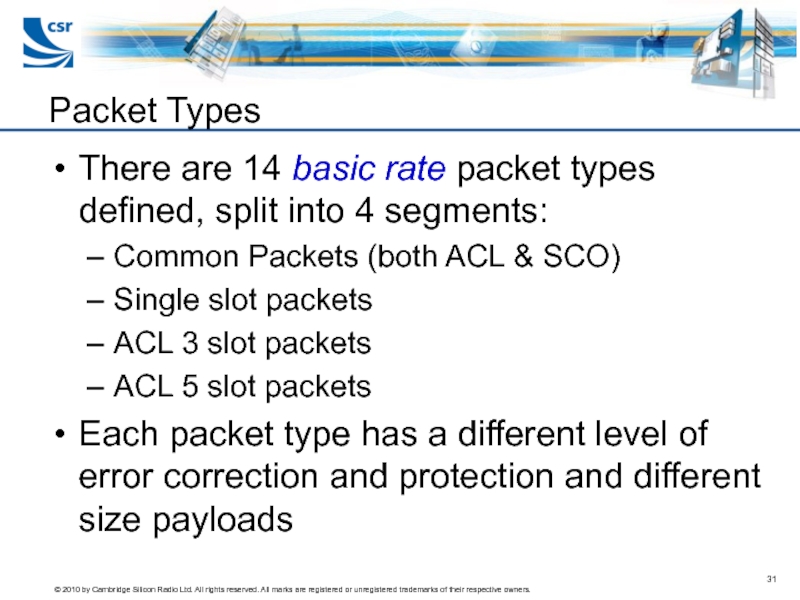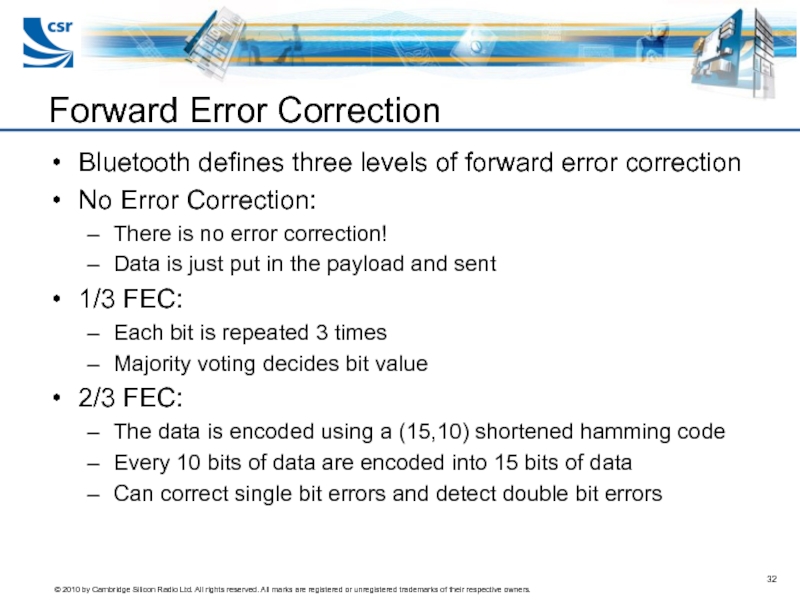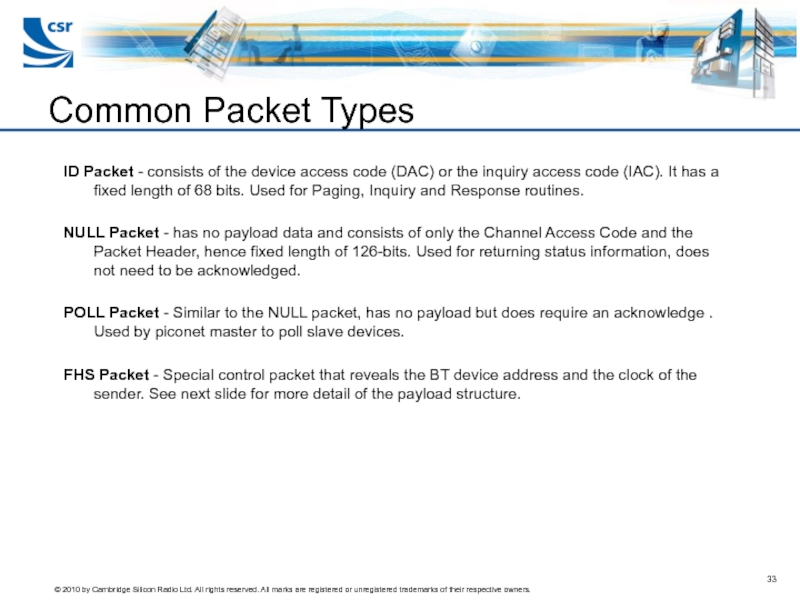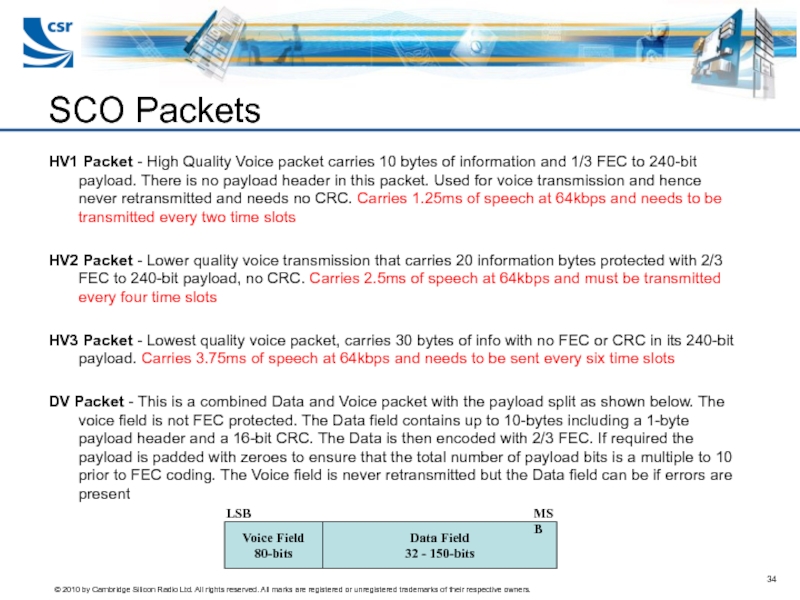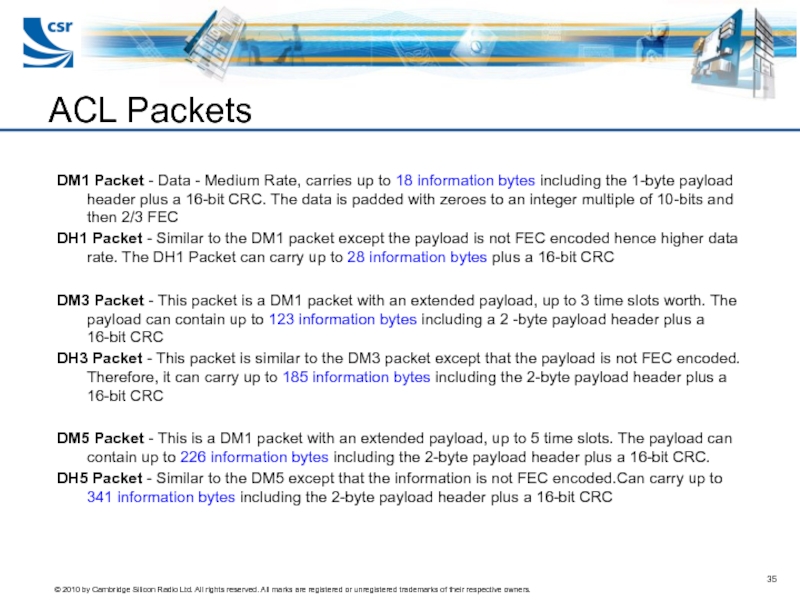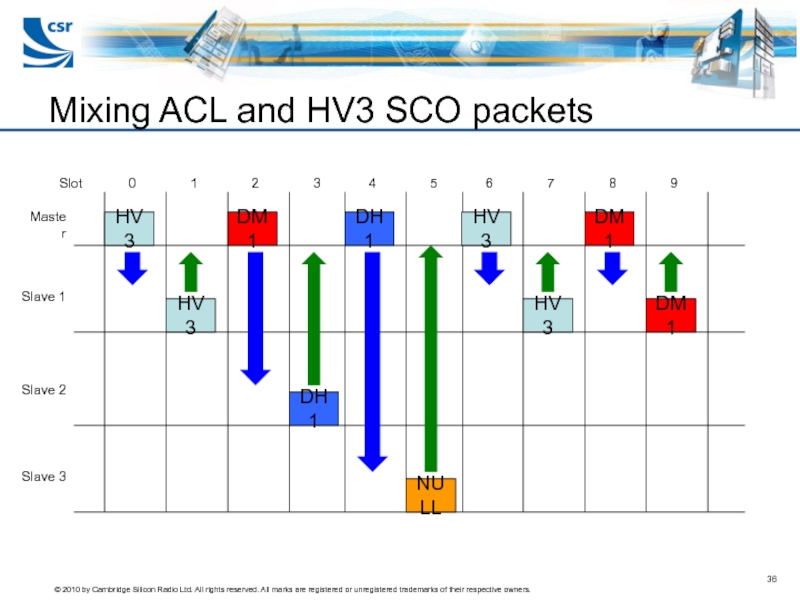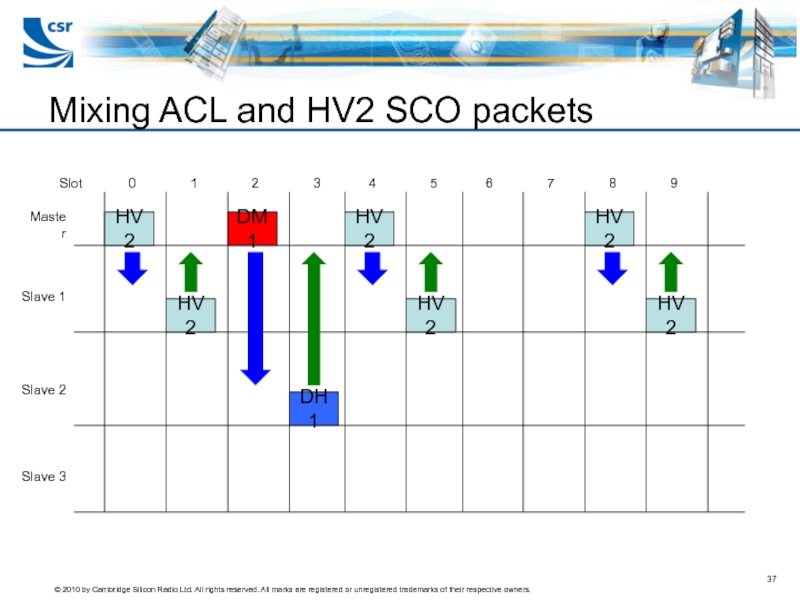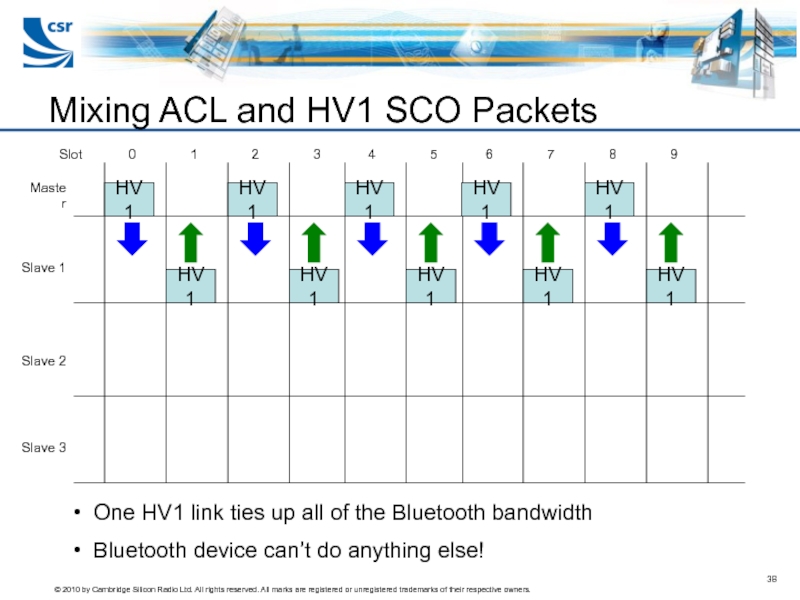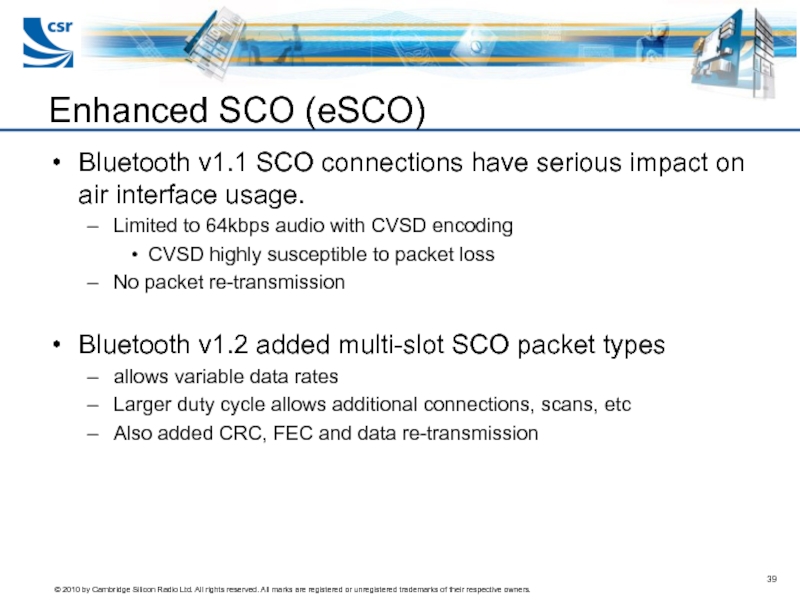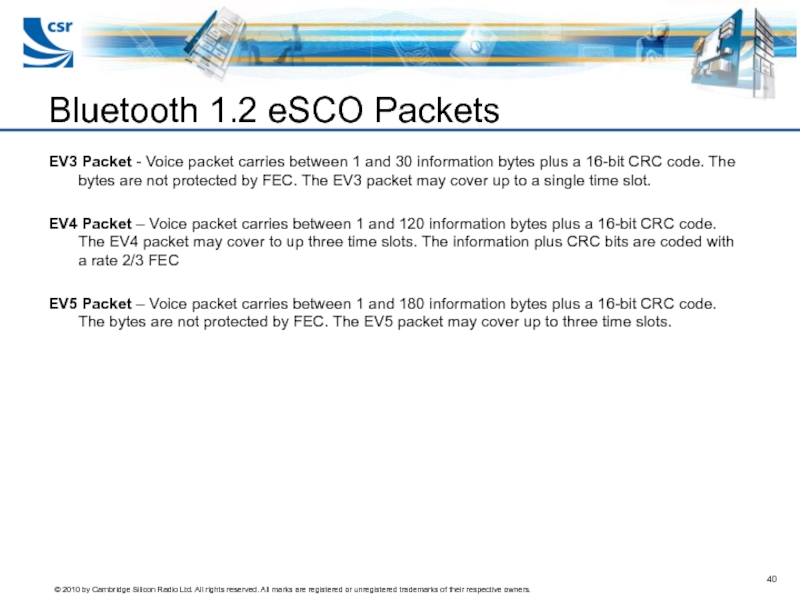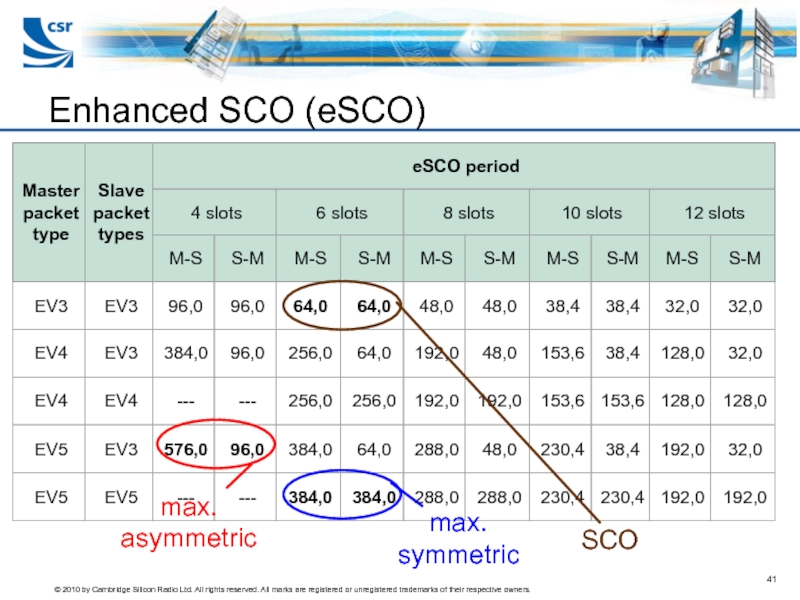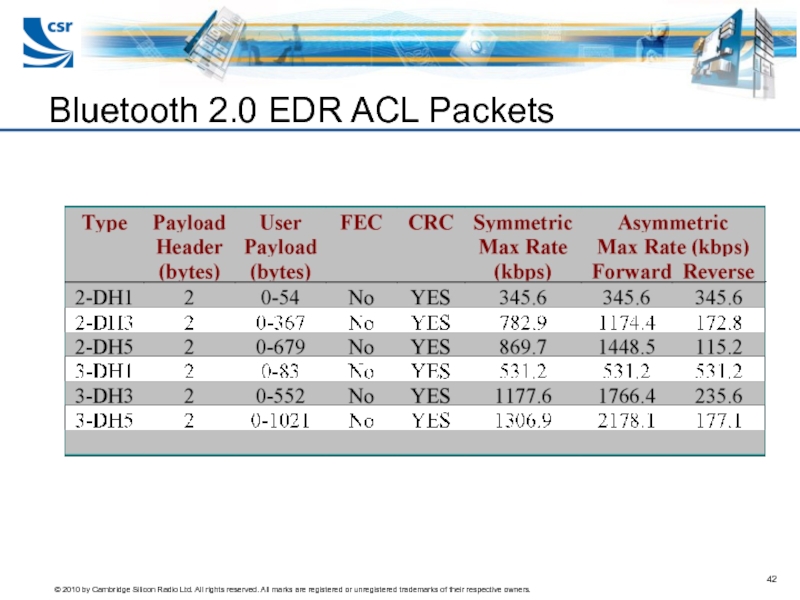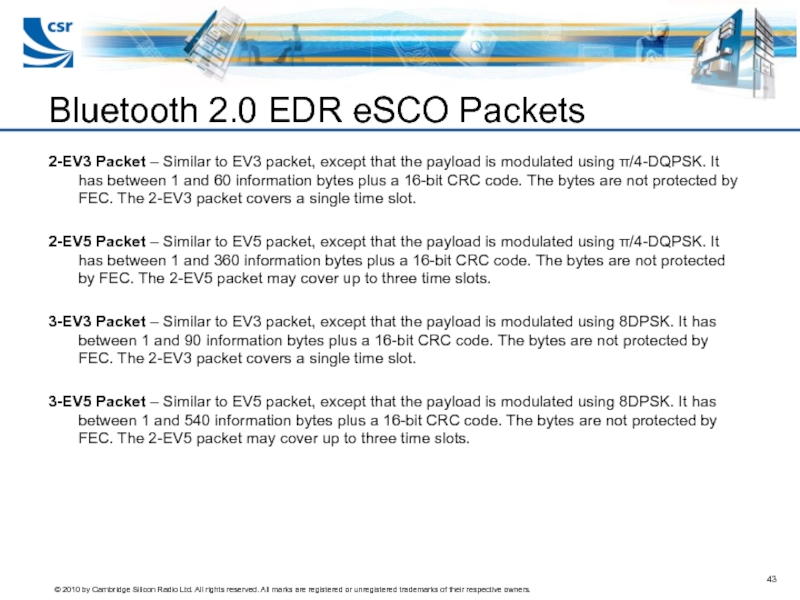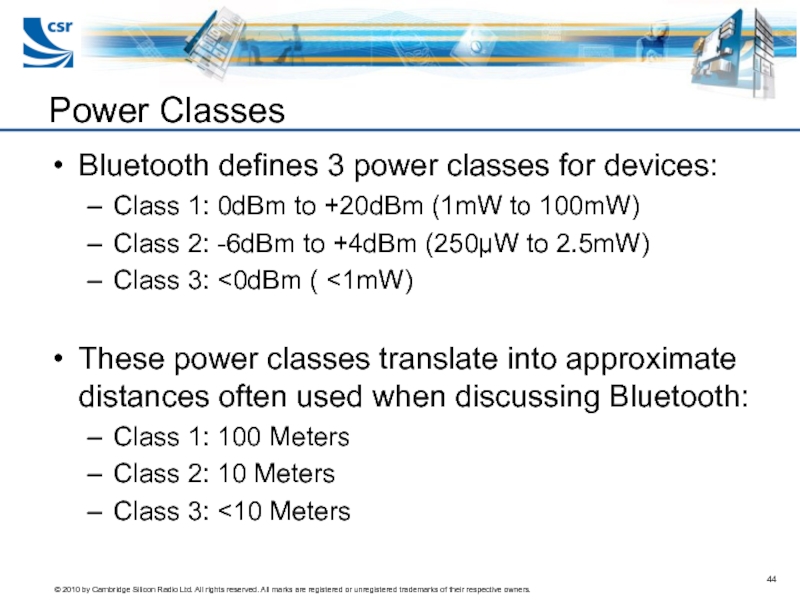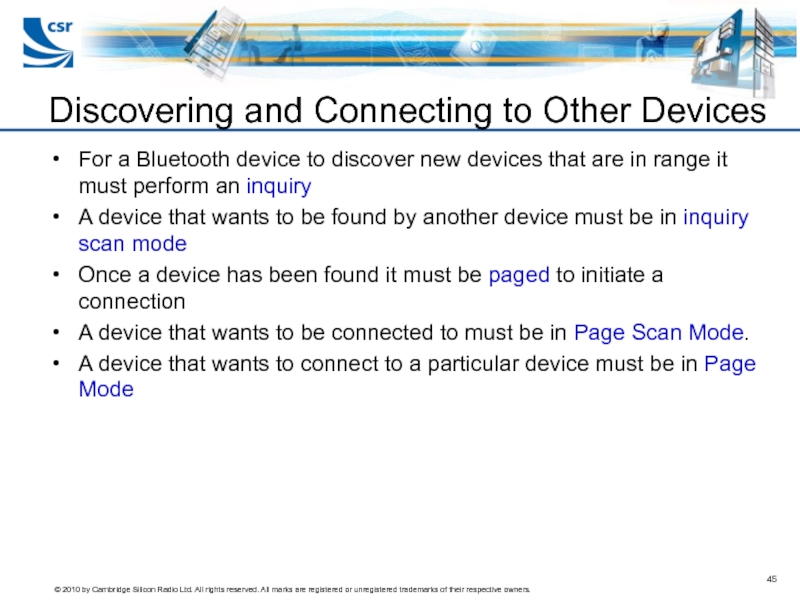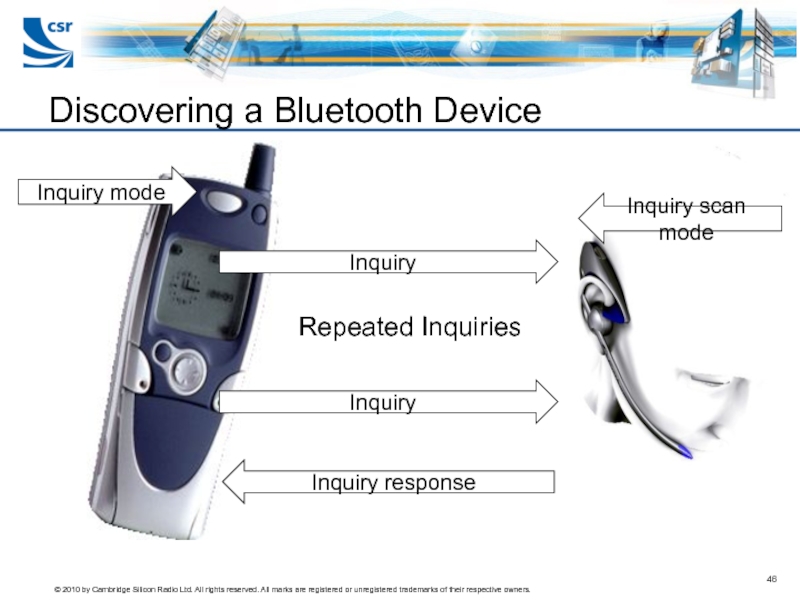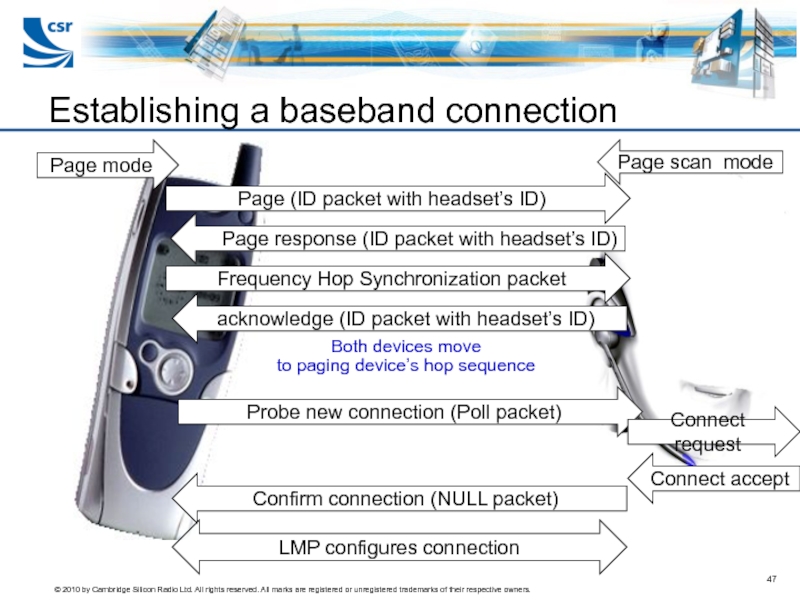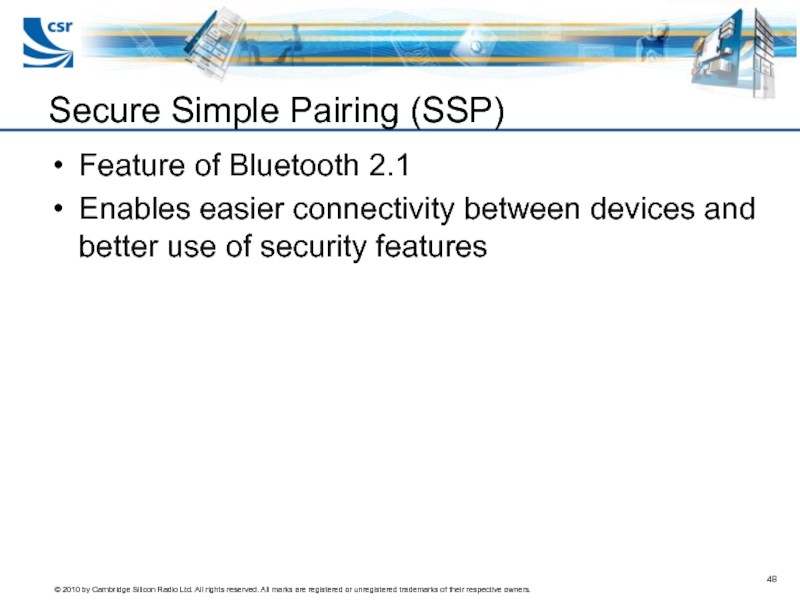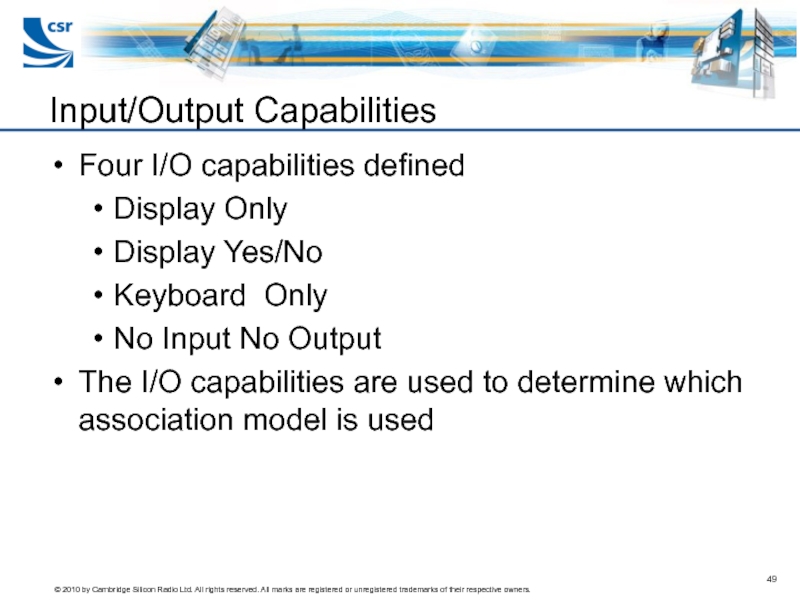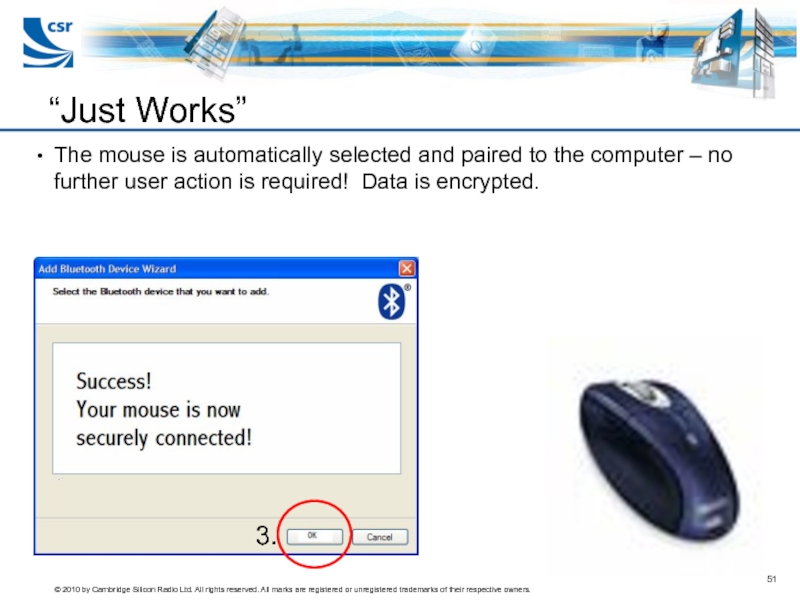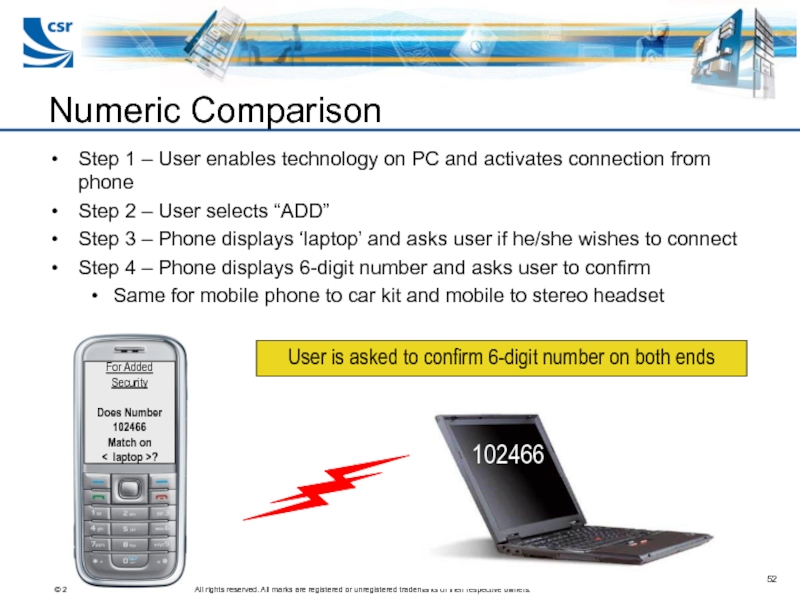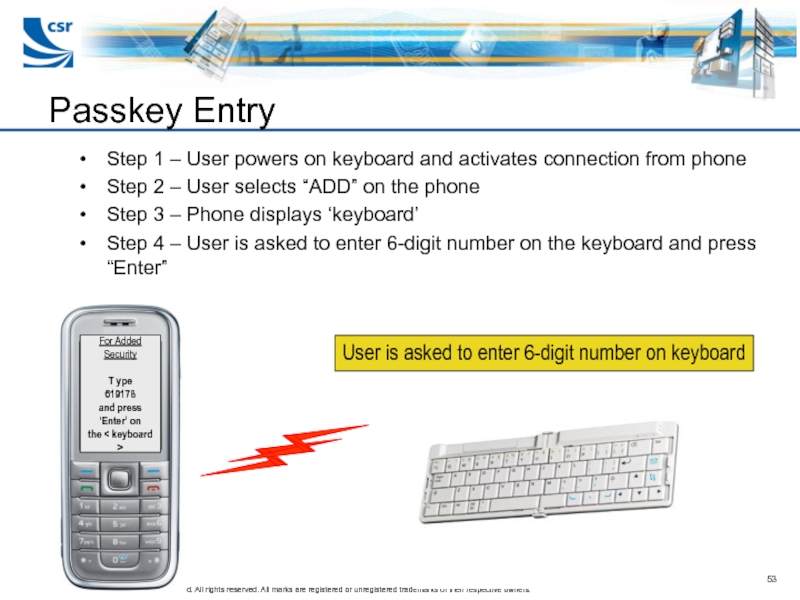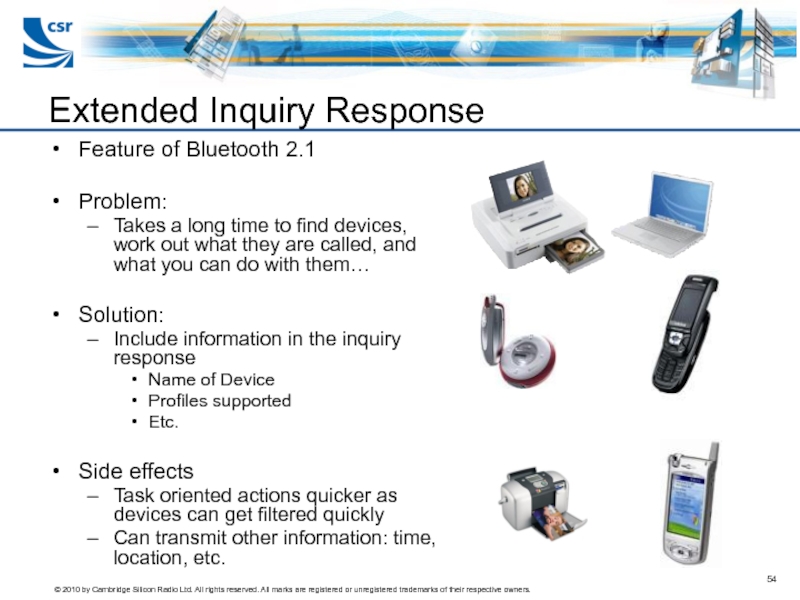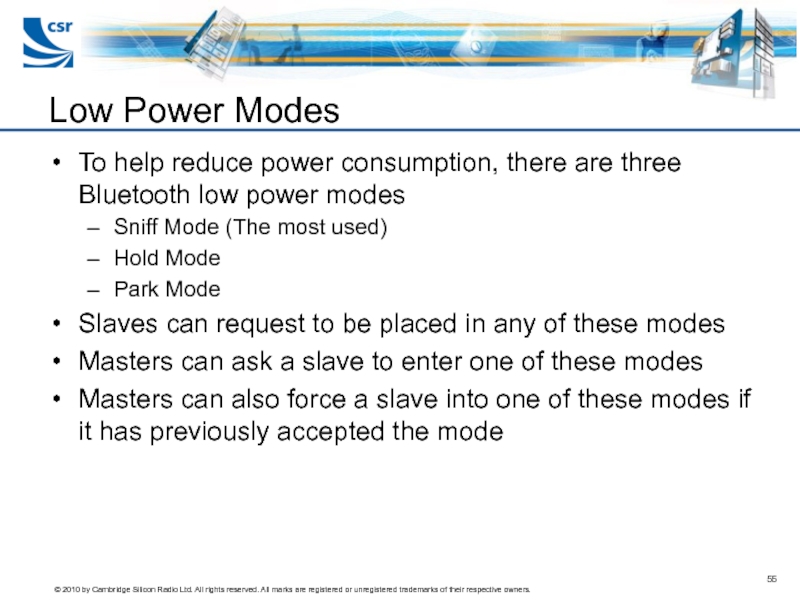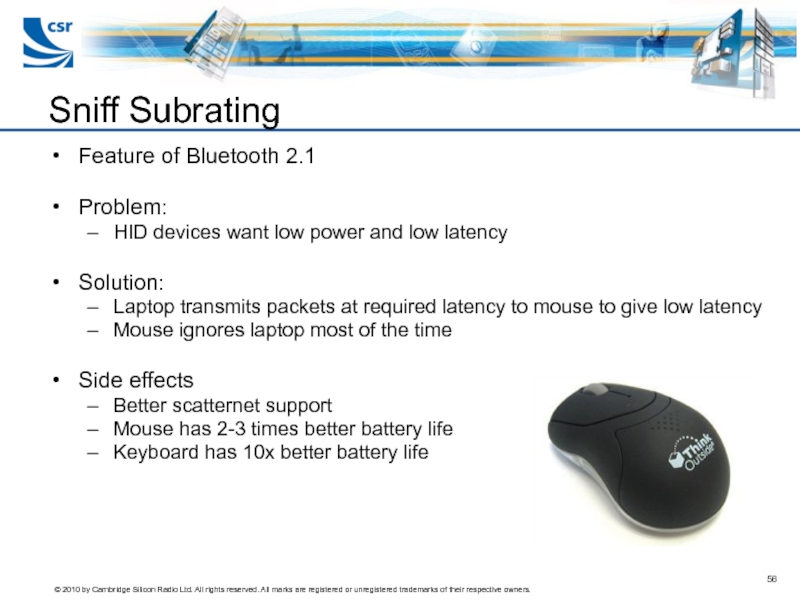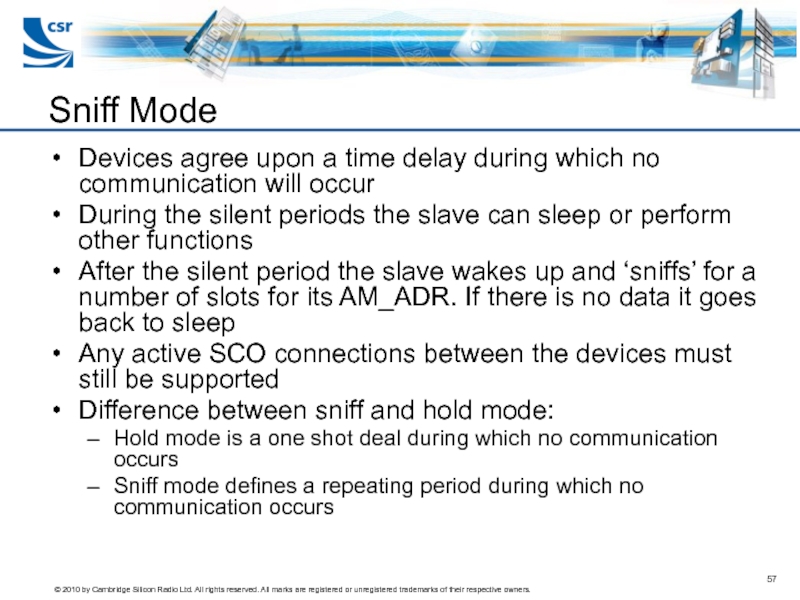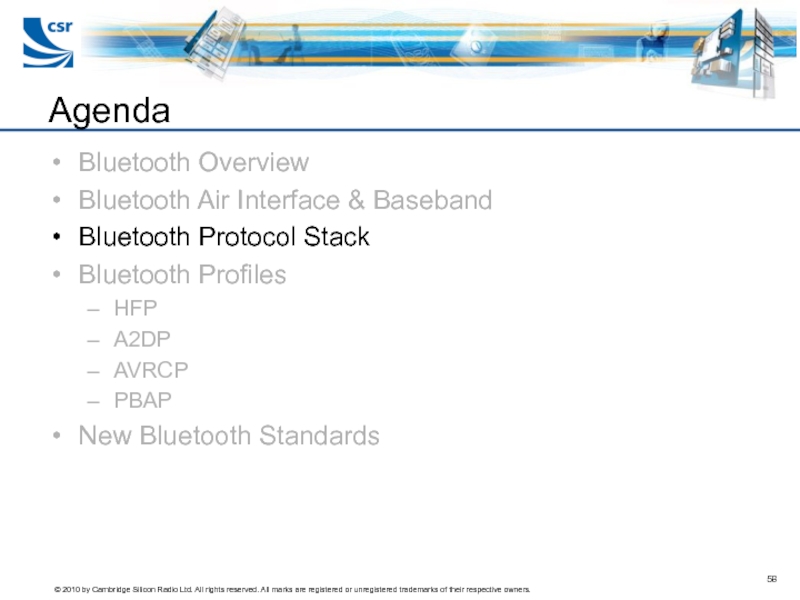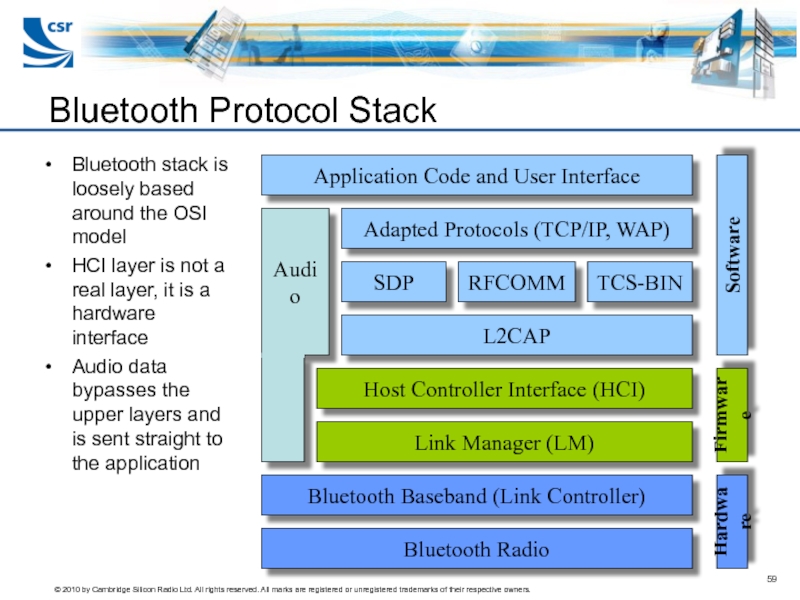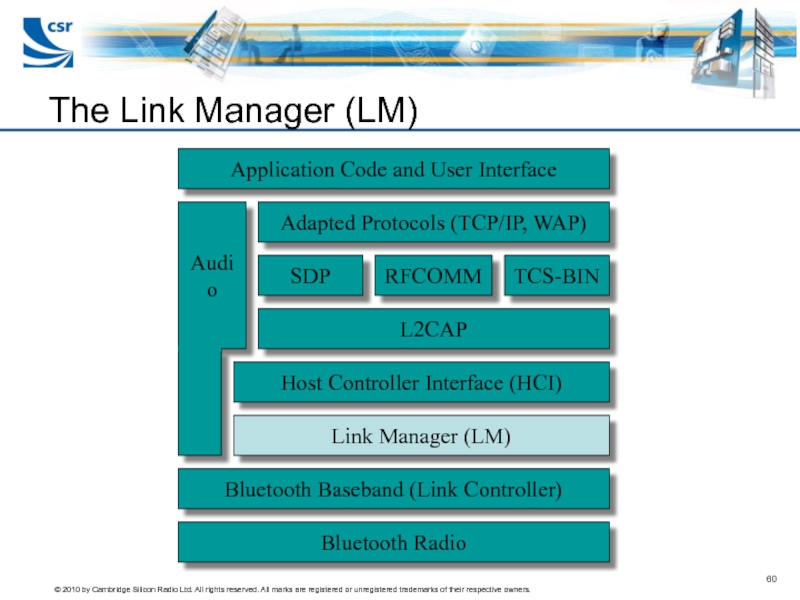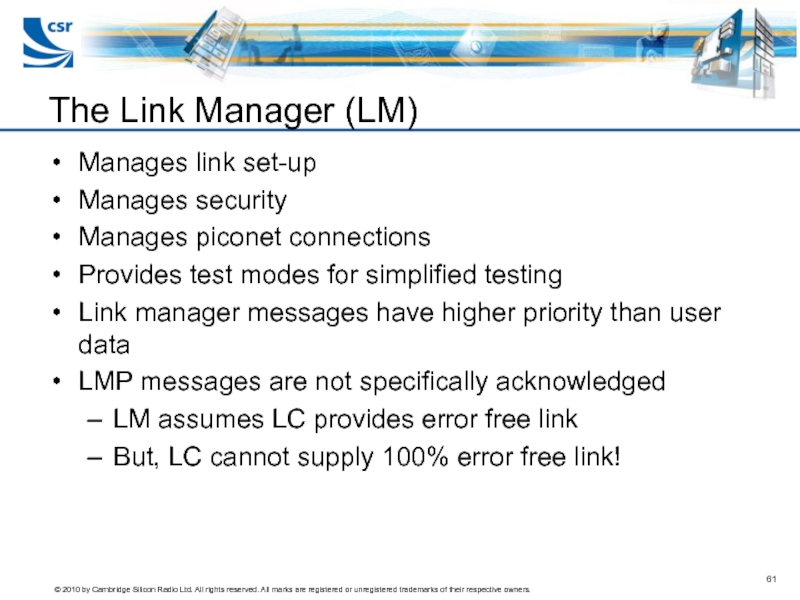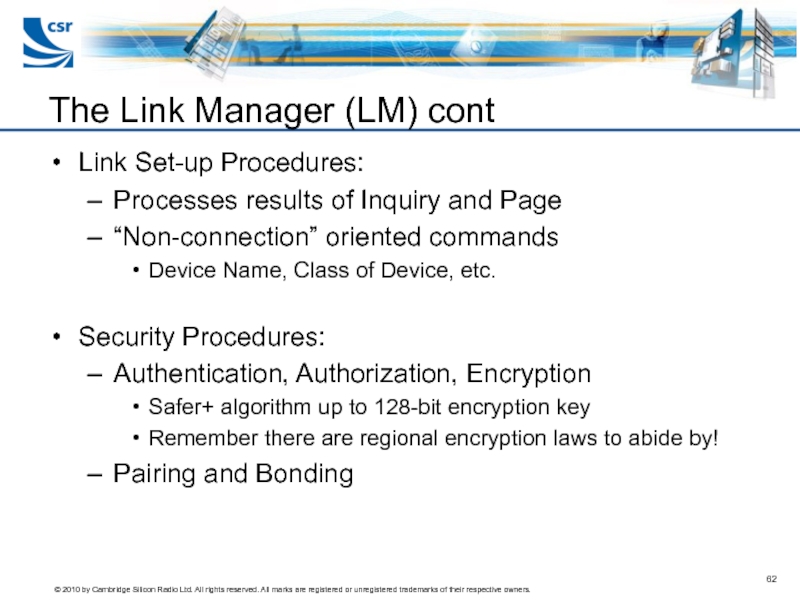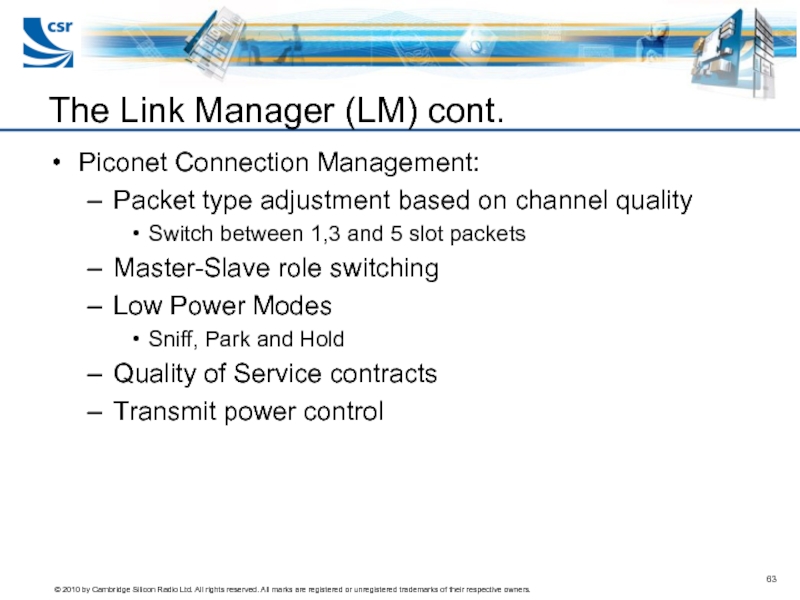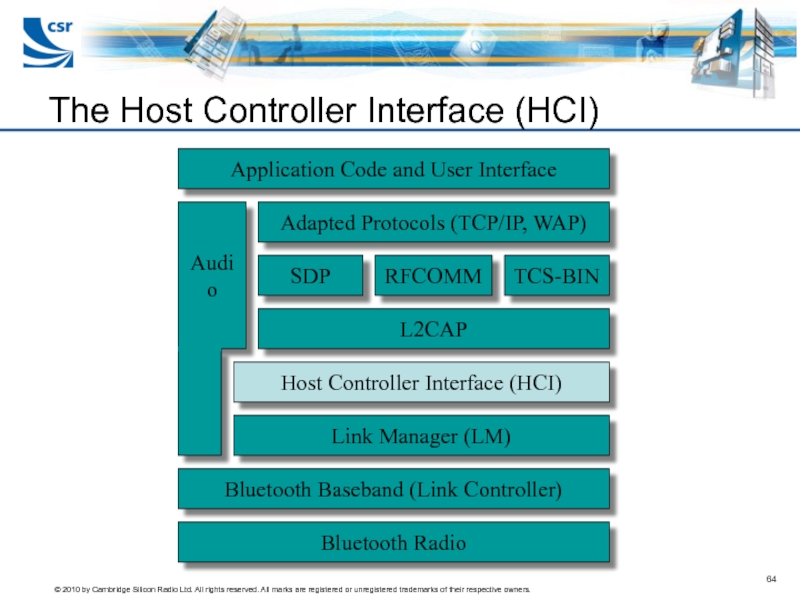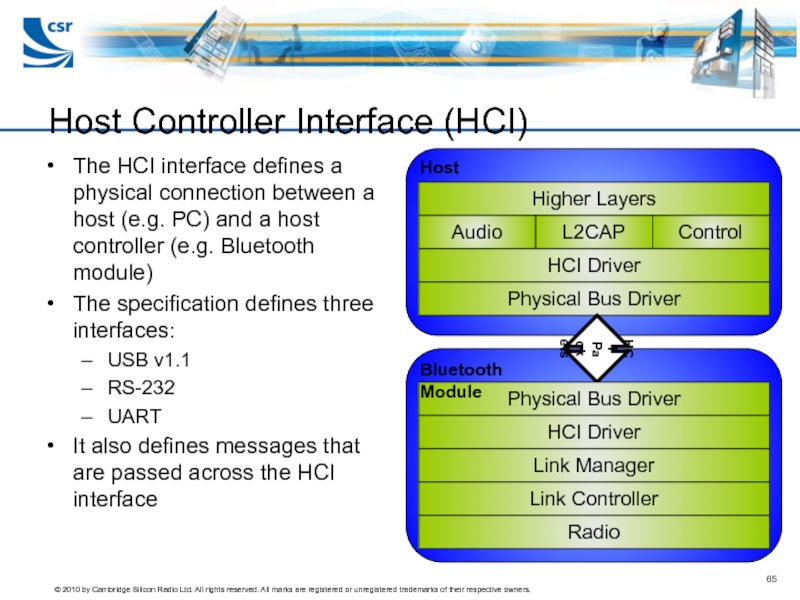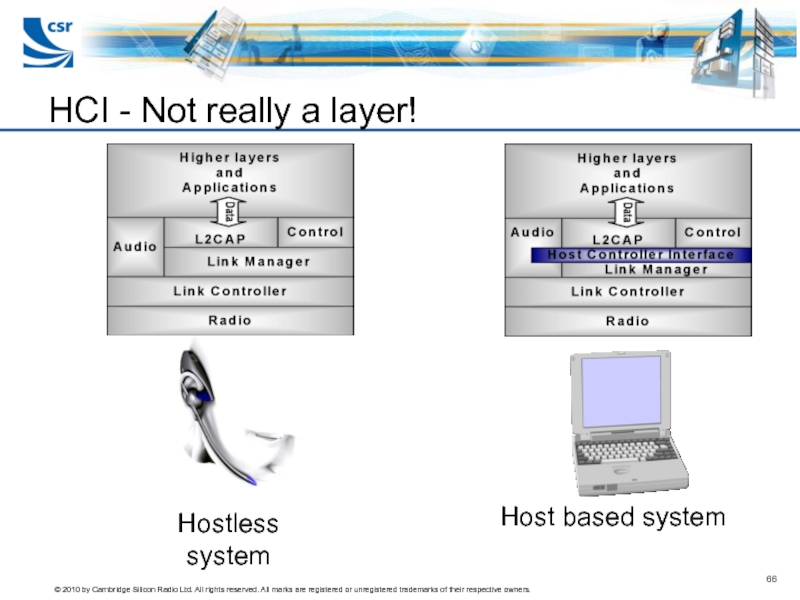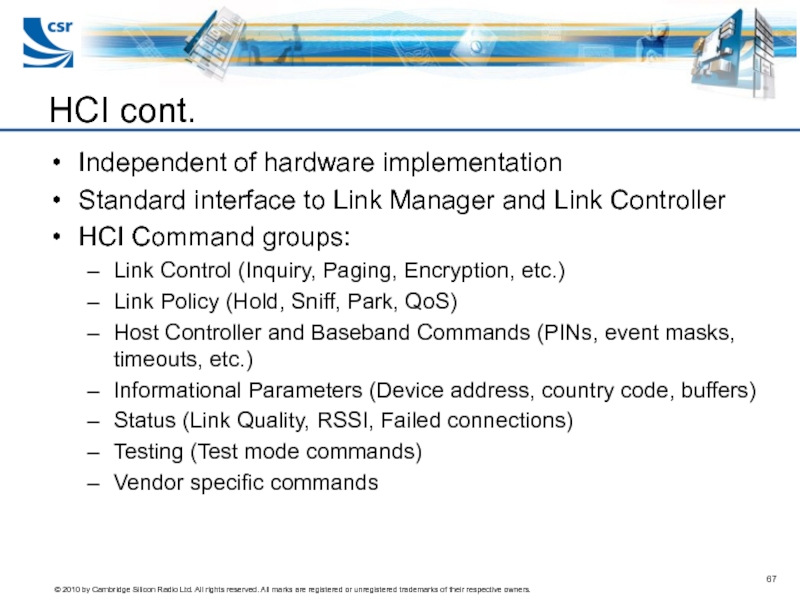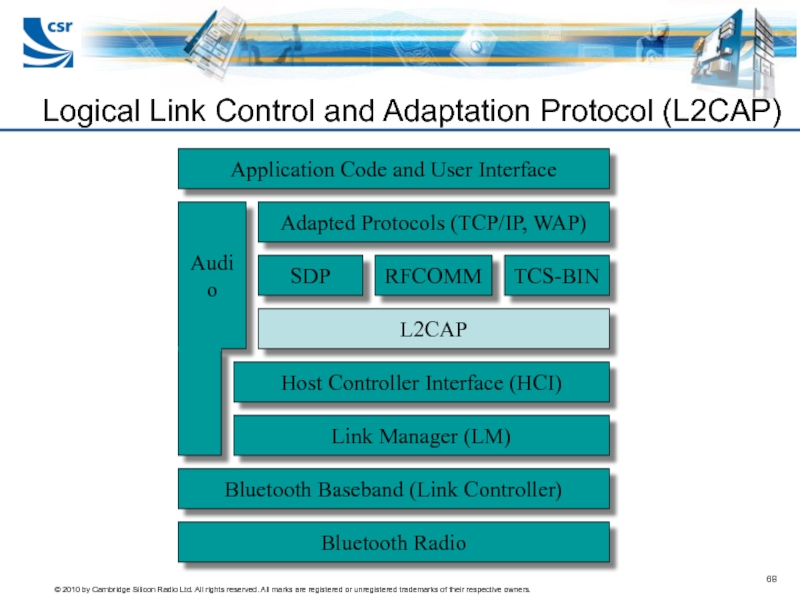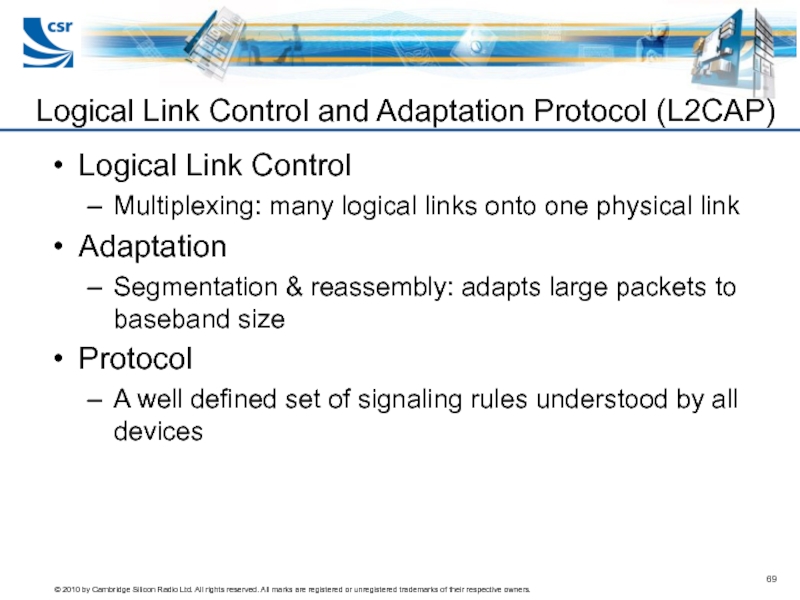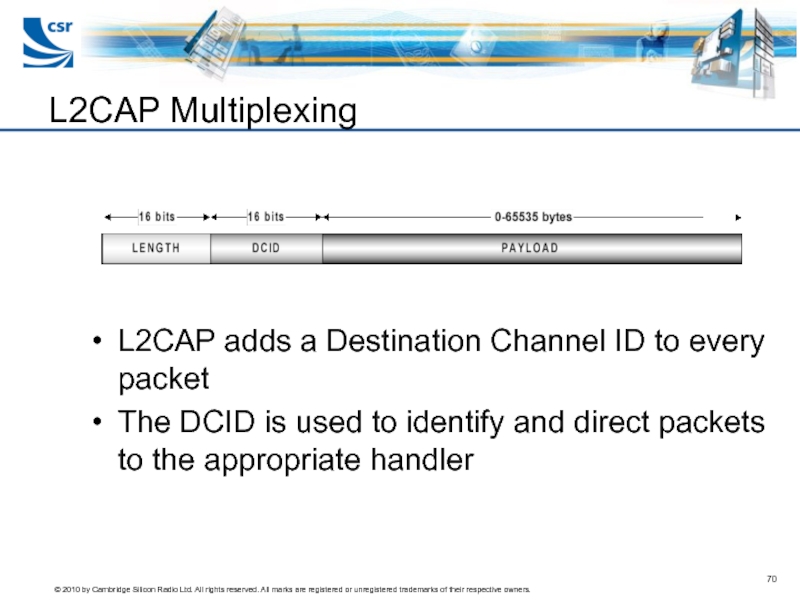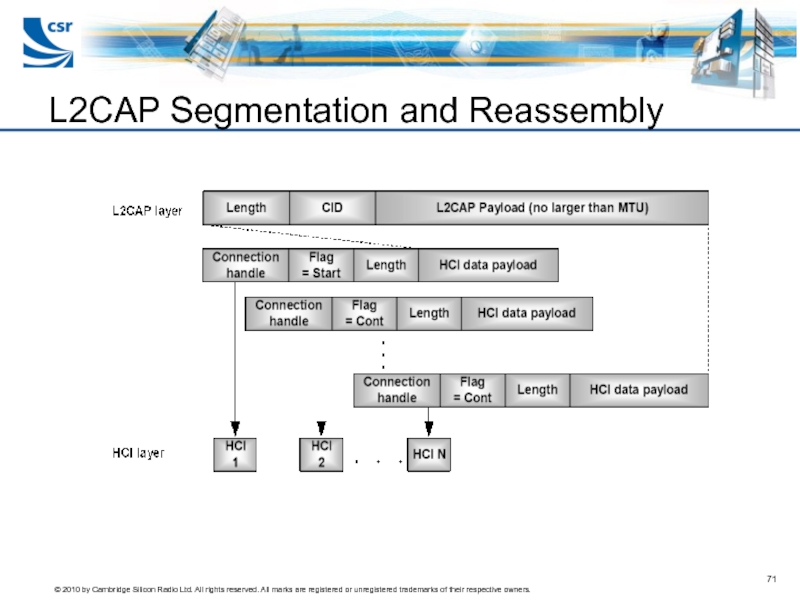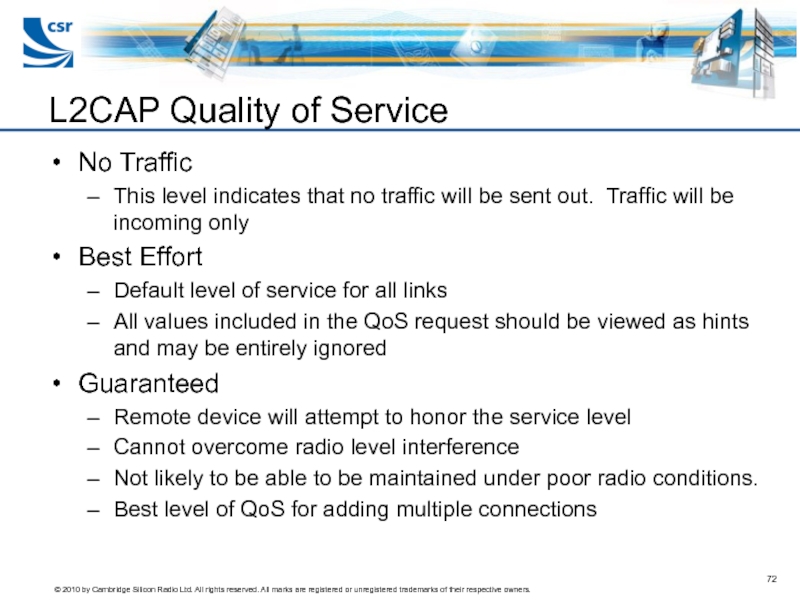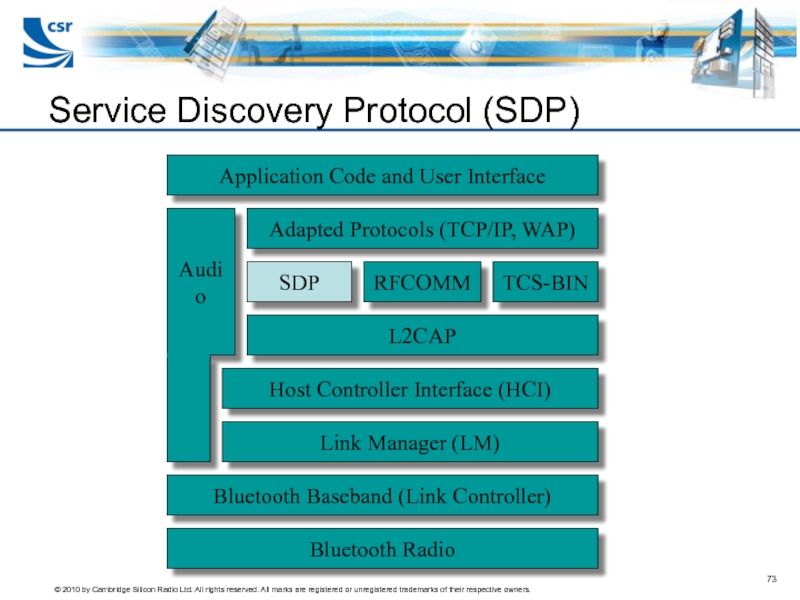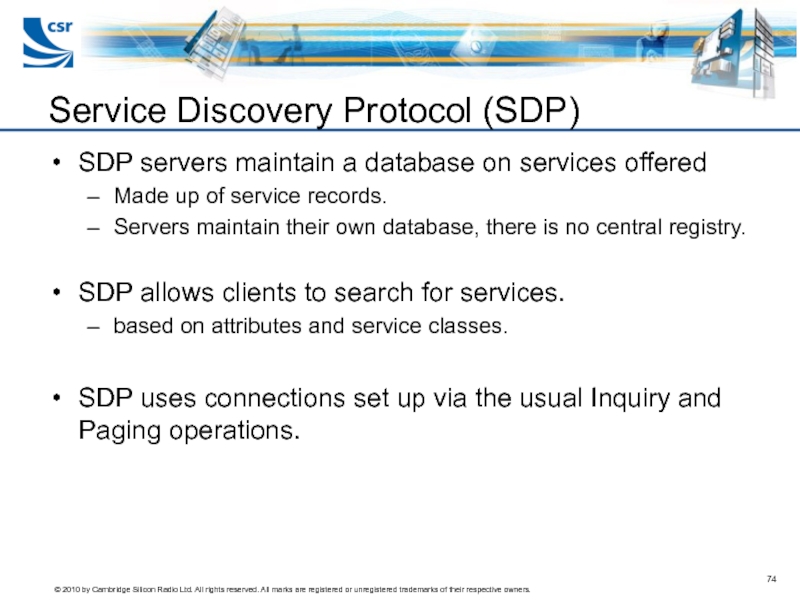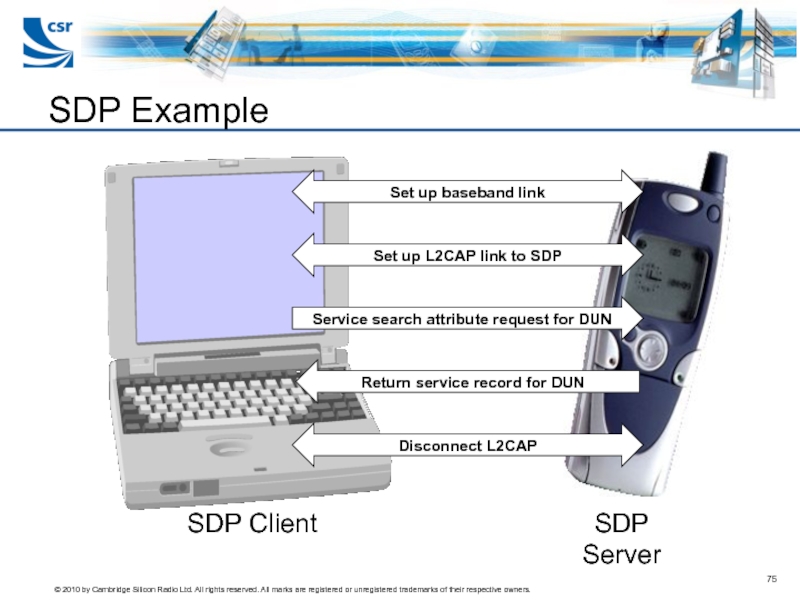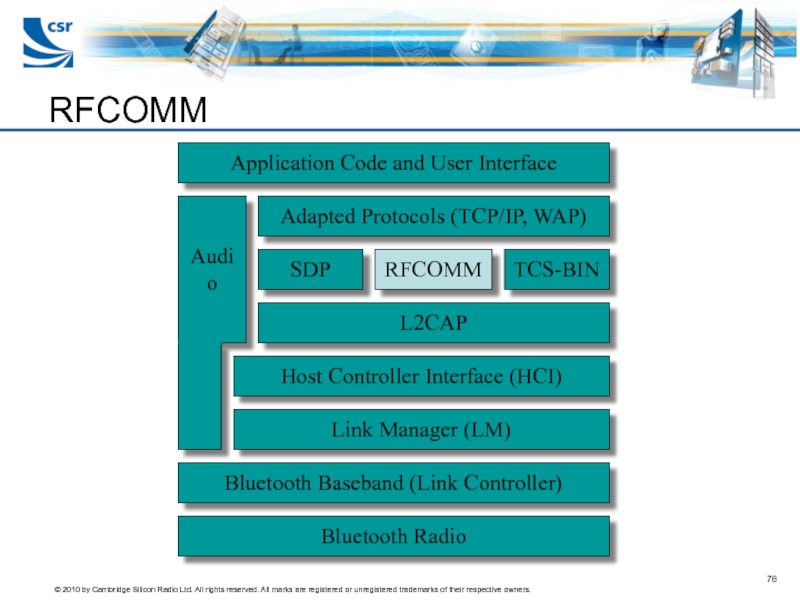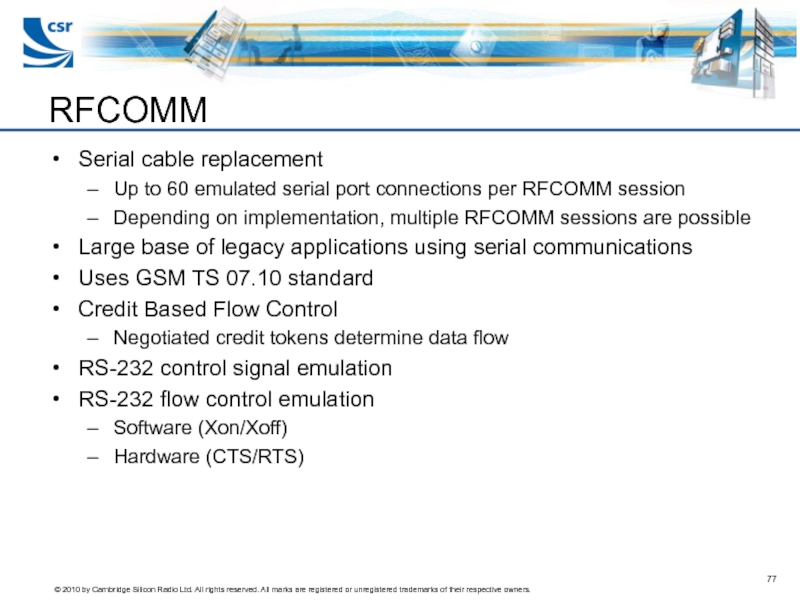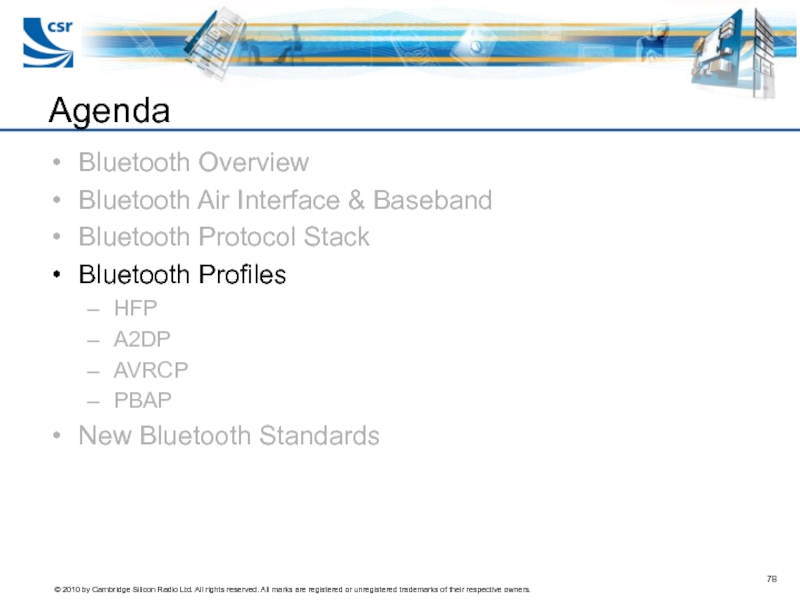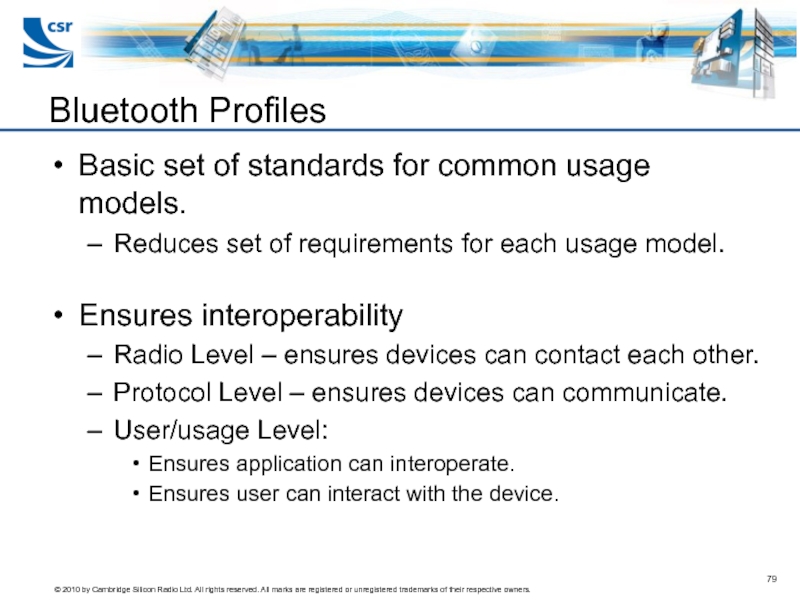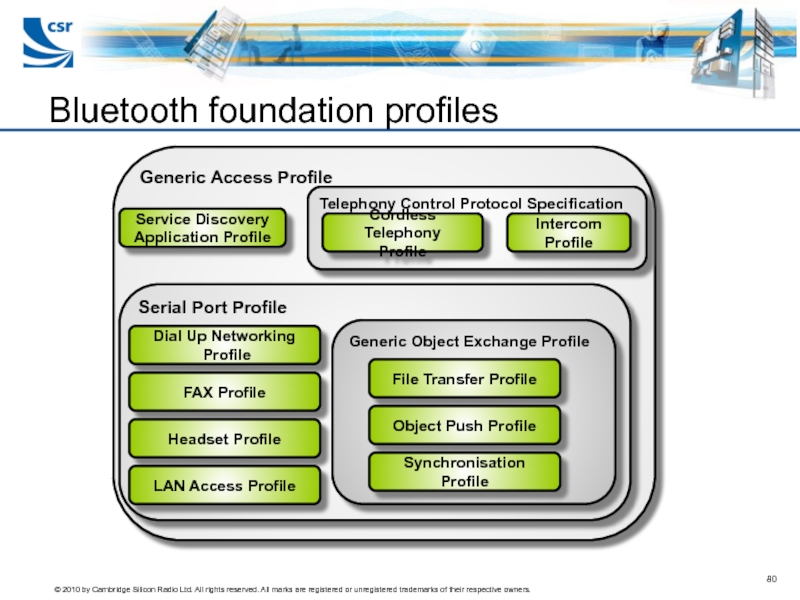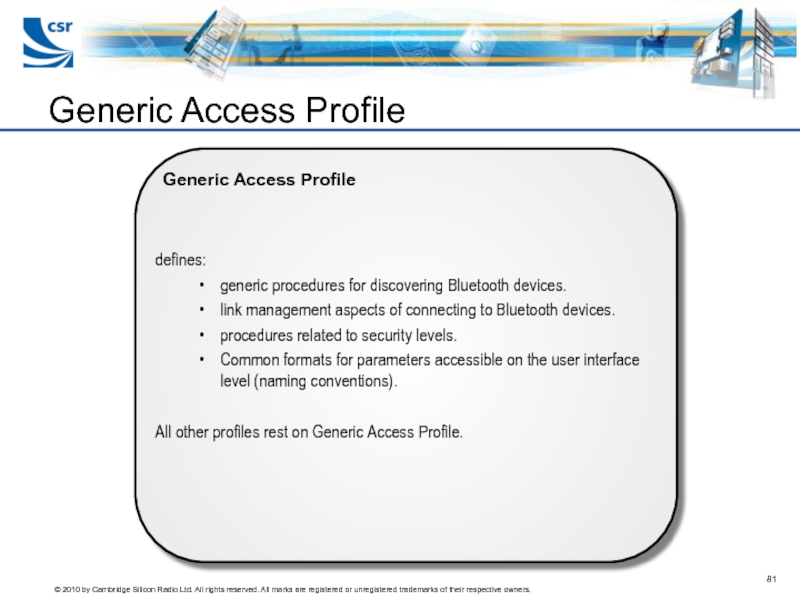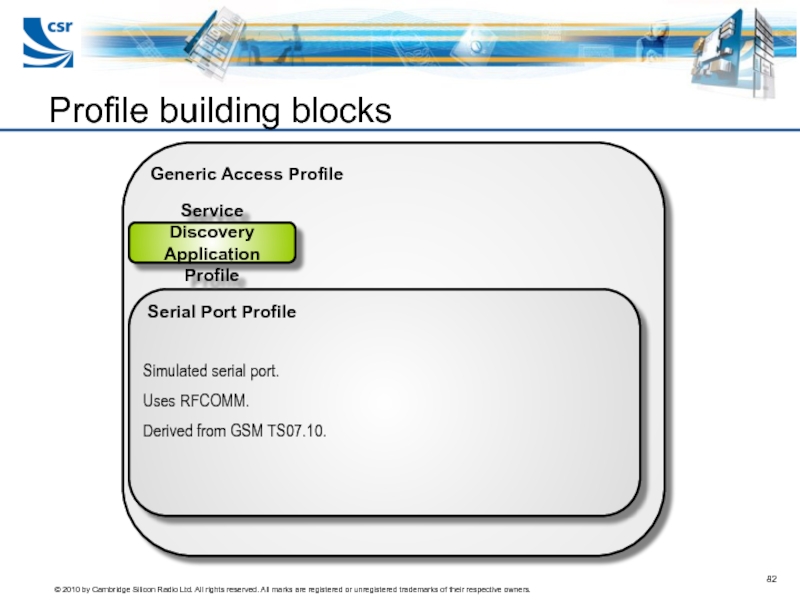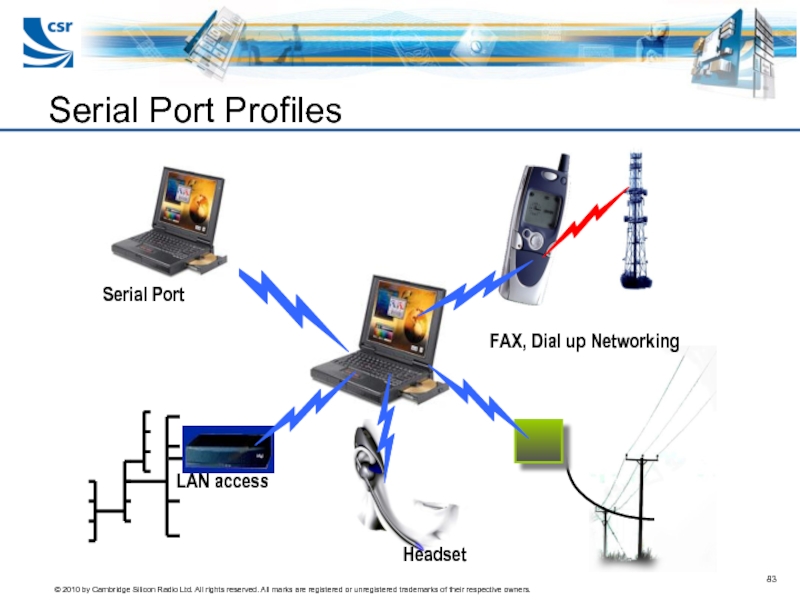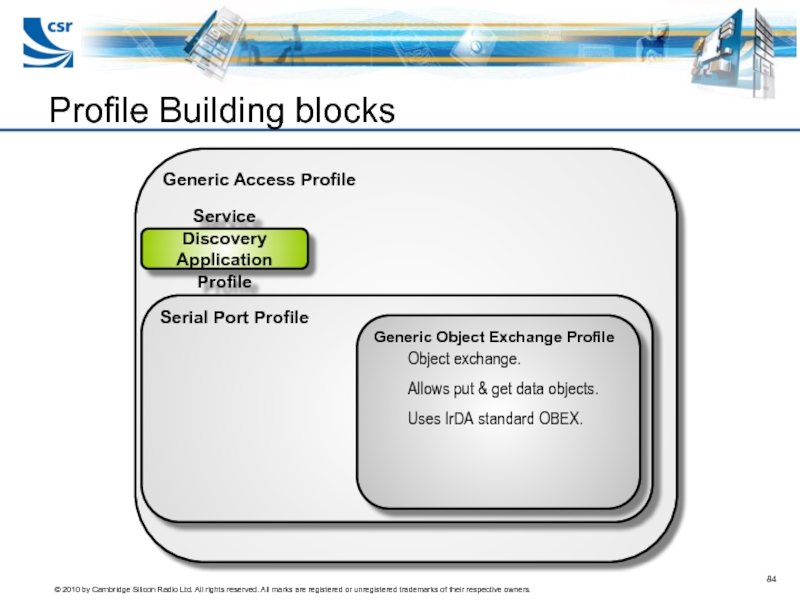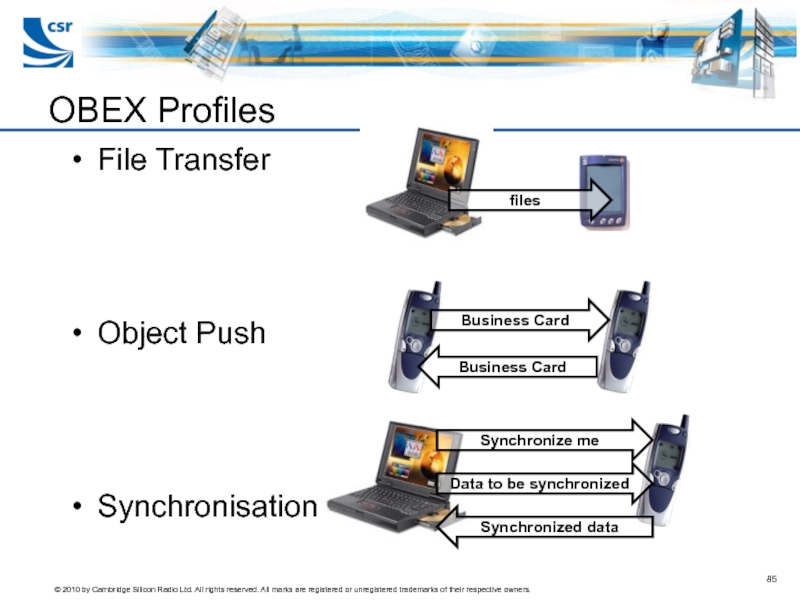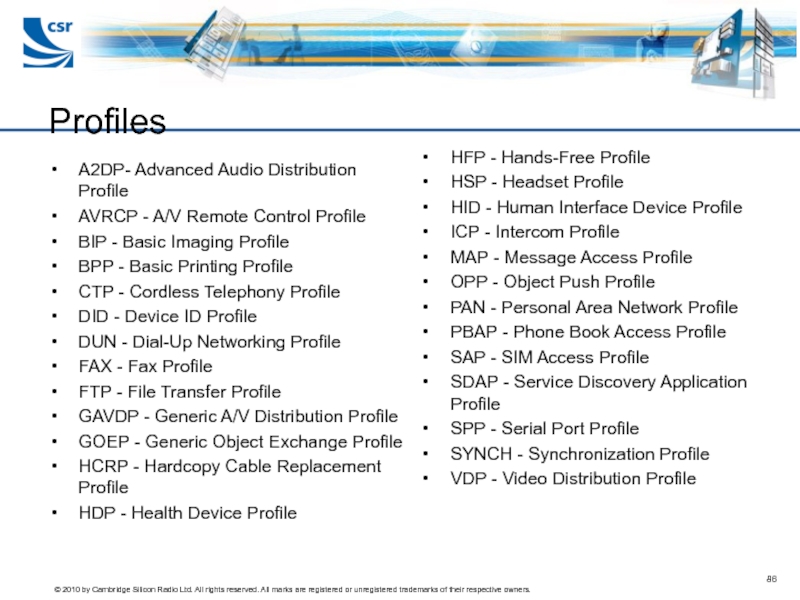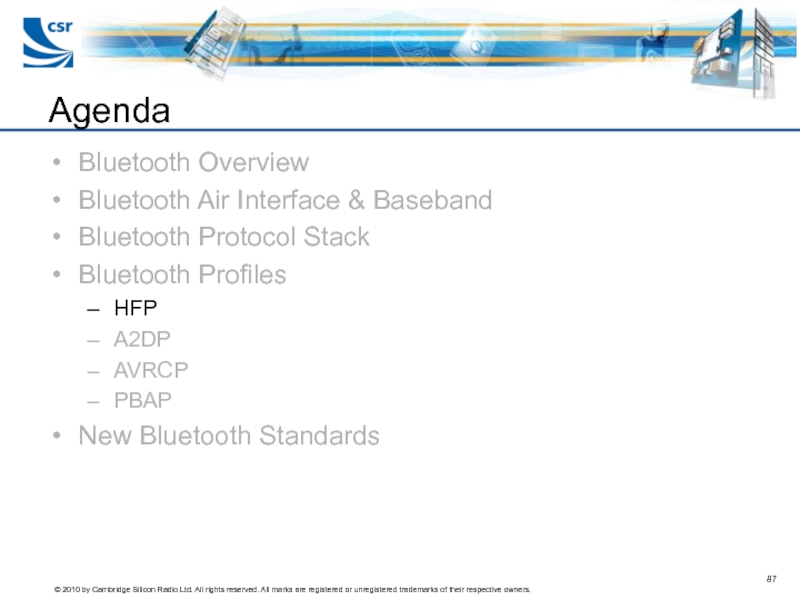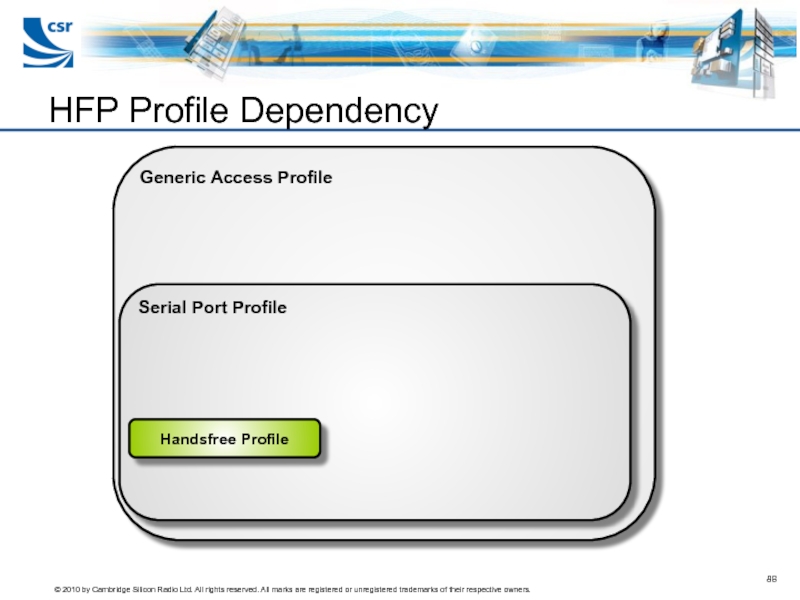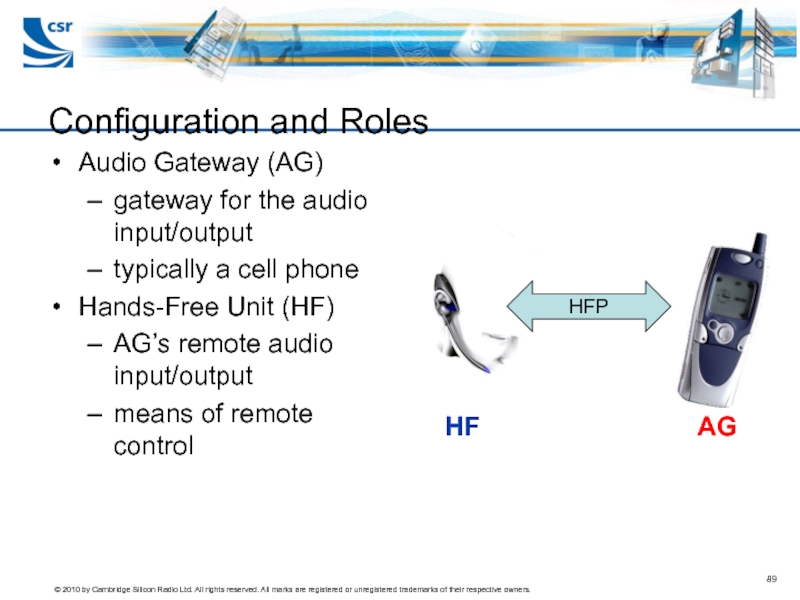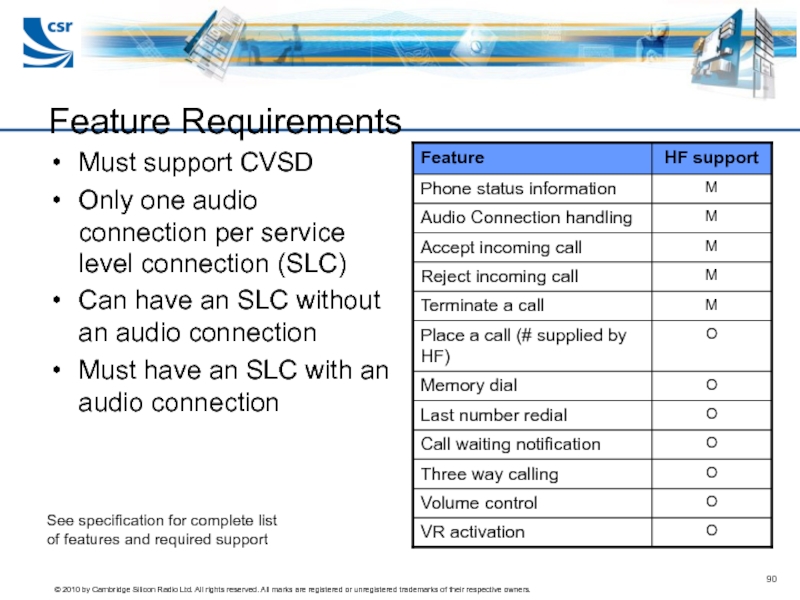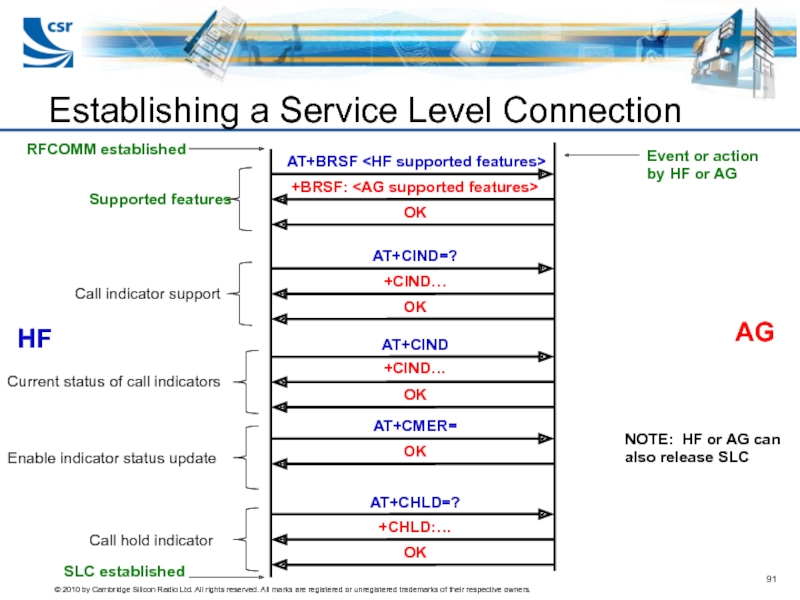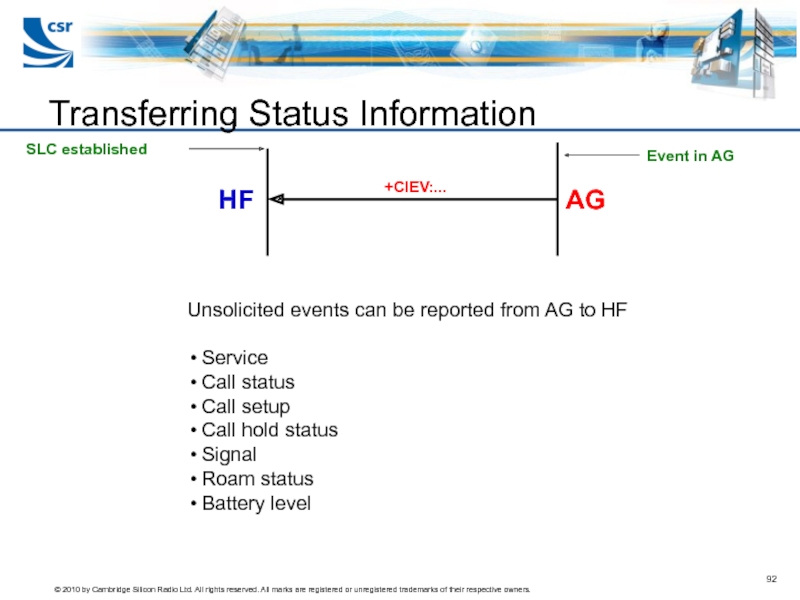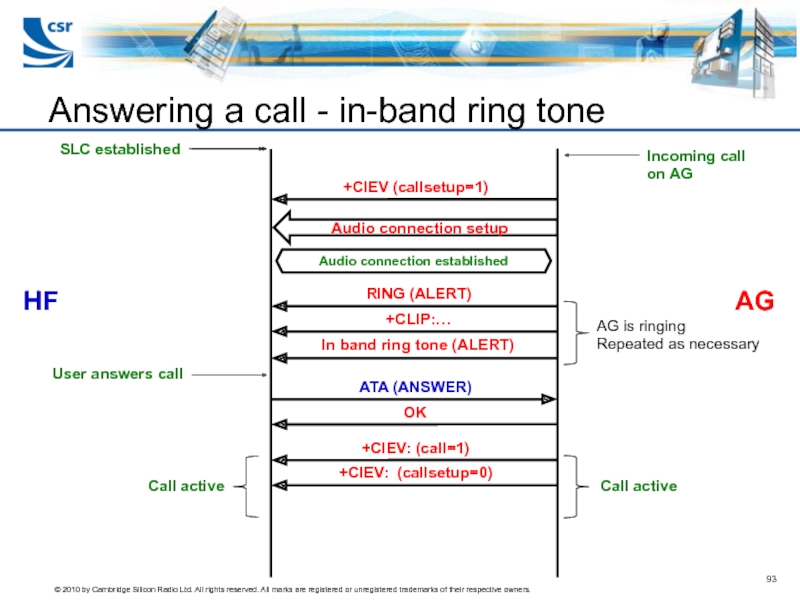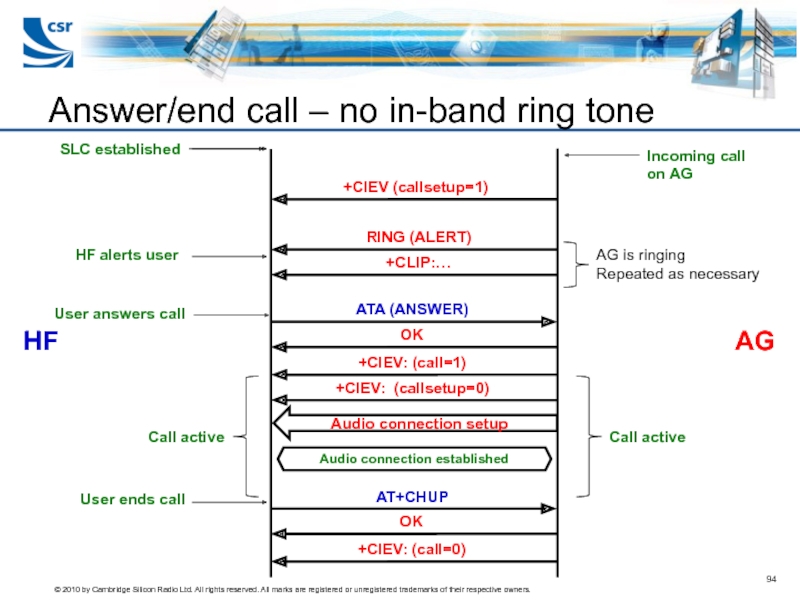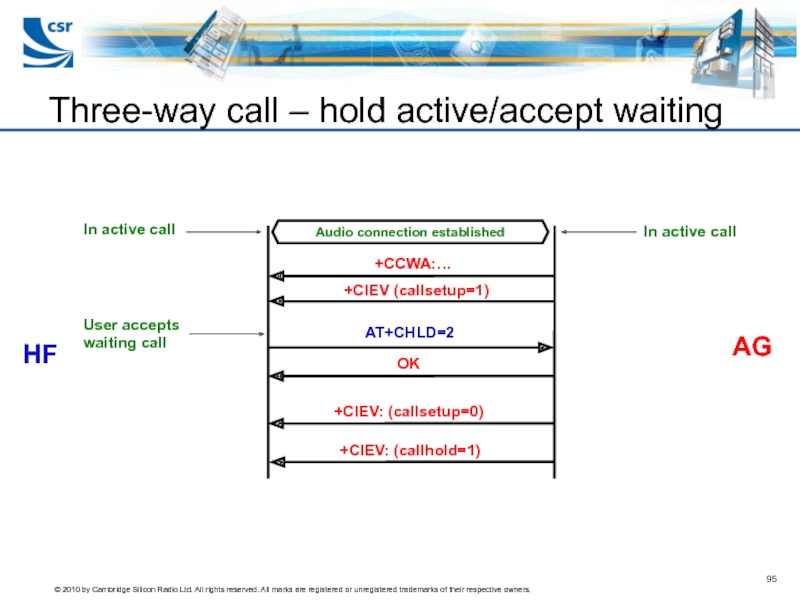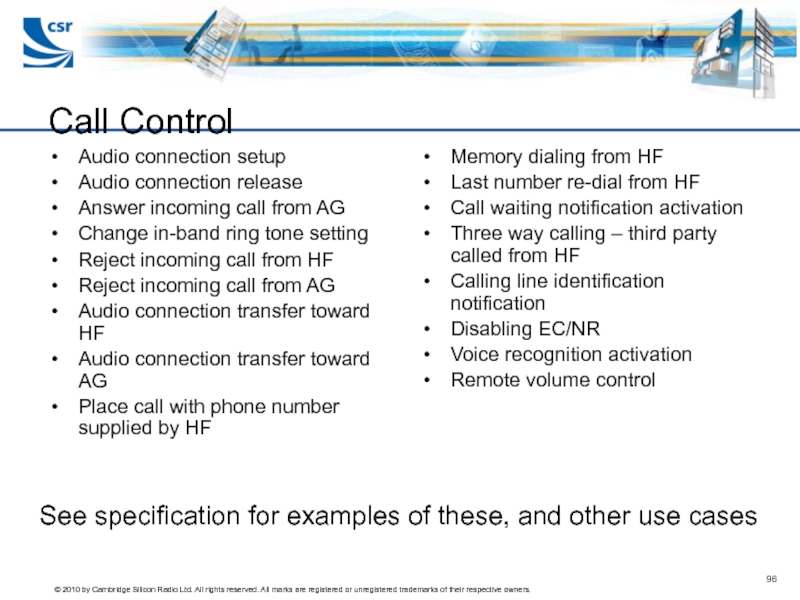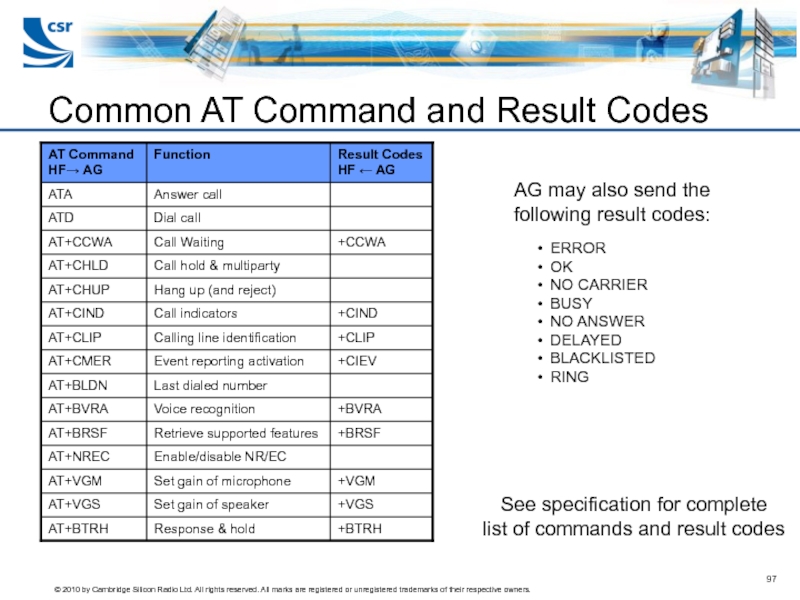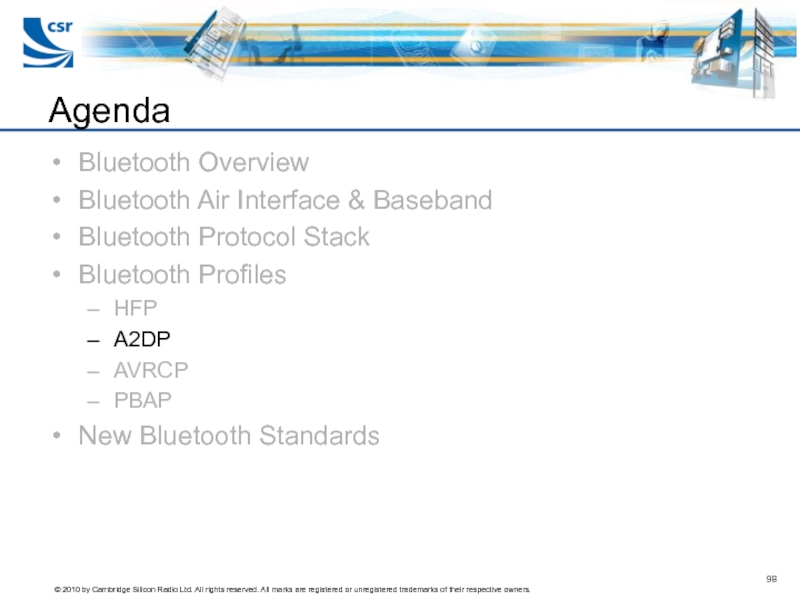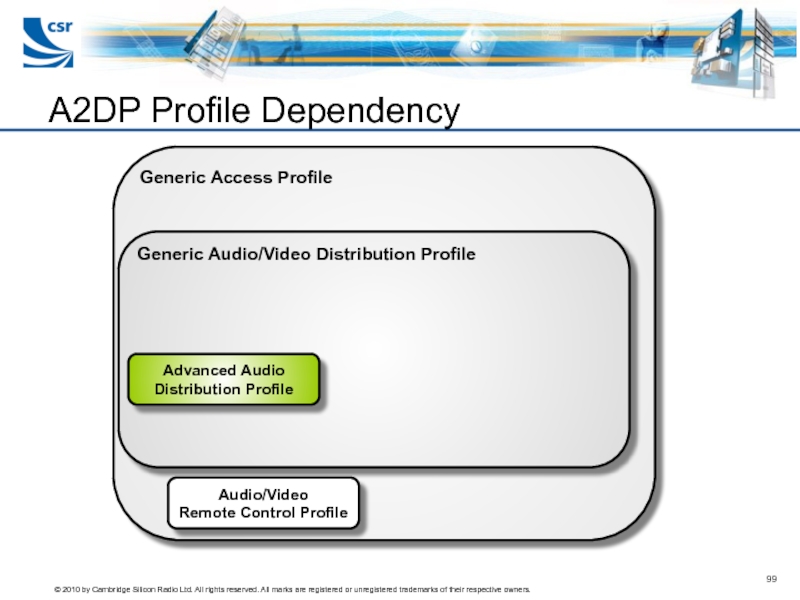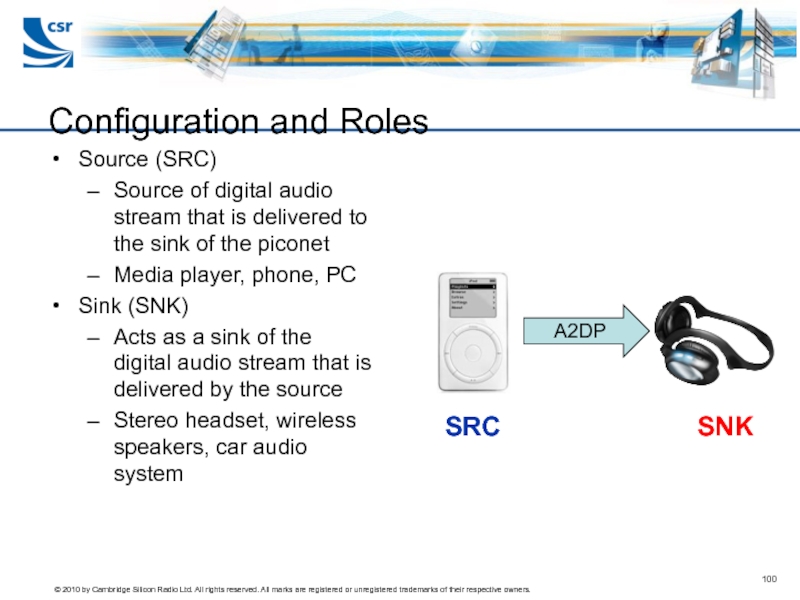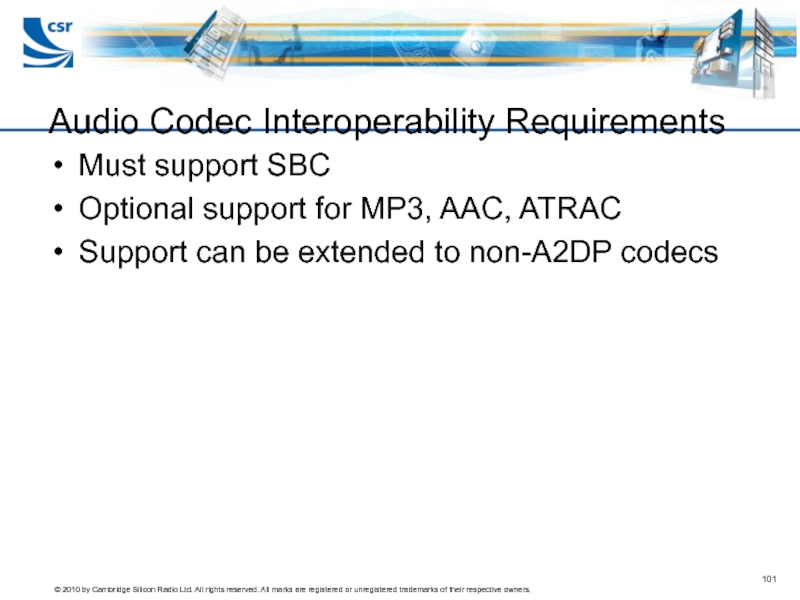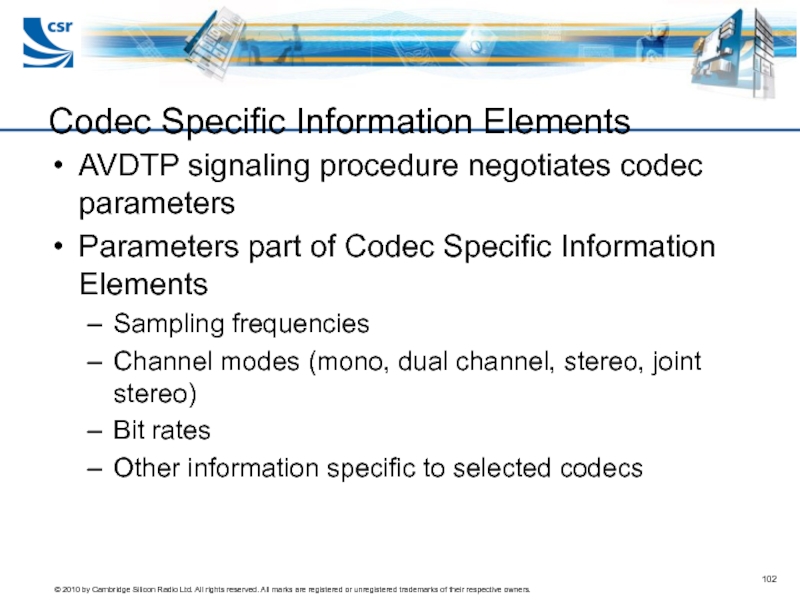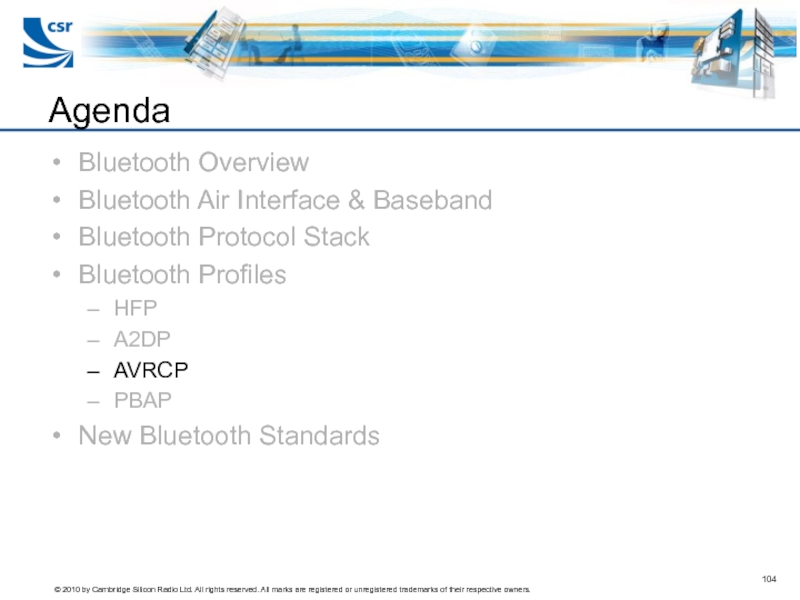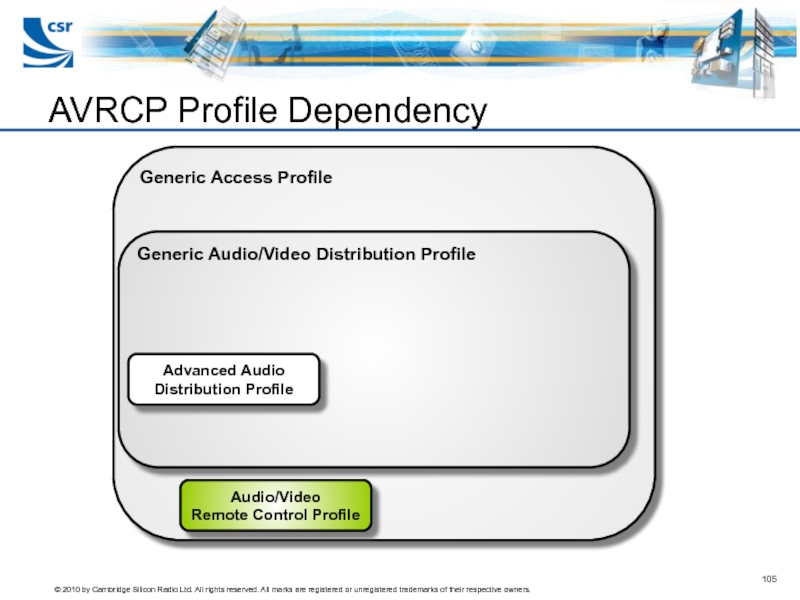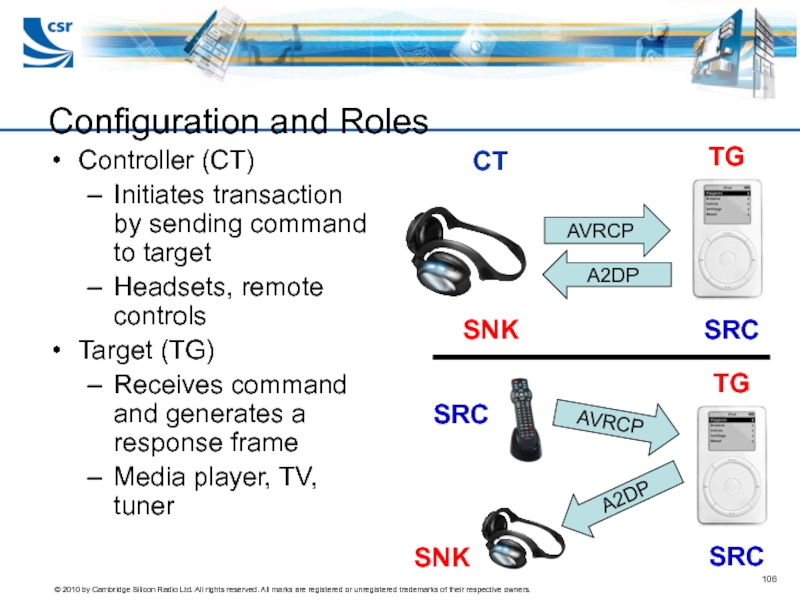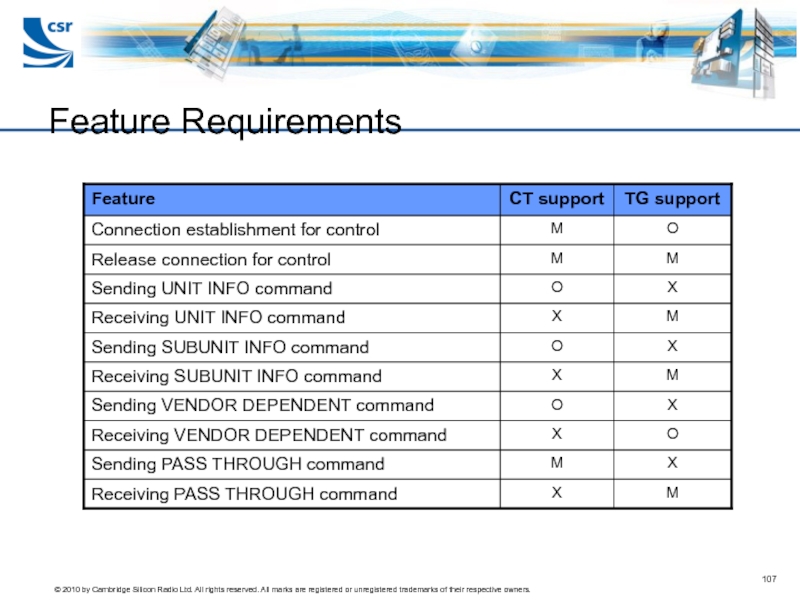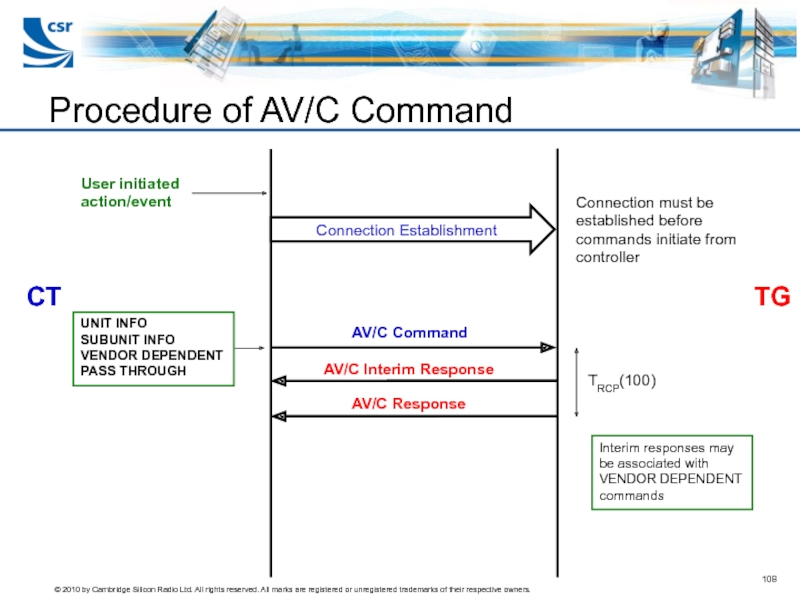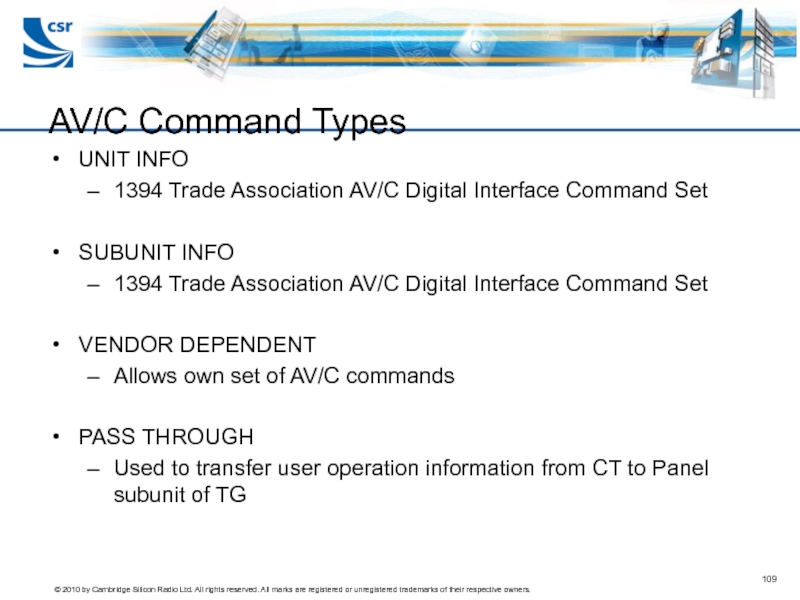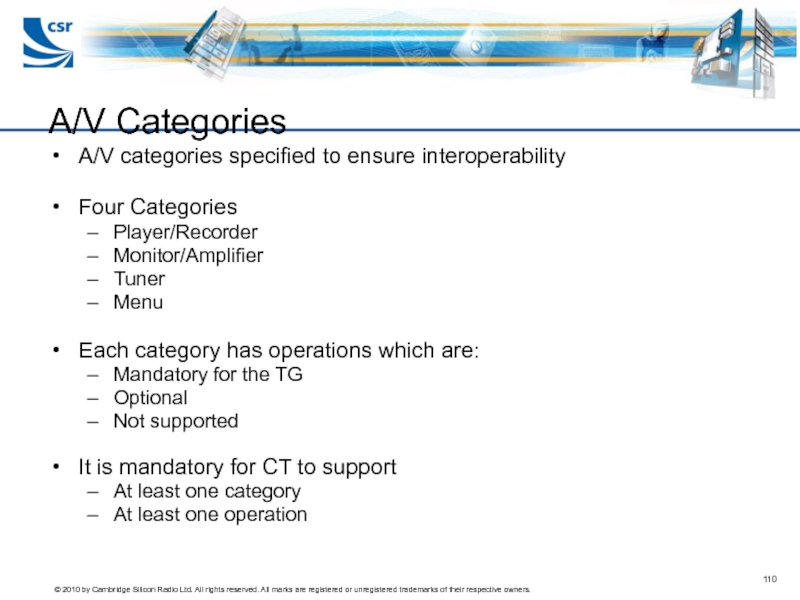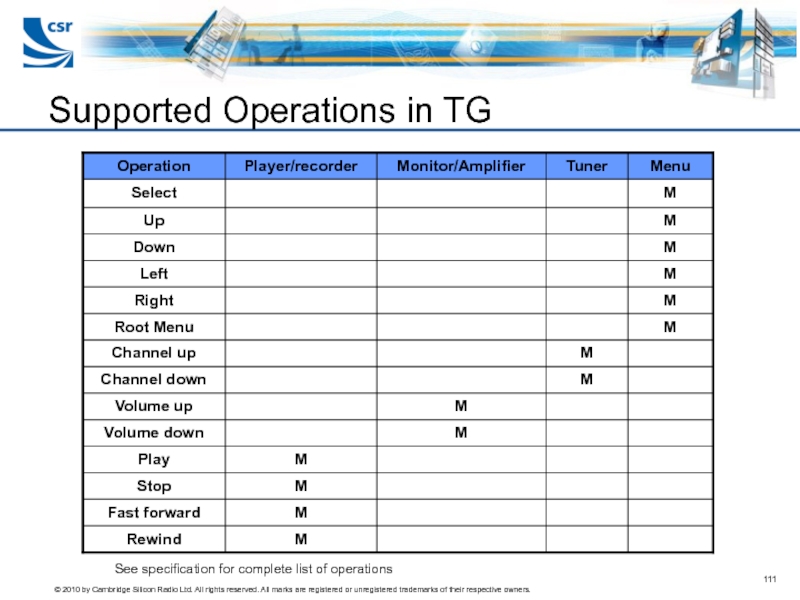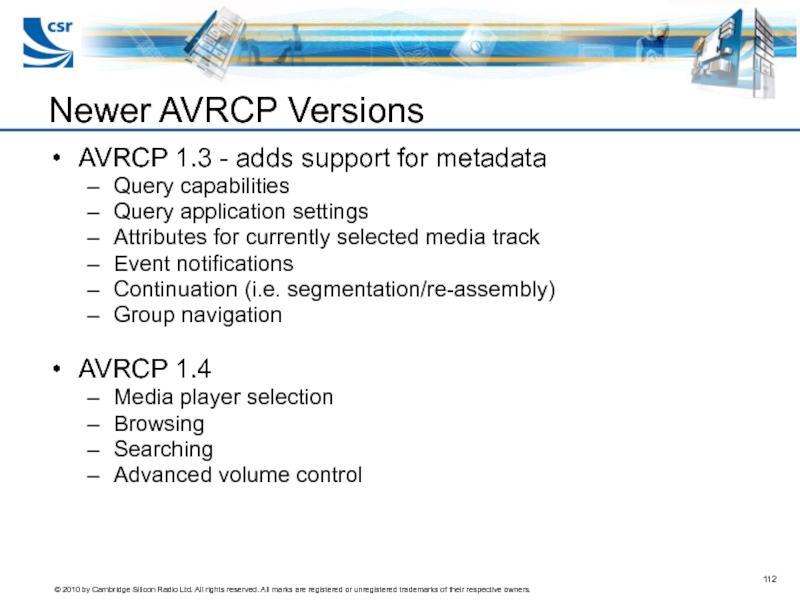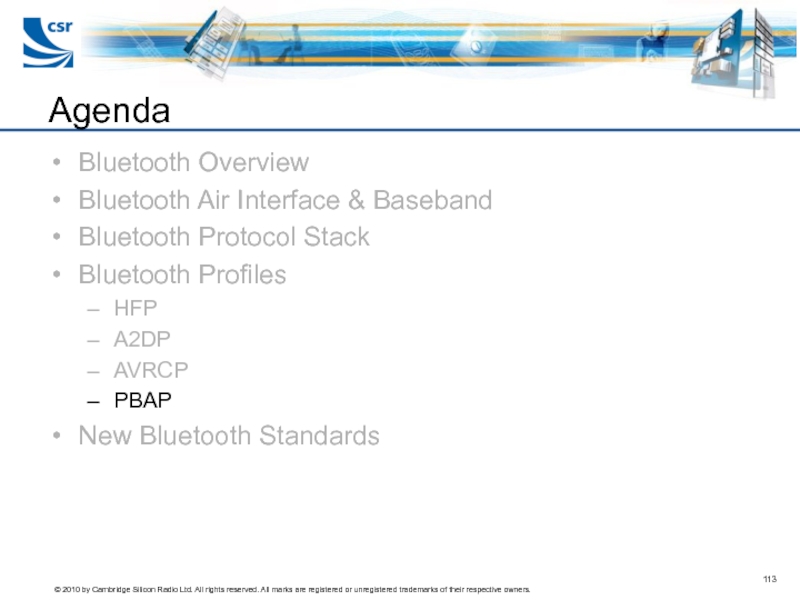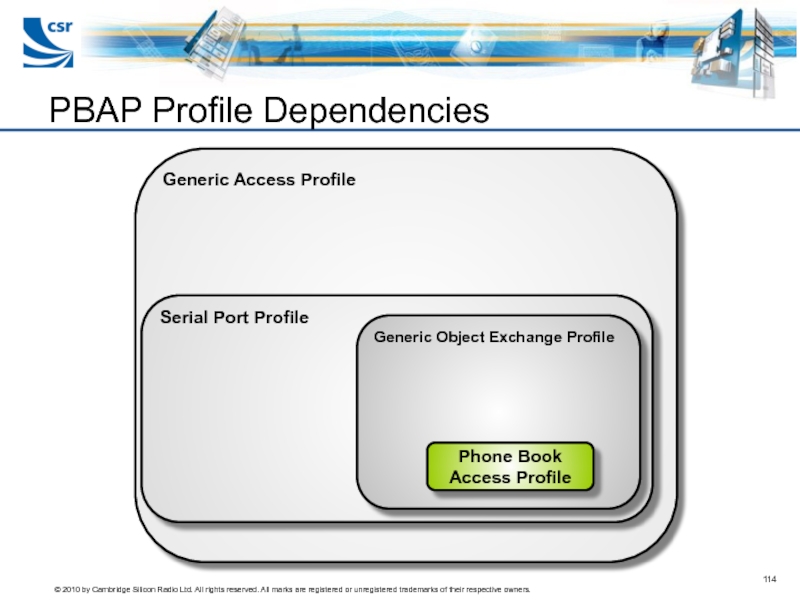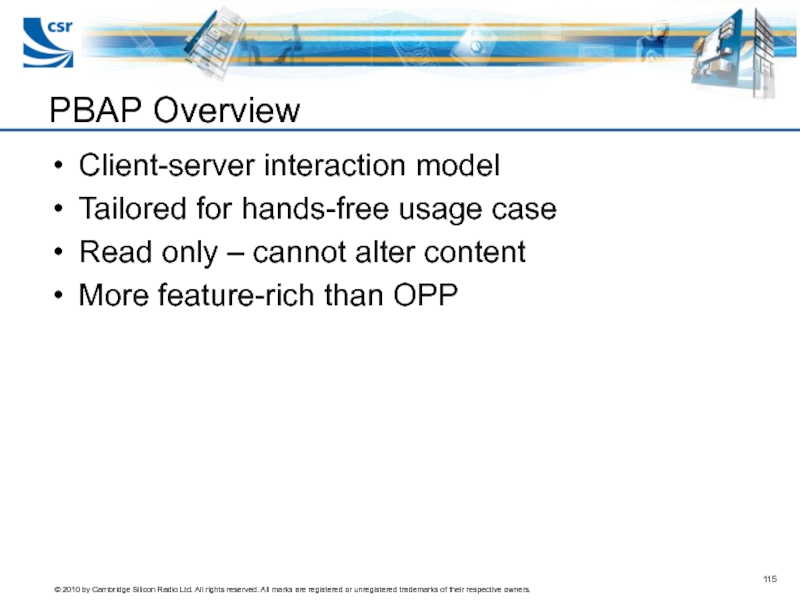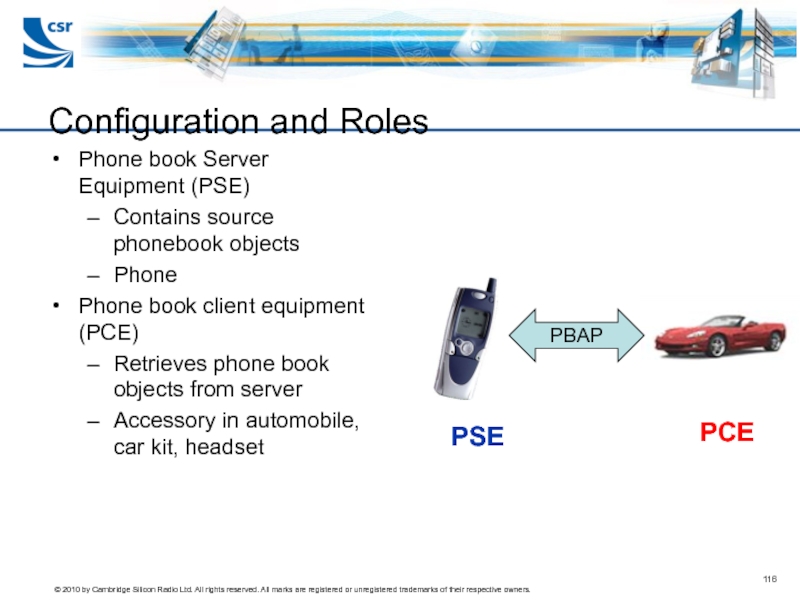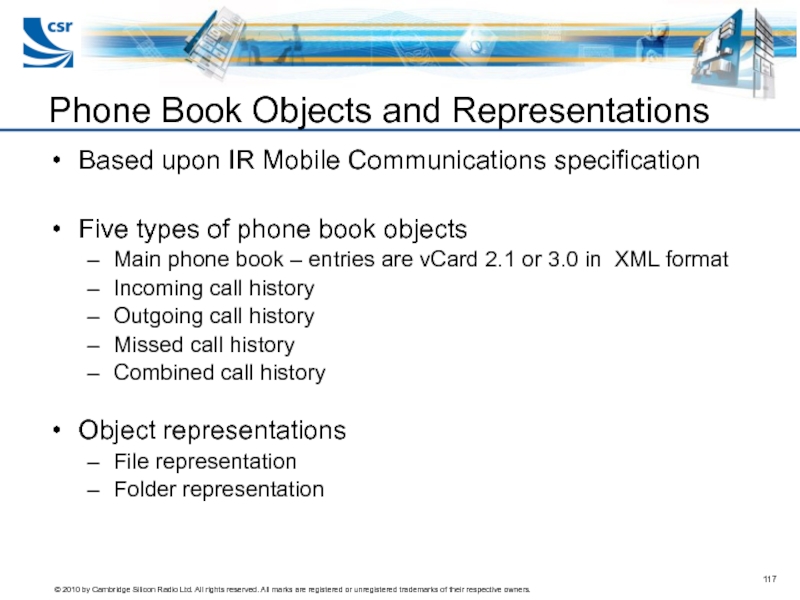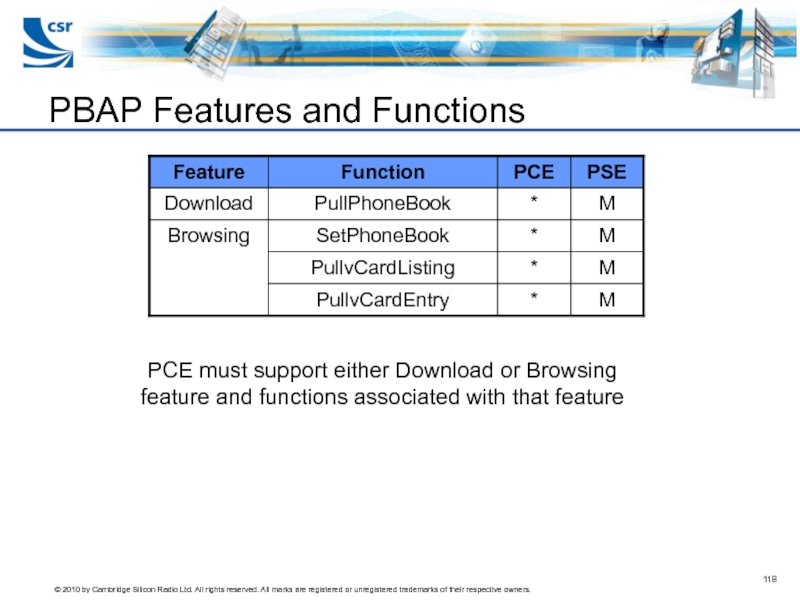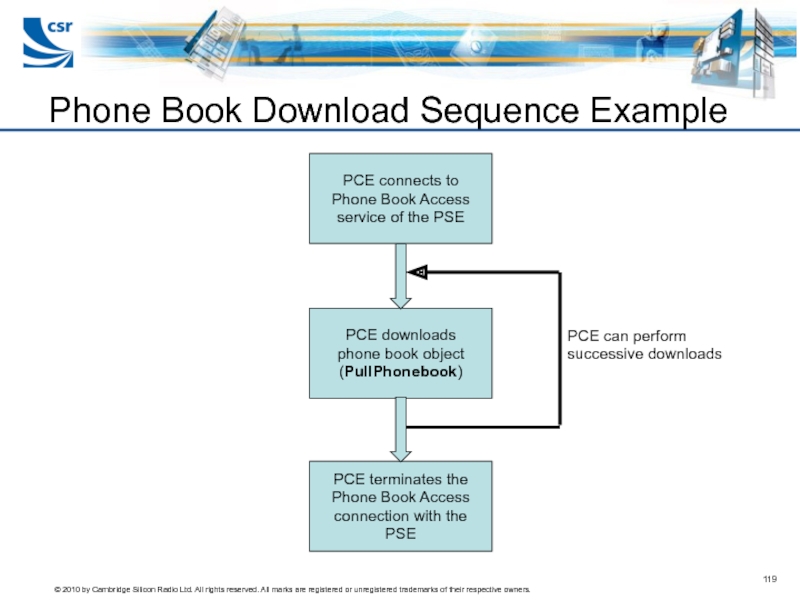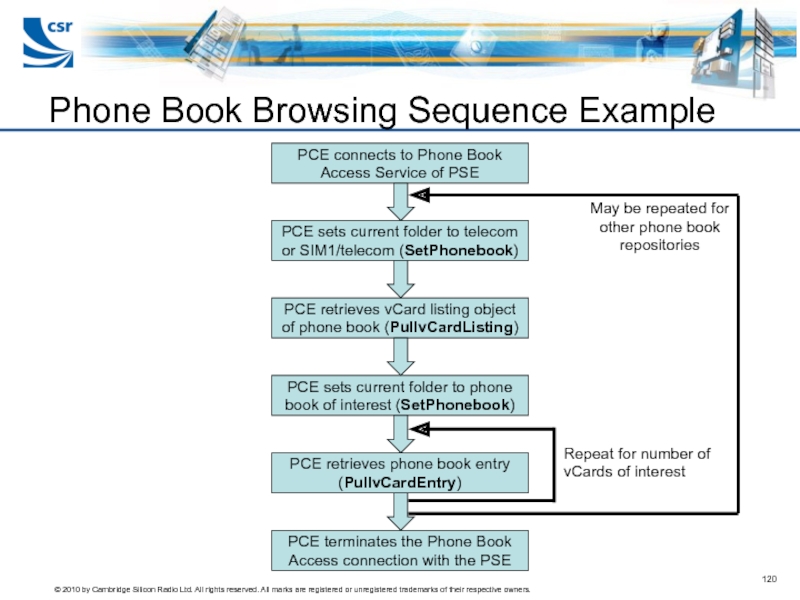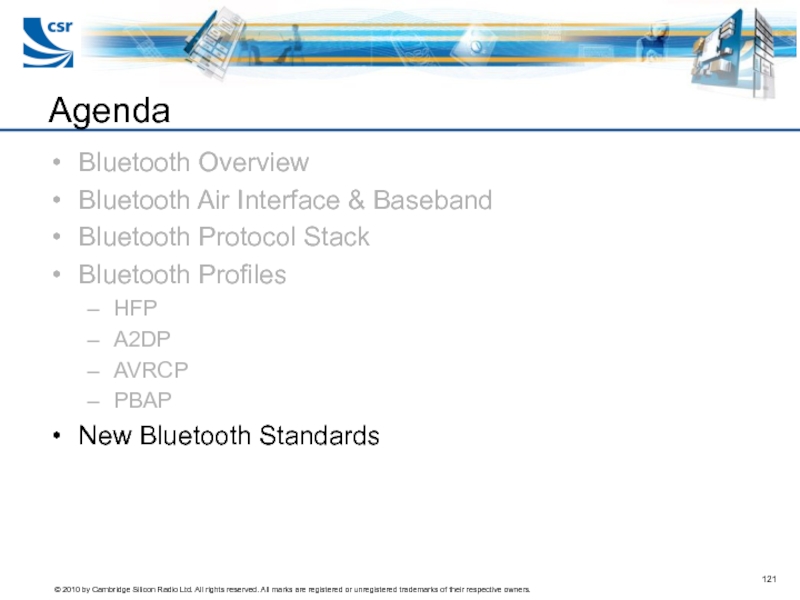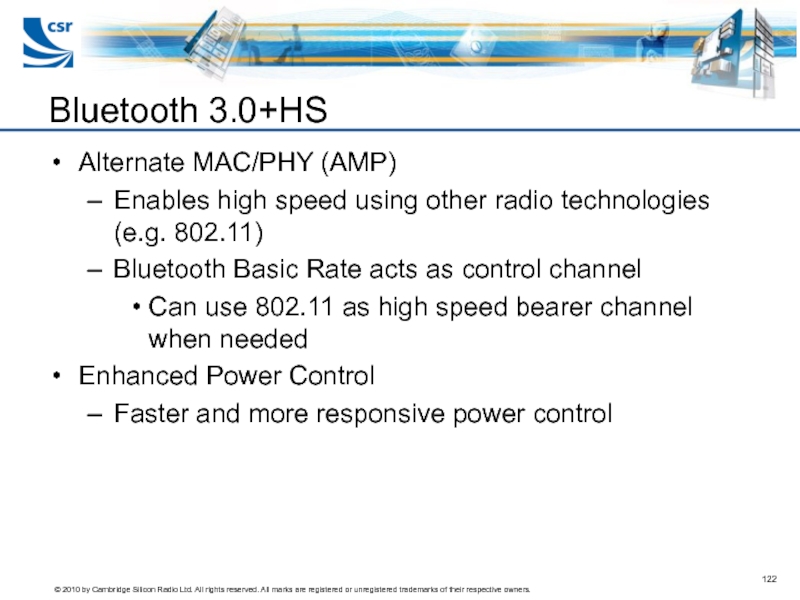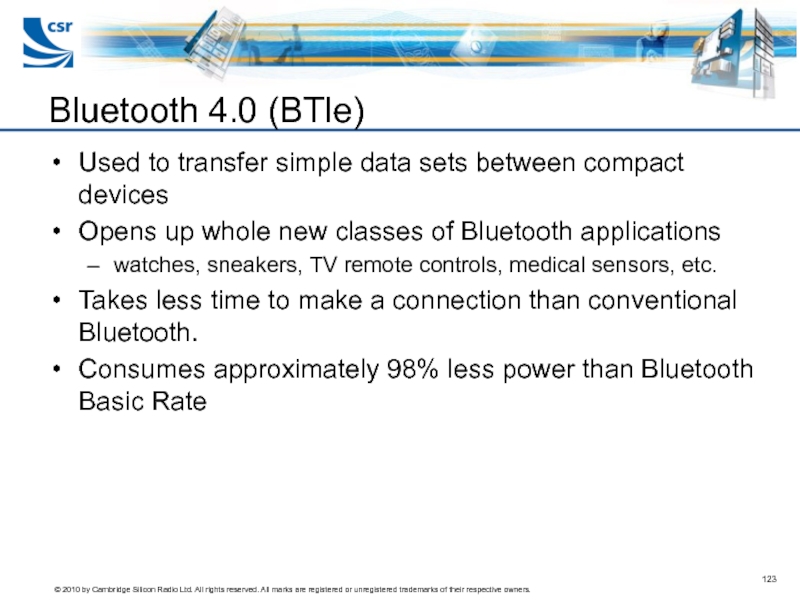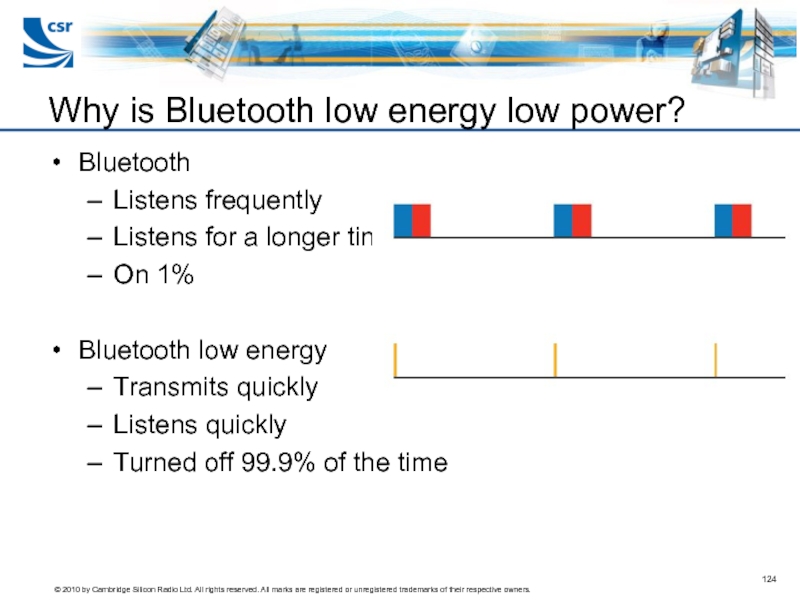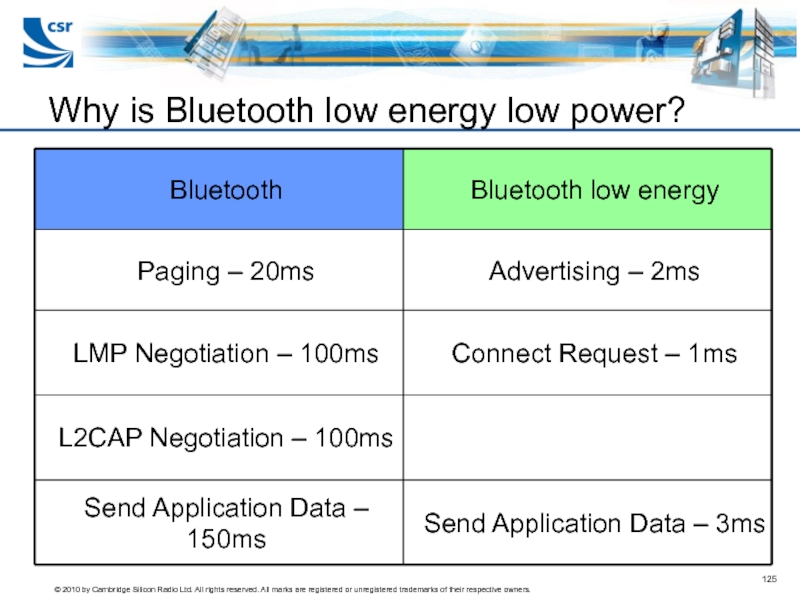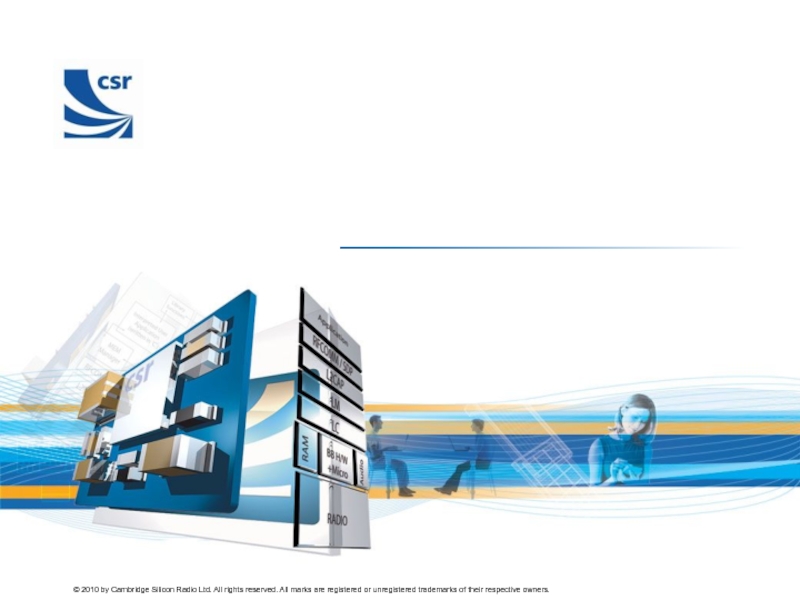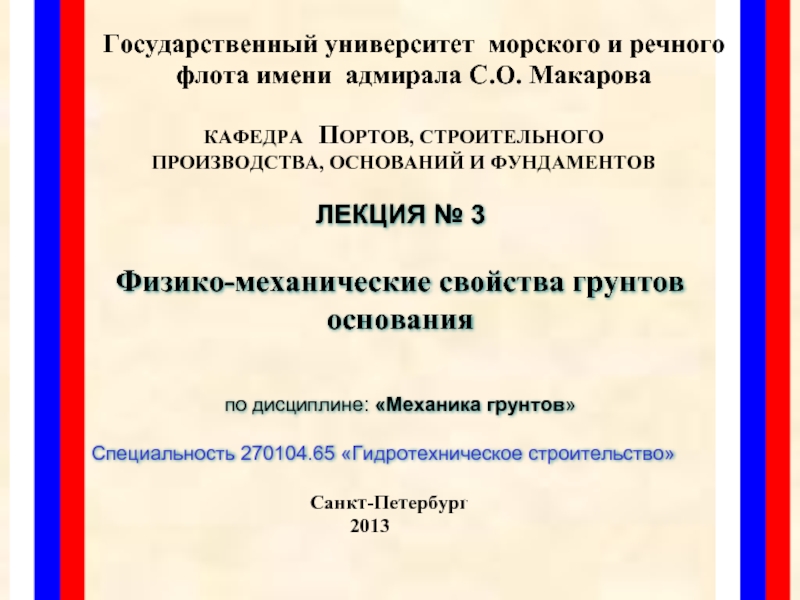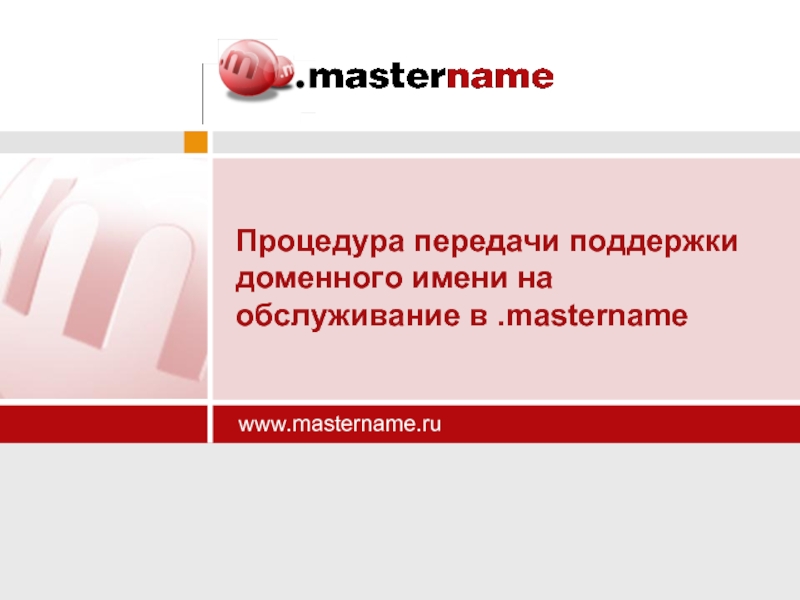- Главная
- Разное
- Дизайн
- Бизнес и предпринимательство
- Аналитика
- Образование
- Развлечения
- Красота и здоровье
- Финансы
- Государство
- Путешествия
- Спорт
- Недвижимость
- Армия
- Графика
- Культурология
- Еда и кулинария
- Лингвистика
- Английский язык
- Астрономия
- Алгебра
- Биология
- География
- Детские презентации
- Информатика
- История
- Литература
- Маркетинг
- Математика
- Медицина
- Менеджмент
- Музыка
- МХК
- Немецкий язык
- ОБЖ
- Обществознание
- Окружающий мир
- Педагогика
- Русский язык
- Технология
- Физика
- Философия
- Химия
- Шаблоны, картинки для презентаций
- Экология
- Экономика
- Юриспруденция
Bluetooth 101. Training for Plantronics презентация
Содержание
- 1. Bluetooth 101. Training for Plantronics
- 2. Bluetooth 101+ Roger Garvert 28 September 2010 Training for Plantronics
- 3. Contact Info
- 4. Bluetooth Overview Bluetooth Air Interface & Baseband
- 5. Bluetooth Overview Bluetooth Air Interface & Baseband
- 6. Robust unlicensed short range wireless standard It
- 7. Provides point-to-point connections Provides ad-hoc networking capabilities
- 8. Two devices locate each other Form a
- 9. Point-to-multipoint – the Piconet Two devices create
- 10. Identifying Bluetooth Devices Each Bluetooth device is
- 11. Bluetooth Channels A master can create two
- 12. Bluetooth Overview Bluetooth Air Interface & Baseband
- 13. Spectrum Usage The 2.4GHz ISM band is
- 14. Frequency Hopping Spread Spectrum - FHSS Bluetooth
- 15. Benefits of FHSS Reliability - If a
- 16. Hop Selection and Synchronization One frequency hop
- 17. Introduced in Bluetooth v1.2 Bluetooth shares the
- 18. Three steps Adaptive Frequency Hopping
- 19. Three steps Identify Bad Channels by monitoring
- 20. Three steps Identify Bad Channels by monitoring
- 21. Three steps Identify Bad Channels by monitoring
- 22. Three steps Identify Bad Channels, monitor RSSI,
- 23. Three steps Identify Bad Channels, monitor RSSI,
- 24. Benefits: Fewer lost packets = better audio
- 25. Modulation Scheme During each hop, data is
- 26. Modulation Example For channel 0 (Frequency 2.402GHz)
- 27. π/4-DQPSK – 2Mbps
- 28. v1.2 Packets: v2.0 EDR Packets: EDR Packets
- 29. Transmission timing A slave can only send
- 30. To increase the throughput of the Bluetooth
- 31. There are 14 basic rate packet types
- 32. Bluetooth defines three levels of forward error
- 33. Common Packet Types ID Packet - consists
- 34. HV1 Packet - High Quality Voice packet
- 35. DM1 Packet - Data - Medium Rate,
- 36. Mixing ACL and HV3 SCO packets
- 37. Mixing ACL and HV2 SCO packets
- 38. Slot 0 1 2 3 4 5
- 39. Bluetooth v1.1 SCO connections have serious impact
- 40. EV3 Packet - Voice packet carries between
- 41. max. symmetric max. asymmetric SCO Enhanced SCO (eSCO)
- 42. Bluetooth 2.0 EDR ACL Packets
- 43. 2-EV3 Packet – Similar to EV3 packet,
- 44. Bluetooth defines 3 power classes for devices:
- 45. For a Bluetooth device to discover new
- 46. Inquiry Inquiry response Inquiry Repeated Inquiries
- 47. Page (ID packet with headset’s ID) Page
- 48. Secure Simple Pairing (SSP) Feature of Bluetooth
- 49. Input/Output Capabilities Four I/O capabilities defined Display
- 50. “Just Works” User chooses to “add a device”
- 51. The mouse is automatically selected and paired
- 52. Step 1 – User enables technology on
- 53. Step 1 – User powers on keyboard
- 54. Feature of Bluetooth 2.1 Problem: Takes
- 55. To help reduce power consumption, there are
- 56. Feature of Bluetooth 2.1 Problem: HID
- 57. Devices agree upon a time delay during
- 58. Bluetooth Overview Bluetooth Air Interface & Baseband
- 59. Bluetooth stack is loosely based around the
- 60. Bluetooth Radio Bluetooth Baseband (Link Controller) Link
- 61. Manages link set-up Manages security Manages piconet
- 62. Link Set-up Procedures: Processes results of Inquiry
- 63. Piconet Connection Management: Packet type adjustment based
- 64. Bluetooth Radio Bluetooth Baseband (Link Controller) Link
- 65. The HCI interface defines a
- 66. Hostless system Host based system HCI - Not really a layer!
- 67. Independent of hardware implementation Standard interface to
- 68. Bluetooth Radio Bluetooth Baseband (Link Controller) Link
- 69. Logical Link Control Multiplexing: many logical links
- 70. L2CAP adds a Destination Channel ID to
- 71. L2CAP Segmentation and Reassembly
- 72. No Traffic This level indicates that no
- 73. Bluetooth Radio Bluetooth Baseband (Link Controller) Link
- 74. SDP servers maintain a database on services
- 75. Service search attribute request for DUN Set
- 76. Bluetooth Radio Bluetooth Baseband (Link Controller) Link
- 77. Serial cable replacement Up to 60 emulated
- 78. Bluetooth Overview Bluetooth Air Interface & Baseband
- 79. Basic set of standards for common
- 80. Generic Access Profile Serial Port Profile
- 81. Generic Access Profile defines: generic procedures
- 82. Generic Access Profile Serial Port Profile
- 83. LAN access
- 84. Generic Access Profile Serial Port Profile
- 85. File Transfer Object Push
- 86. A2DP- Advanced Audio Distribution Profile AVRCP -
- 87. Bluetooth Overview Bluetooth Air Interface & Baseband
- 88. Generic Access Profile Serial Port Profile Handsfree Profile HFP Profile Dependency
- 89. Configuration and Roles Audio Gateway (AG) gateway
- 90. Feature Requirements Must support CVSD Only one
- 91. Establishing a Service Level Connection AG HF
- 92. Transferring Status Information AG HF SLC established
- 93. Answering a call - in-band ring tone
- 94. Answer/end call – no in-band ring tone
- 95. Three-way call – hold active/accept waiting AG
- 96. Call Control Audio connection setup Audio connection
- 97. Common AT Command and Result Codes AG
- 98. Bluetooth Overview Bluetooth Air Interface & Baseband
- 99. Generic Access Profile Generic Audio/Video Distribution
- 100. Configuration and Roles Source (SRC) Source of
- 101. Audio Codec Interoperability Requirements Must support SBC
- 102. Codec Specific Information Elements AVDTP signaling procedure
- 103. AVDTP Signaling Procedures SNK SRC User initiated
- 104. Bluetooth Overview Bluetooth Air Interface & Baseband
- 105. Generic Access Profile Generic Audio/Video Distribution
- 106. Configuration and Roles Controller (CT) Initiates transaction
- 107. Feature Requirements
- 108. Procedure of AV/C Command TG CT User
- 109. AV/C Command Types UNIT INFO 1394 Trade
- 110. A/V Categories A/V categories specified to ensure
- 111. Supported Operations in TG See specification for complete list of operations
- 112. Newer AVRCP Versions AVRCP 1.3 - adds
- 113. Bluetooth Overview Bluetooth Air Interface & Baseband
- 114. Generic Access Profile Serial Port Profile
- 115. PBAP Overview Client-server interaction model Tailored for
- 116. Configuration and Roles Phone book Server Equipment
- 117. Phone Book Objects and Representations Based upon
- 118. PBAP Features and Functions PCE must support
- 119. Phone Book Download Sequence Example PCE connects
- 120. Phone Book Browsing Sequence Example PCE connects
- 121. Bluetooth Overview Bluetooth Air Interface & Baseband
- 122. Bluetooth 3.0+HS Alternate MAC/PHY (AMP) Enables high
- 123. Bluetooth 4.0 (BTle) Used to transfer simple
- 124. Bluetooth Listens frequently Listens for a longer
- 125. Why is Bluetooth low energy low power?
Слайд 3Contact Info
Roger Garvert
Field Application Engineer
2445 Flambeau Drive
Naperville, IL 60564
Email: roger.garvert@csr.com
Cell: +1 630 788 7553
Web: www.csr.com
Слайд 4Bluetooth Overview
Bluetooth Air Interface & Baseband
Bluetooth Protocol Stack
Bluetooth Profiles
HFP
A2DP
AVRCP
PBAP
New Bluetooth Standards
Agenda
Слайд 5Bluetooth Overview
Bluetooth Air Interface & Baseband
Bluetooth Protocol Stack
Bluetooth Profiles
HFP
A2DP
AVRCP
PBAP
New Bluetooth Standards
Agenda
Слайд 6Robust unlicensed short range wireless standard
It is an open and license
The standard is presided over by the Special Interest Group (SIG)
What is Bluetooth?
Слайд 7Provides point-to-point connections
Provides ad-hoc networking capabilities
Bluetooth specification details how the technology
Bluetooth Profiles detail how specific applications work to ensure interoperability
What does Bluetooth provide?
Слайд 8Two devices locate each other
Form a connection and transfer data
“Wireless cable
The device that initiates the connection is called the Master
Any other devices the Master is connected to are referred to as Slaves
Point-to-point
Слайд 9Point-to-multipoint – the Piconet
Two devices create a point-to-point connection
A third device
The new device is discovered.
It is added to the piconet and data can be transferred
Слайд 10Identifying Bluetooth Devices
Each Bluetooth device is assigned a unique 48-bit MAC
This is enough addresses for 281,474,976,710,656 Bluetooth units, this should last a few years even with the optimistic predictions of the analysts!
The address is split into three parts:
LAP: Lower Address Part - used to generate frequency hop pattern and header sync word
UAP: Upper Address Part - used to initialize the HEC and CRC engines
NAP: Non-significant Address Part - used to seed the encryption engine
LAP [0:23]
UAP[24:31]
NAP [32:47]
lsb
msb
Слайд 11Bluetooth Channels
A master can create two types of logical channel with
Asynchronous Connection Less (ACL): Packet Switched System provides a reliable data connection with a best effort bandwidth; depends on radio performance and number of devices in the piconet
Synchronous Connection Oriented (SCO): Circuit Switched System provides real time unreliable connection with a guaranteed bandwidth; usually used for voice based applications
The Bluetooth connections are limited to 1Mbps across the air (without EDR)
This gives a theoretical maximum of ~723kbps of useable data
Слайд 12Bluetooth Overview
Bluetooth Air Interface & Baseband
Bluetooth Protocol Stack
Bluetooth Profiles
HFP
A2DP
AVRCP
PBAP
New Bluetooth Standards
Agenda
Слайд 13Spectrum Usage
The 2.4GHz ISM band is a free for all for
Direct Radio waves Visible X-rays
Current 100 kHz – 300 GHz light
Extremely Ultraviolet Gamma
low frequency FM radio radiation rays
(ELF) 88-108 MHz
Very
low frequency Microwaves
(VLF) 300 MHz – 300 GHz
mediumwave radio
550-1600 kHz
Infrared
longwave radio radiation
150-350kHz
Frequency in hertz (Hz)
kHz MHz GHz
0 102 104 106 108 1010 1012 1014 1016 1018 1020 1022
Bluetooth
The 2.4GHz ISM Band is also used by:
Microwave Ovens
Digital Cordless Phones
802.11b/g
Слайд 14Frequency Hopping Spread Spectrum - FHSS
Bluetooth splits the spectrum up into
The Bluetooth radio changes transmission frequency 1600 times a second for a 1 slot packet type
The frequency hops follow a pseudo-random sequence that meets the power density requirements for the FCC and other regulatory bodies
2.4000
Frequency, GHz
2.4020
2.4800
2.4835
Guard Band
Guard Band
Слайд 15Benefits of FHSS
Reliability - If a packet is not correctly received
Low Interference - Conversely, if Bluetooth is interfering with another system that uses a set of channels, Bluetooth will only use those channels a small proportion of the time
Security - Since the hop pattern is pseudo random it is very difficult for anyone to eavesdrop on the Bluetooth link
Слайд 16Hop Selection and Synchronization
One frequency hop lasts 625µs, this increment is
Each Bluetooth device has a clock circuit that counts frequency hops
The address of the master of the piconet is used to seed a frequency hop calculation algorithm
The phase of the hop sequence is defined by the Bluetooth clock of the master
Device address and clock phase information is exchanged during connection negotiation
The slave synchronizes its own clock to the master’s during connection so that both devices change frequency at the same time
Слайд 17Introduced in Bluetooth v1.2
Bluetooth shares the 2.4GHz ISM band with:
802.11b/g Wi-Fi
2.4GHz cordless phones
Microwave ovens
More devices = More interference.
802.11b/g does not work well with BT interferers.
AFH allows BT to avoid known ‘bad’ channels.
Increased bandwidth, reduced lost data.
Adaptive Frequency Hopping
Слайд 19Three steps
Identify Bad Channels by monitoring RSSI, BER and/or PER
A
B
Adaptive Frequency
Слайд 20Three steps
Identify Bad Channels by monitoring RSSI, BER and/or PER
Receive reserved
WLAN
Adaptive Frequency Hopping
Слайд 21Three steps
Identify Bad Channels by monitoring RSSI, BER and/or PER
Receive reserved
Agree with other devices on Bad Channels
Adaptive Frequency Hopping
Слайд 22Three steps
Identify Bad Channels, monitor RSSI, BER & PER
Receive reserved channel
Agree with other devices on Bad Channels
Adaptive Frequency Hopping
Слайд 23Three steps
Identify Bad Channels, monitor RSSI, BER & PER
Receive reserved channel
Agree with other devices on Bad Channels
Use alternative channels
Adaptive Frequency Hopping
Слайд 24Benefits:
Fewer lost packets = better audio quality
Less degradation to Bluetooth and
Greater bandwidth efficiency
Not backward compatible with v1.1 systems
Adaptive Frequency Hopping
Слайд 25Modulation Scheme
During each hop, data is transmitted using Gaussian Frequency Shift
FSK uses two different frequencies to transmit a binary ‘1’ or ‘0’
For Bluetooth the two frequencies are:
fc + Δ for ‘1’
fc - Δ for ‘0’ where fc = frequency of current hop and Δ = ~157kHz
Слайд 26Modulation Example
For channel 0 (Frequency 2.402GHz)
During one time slot the data
Слайд 27π/4-DQPSK – 2Mbps
1MSps => 2Mbps
8-DPSK – 3Mbps
1MSps => 3Mbps
Bluetooth 2.0 modulation
Same packet timing & structure, major spectral characteristics, and packet negotiation
Same radio used for all modulation schemes (FSK and PSK)
Master devices support mixed Piconets by using appropriate packets for each slave
EDR devices must support 1x and 2x data rate, 3x data rate is optional
EDR Modulation Schemes
Слайд 29Transmission timing
A slave can only send data to the master after
Masters transmit in even numbered slots and slaves respond in the next odd numbered slot
Single slot packets are less then 366µs long to allow the synthesizer to retune to the next frequency hop
Слайд 30To increase the throughput of the Bluetooth link longer packets are
1, 3 and 5 slot packets are available for use in a dynamic fashion
Multi-slot packets
Слайд 31There are 14 basic rate packet types defined, split into 4
Common Packets (both ACL & SCO)
Single slot packets
ACL 3 slot packets
ACL 5 slot packets
Each packet type has a different level of error correction and protection and different size payloads
Packet Types
Слайд 32Bluetooth defines three levels of forward error correction
No Error Correction:
There is
Data is just put in the payload and sent
1/3 FEC:
Each bit is repeated 3 times
Majority voting decides bit value
2/3 FEC:
The data is encoded using a (15,10) shortened hamming code
Every 10 bits of data are encoded into 15 bits of data
Can correct single bit errors and detect double bit errors
Forward Error Correction
Слайд 33Common Packet Types
ID Packet - consists of the device access code
NULL Packet - has no payload data and consists of only the Channel Access Code and the Packet Header, hence fixed length of 126-bits. Used for returning status information, does not need to be acknowledged.
POLL Packet - Similar to the NULL packet, has no payload but does require an acknowledge . Used by piconet master to poll slave devices.
FHS Packet - Special control packet that reveals the BT device address and the clock of the sender. See next slide for more detail of the payload structure.
Слайд 34HV1 Packet - High Quality Voice packet carries 10 bytes of
HV2 Packet - Lower quality voice transmission that carries 20 information bytes protected with 2/3 FEC to 240-bit payload, no CRC. Carries 2.5ms of speech at 64kbps and must be transmitted every four time slots
HV3 Packet - Lowest quality voice packet, carries 30 bytes of info with no FEC or CRC in its 240-bit payload. Carries 3.75ms of speech at 64kbps and needs to be sent every six time slots
DV Packet - This is a combined Data and Voice packet with the payload split as shown below. The voice field is not FEC protected. The Data field contains up to 10-bytes including a 1-byte payload header and a 16-bit CRC. The Data is then encoded with 2/3 FEC. If required the payload is padded with zeroes to ensure that the total number of payload bits is a multiple to 10 prior to FEC coding. The Voice field is never retransmitted but the Data field can be if errors are present
SCO Packets
Слайд 35DM1 Packet - Data - Medium Rate, carries up to 18
DH1 Packet - Similar to the DM1 packet except the payload is not FEC encoded hence higher data rate. The DH1 Packet can carry up to 28 information bytes plus a 16-bit CRC
DM3 Packet - This packet is a DM1 packet with an extended payload, up to 3 time slots worth. The payload can contain up to 123 information bytes including a 2 -byte payload header plus a 16-bit CRC
DH3 Packet - This packet is similar to the DM3 packet except that the payload is not FEC encoded. Therefore, it can carry up to 185 information bytes including the 2-byte payload header plus a 16-bit CRC
DM5 Packet - This is a DM1 packet with an extended payload, up to 5 time slots. The payload can contain up to 226 information bytes including the 2-byte payload header plus a 16-bit CRC.
DH5 Packet - Similar to the DM5 except that the information is not FEC encoded.Can carry up to 341 information bytes including the 2-byte payload header plus a 16-bit CRC
ACL Packets
Слайд 38Slot
0
1
2
3
4
5
6
7
8
9
Master
Slave 1
Slave 2
Slave 3
One HV1 link ties up all of
Bluetooth device can’t do anything else!
Mixing ACL and HV1 SCO Packets
Слайд 39Bluetooth v1.1 SCO connections have serious impact on air interface usage.
Limited
CVSD highly susceptible to packet loss
No packet re-transmission
Bluetooth v1.2 added multi-slot SCO packet types
allows variable data rates
Larger duty cycle allows additional connections, scans, etc
Also added CRC, FEC and data re-transmission
Enhanced SCO (eSCO)
Слайд 40EV3 Packet - Voice packet carries between 1 and 30 information
EV4 Packet – Voice packet carries between 1 and 120 information bytes plus a 16-bit CRC code. The EV4 packet may cover to up three time slots. The information plus CRC bits are coded with a rate 2/3 FEC
EV5 Packet – Voice packet carries between 1 and 180 information bytes plus a 16-bit CRC code. The bytes are not protected by FEC. The EV5 packet may cover up to three time slots.
Bluetooth 1.2 eSCO Packets
Слайд 432-EV3 Packet – Similar to EV3 packet, except that the payload
2-EV5 Packet – Similar to EV5 packet, except that the payload is modulated using π/4-DQPSK. It has between 1 and 360 information bytes plus a 16-bit CRC code. The bytes are not protected by FEC. The 2-EV5 packet may cover up to three time slots.
3-EV3 Packet – Similar to EV3 packet, except that the payload is modulated using 8DPSK. It has between 1 and 90 information bytes plus a 16-bit CRC code. The bytes are not protected by FEC. The 2-EV3 packet covers a single time slot.
3-EV5 Packet – Similar to EV5 packet, except that the payload is modulated using 8DPSK. It has between 1 and 540 information bytes plus a 16-bit CRC code. The bytes are not protected by FEC. The 2-EV5 packet may cover up to three time slots.
Bluetooth 2.0 EDR eSCO Packets
Слайд 44Bluetooth defines 3 power classes for devices:
Class 1: 0dBm to +20dBm
Class 2: -6dBm to +4dBm (250µW to 2.5mW)
Class 3: <0dBm ( <1mW)
These power classes translate into approximate distances often used when discussing Bluetooth:
Class 1: 100 Meters
Class 2: 10 Meters
Class 3: <10 Meters
Power Classes
Слайд 45For a Bluetooth device to discover new devices that are in
A device that wants to be found by another device must be in inquiry scan mode
Once a device has been found it must be paged to initiate a connection
A device that wants to be connected to must be in Page Scan Mode.
A device that wants to connect to a particular device must be in Page Mode
Discovering and Connecting to Other Devices
Слайд 46Inquiry
Inquiry response
Inquiry
Repeated Inquiries
Inquiry mode
Inquiry scan mode
Discovering a Bluetooth Device
Слайд 47Page (ID packet with headset’s ID)
Page response (ID packet with headset’s
Frequency Hop Synchronization packet
acknowledge (ID packet with headset’s ID)
Both devices move
to paging device’s hop sequence
Probe new connection (Poll packet)
Confirm connection (NULL packet)
LMP configures connection
Page mode
Page scan mode
Connect request
Connect accept
Establishing a baseband connection
Слайд 48Secure Simple Pairing (SSP)
Feature of Bluetooth 2.1
Enables easier connectivity between devices
Слайд 49Input/Output Capabilities
Four I/O capabilities defined
Display Only
Display Yes/No
Keyboard Only
No Input No Output
The
Слайд 51The mouse is automatically selected and paired to the computer –
3.
“Just Works”
Слайд 52Step 1 – User enables technology on PC and activates connection
Step 2 – User selects “ADD”
Step 3 – Phone displays ‘laptop’ and asks user if he/she wishes to connect
Step 4 – Phone displays 6-digit number and asks user to confirm
Same for mobile phone to car kit and mobile to stereo headset
User is asked to confirm 6-digit number on both ends
102466
Numeric Comparison
Слайд 53Step 1 – User powers on keyboard and activates connection from
Step 2 – User selects “ADD” on the phone
Step 3 – Phone displays ‘keyboard’
Step 4 – User is asked to enter 6-digit number on the keyboard and press “Enter”
User is asked to enter 6-digit number on keyboard
Passkey Entry
Слайд 54Feature of Bluetooth 2.1
Problem:
Takes a long time to find devices, work
Solution:
Include information in the inquiry response
Name of Device
Profiles supported
Etc.
Side effects
Task oriented actions quicker as devices can get filtered quickly
Can transmit other information: time, location, etc.
Extended Inquiry Response
Слайд 55To help reduce power consumption, there are three Bluetooth low power
Sniff Mode (The most used)
Hold Mode
Park Mode
Slaves can request to be placed in any of these modes
Masters can ask a slave to enter one of these modes
Masters can also force a slave into one of these modes if it has previously accepted the mode
Low Power Modes
Слайд 56Feature of Bluetooth 2.1
Problem:
HID devices want low power and low latency
Solution:
Laptop
Mouse ignores laptop most of the time
Side effects
Better scatternet support
Mouse has 2-3 times better battery life
Keyboard has 10x better battery life
Sniff Subrating
Слайд 57Devices agree upon a time delay during which no communication will
During the silent periods the slave can sleep or perform other functions
After the silent period the slave wakes up and ‘sniffs’ for a number of slots for its AM_ADR. If there is no data it goes back to sleep
Any active SCO connections between the devices must still be supported
Difference between sniff and hold mode:
Hold mode is a one shot deal during which no communication occurs
Sniff mode defines a repeating period during which no communication occurs
Sniff Mode
Слайд 58Bluetooth Overview
Bluetooth Air Interface & Baseband
Bluetooth Protocol Stack
Bluetooth Profiles
HFP
A2DP
AVRCP
PBAP
New Bluetooth Standards
Agenda
Слайд 59Bluetooth stack is loosely based around the OSI model
HCI layer is
Audio data bypasses the upper layers and is sent straight to the application
Bluetooth Radio
Bluetooth Baseband (Link Controller)
Link Manager (LM)
Host Controller Interface (HCI)
L2CAP
SDP
RFCOMM
TCS-BIN
Adapted Protocols (TCP/IP, WAP)
Application Code and User Interface
Hardware
Firmware
Software
Bluetooth Protocol Stack
Слайд 60Bluetooth Radio
Bluetooth Baseband (Link Controller)
Link Manager (LM)
Host Controller Interface (HCI)
L2CAP
SDP
RFCOMM
TCS-BIN
Adapted Protocols
Application Code and User Interface
Audio
The Link Manager (LM)
Слайд 61Manages link set-up
Manages security
Manages piconet connections
Provides test modes for simplified testing
Link
LMP messages are not specifically acknowledged
LM assumes LC provides error free link
But, LC cannot supply 100% error free link!
The Link Manager (LM)
Слайд 62Link Set-up Procedures:
Processes results of Inquiry and Page
“Non-connection” oriented commands
Device Name,
Security Procedures:
Authentication, Authorization, Encryption
Safer+ algorithm up to 128-bit encryption key
Remember there are regional encryption laws to abide by!
Pairing and Bonding
The Link Manager (LM) cont
Слайд 63Piconet Connection Management:
Packet type adjustment based on channel quality
Switch between 1,3
Master-Slave role switching
Low Power Modes
Sniff, Park and Hold
Quality of Service contracts
Transmit power control
The Link Manager (LM) cont.
Слайд 64Bluetooth Radio
Bluetooth Baseband (Link Controller)
Link Manager (LM)
Host Controller Interface (HCI)
L2CAP
SDP
RFCOMM
TCS-BIN
Adapted Protocols
Application Code and User Interface
Audio
The Host Controller Interface (HCI)
Слайд 65
The HCI interface defines a physical connection between a host (e.g.
The specification defines three interfaces:
USB v1.1
RS-232
UART
It also defines messages that are passed across the HCI interface
Higher Layers
Audio
L2CAP
Control
HCI Driver
Physical Bus Driver
HCI
Packets
Physical Bus Driver
HCI Driver
Link Manager
Link Controller
Radio
Host
Bluetooth Module
Host Controller Interface (HCI)
Слайд 67Independent of hardware implementation
Standard interface to Link Manager and Link Controller
HCI
Link Control (Inquiry, Paging, Encryption, etc.)
Link Policy (Hold, Sniff, Park, QoS)
Host Controller and Baseband Commands (PINs, event masks, timeouts, etc.)
Informational Parameters (Device address, country code, buffers)
Status (Link Quality, RSSI, Failed connections)
Testing (Test mode commands)
Vendor specific commands
HCI cont.
Слайд 68Bluetooth Radio
Bluetooth Baseband (Link Controller)
Link Manager (LM)
Host Controller Interface (HCI)
L2CAP
SDP
RFCOMM
TCS-BIN
Adapted Protocols
Application Code and User Interface
Audio
Logical Link Control and Adaptation Protocol (L2CAP)
Слайд 69Logical Link Control
Multiplexing: many logical links onto one physical link
Adaptation
Segmentation &
Protocol
A well defined set of signaling rules understood by all devices
Logical Link Control and Adaptation Protocol (L2CAP)
Слайд 70L2CAP adds a Destination Channel ID to every packet
The DCID is
L2CAP Multiplexing
Слайд 72No Traffic
This level indicates that no traffic will be sent out.
Best Effort
Default level of service for all links
All values included in the QoS request should be viewed as hints and may be entirely ignored
Guaranteed
Remote device will attempt to honor the service level
Cannot overcome radio level interference
Not likely to be able to be maintained under poor radio conditions.
Best level of QoS for adding multiple connections
L2CAP Quality of Service
Слайд 73Bluetooth Radio
Bluetooth Baseband (Link Controller)
Link Manager (LM)
Host Controller Interface (HCI)
L2CAP
SDP
RFCOMM
TCS-BIN
Adapted Protocols
Application Code and User Interface
Audio
Service Discovery Protocol (SDP)
Слайд 74SDP servers maintain a database on services offered
Made up of service
Servers maintain their own database, there is no central registry.
SDP allows clients to search for services.
based on attributes and service classes.
SDP uses connections set up via the usual Inquiry and Paging operations.
Service Discovery Protocol (SDP)
Слайд 75Service search attribute request for DUN
Set up L2CAP link to SDP
Return
Disconnect L2CAP
Set up baseband link
SDP Server
SDP Client
SDP Example
Слайд 76Bluetooth Radio
Bluetooth Baseband (Link Controller)
Link Manager (LM)
Host Controller Interface (HCI)
L2CAP
SDP
RFCOMM
TCS-BIN
Adapted Protocols
Application Code and User Interface
Audio
RFCOMM
Слайд 77Serial cable replacement
Up to 60 emulated serial port connections per RFCOMM
Depending on implementation, multiple RFCOMM sessions are possible
Large base of legacy applications using serial communications
Uses GSM TS 07.10 standard
Credit Based Flow Control
Negotiated credit tokens determine data flow
RS-232 control signal emulation
RS-232 flow control emulation
Software (Xon/Xoff)
Hardware (CTS/RTS)
RFCOMM
Слайд 78Bluetooth Overview
Bluetooth Air Interface & Baseband
Bluetooth Protocol Stack
Bluetooth Profiles
HFP
A2DP
AVRCP
PBAP
New Bluetooth Standards
Agenda
Слайд 79
Basic set of standards for common usage models.
Reduces set of requirements
Ensures interoperability
Radio Level – ensures devices can contact each other.
Protocol Level – ensures devices can communicate.
User/usage Level:
Ensures application can interoperate.
Ensures user can interact with the device.
Bluetooth Profiles
Слайд 80Generic Access Profile
Serial Port Profile
Telephony Control Protocol Specification
Generic
Dial Up Networking
Profile
File Transfer Profile
Cordless Telephony
Profile
Service Discovery
Application Profile
Intercom
Profile
FAX Profile
Headset Profile
Object Push Profile
Synchronisation Profile
LAN Access Profile
Bluetooth foundation profiles
Слайд 81Generic Access Profile
defines:
generic procedures for discovering Bluetooth devices.
link management aspects
procedures related to security levels.
Common formats for parameters accessible on the user interface level (naming conventions).
All other profiles rest on Generic Access Profile.
Generic Access Profile
Слайд 82Generic Access Profile
Serial Port Profile
Service Discovery
Application Profile
Simulated serial
Uses RFCOMM.
Derived from GSM TS07.10.
Profile building blocks
Слайд 84Generic Access Profile
Serial Port Profile
Service Discovery
Application Profile
Generic Object
Object exchange.
Allows put & get data objects.
Uses IrDA standard OBEX.
Profile Building blocks
Слайд 85File Transfer
Object Push
Synchronisation
files
Business Card
Business Card
Data to be synchronized
Synchronized data
Synchronize me
OBEX Profiles
Слайд 86A2DP- Advanced Audio Distribution Profile
AVRCP - A/V Remote Control Profile
BIP -
BPP - Basic Printing Profile
CTP - Cordless Telephony Profile
DID - Device ID Profile
DUN - Dial-Up Networking Profile
FAX - Fax Profile
FTP - File Transfer Profile
GAVDP - Generic A/V Distribution Profile
GOEP - Generic Object Exchange Profile
HCRP - Hardcopy Cable Replacement Profile
HDP - Health Device Profile
HFP - Hands-Free Profile
HSP - Headset Profile
HID - Human Interface Device Profile
ICP - Intercom Profile
MAP - Message Access Profile
OPP - Object Push Profile
PAN - Personal Area Network Profile
PBAP - Phone Book Access Profile
SAP - SIM Access Profile
SDAP - Service Discovery Application Profile
SPP - Serial Port Profile
SYNCH - Synchronization Profile
VDP - Video Distribution Profile
Profiles
Слайд 87Bluetooth Overview
Bluetooth Air Interface & Baseband
Bluetooth Protocol Stack
Bluetooth Profiles
HFP
A2DP
AVRCP
PBAP
New Bluetooth Standards
Agenda
Слайд 89Configuration and Roles
Audio Gateway (AG)
gateway for the audio input/output
typically a cell
Hands-Free Unit (HF)
AG’s remote audio input/output
means of remote control
HFP
AG
HF
Слайд 90Feature Requirements
Must support CVSD
Only one audio connection per service level connection
Can have an SLC without an audio connection
Must have an SLC with an audio connection
See specification for complete list
of features and required support
Слайд 91Establishing a Service Level Connection
AG
HF
RFCOMM established
AT+BRSF
+BRSF:
OK
AT+CIND=?
+CIND…
OK
AT+CIND
+CIND…
OK
AT+CMER=
OK
AT+CHLD=?
+CHLD:…
OK
SLC established
Supported features
Call indicator support
Current status of call indicators
Enable indicator status update
Call hold indicator
Event or action by HF or AG
NOTE: HF or AG can also release SLC
Слайд 92Transferring Status Information
AG
HF
SLC established
+CIEV:...
Event in AG
Unsolicited events can be reported from
Service
Call status
Call setup
Call hold status
Signal
Roam status
Battery level
Слайд 93Answering a call - in-band ring tone
AG
HF
SLC established
+CIEV (callsetup=1)
RING (ALERT)
+CLIP:…
In band
ATA (ANSWER)
OK
+CIEV: (call=1)
+CIEV: (callsetup=0)
Call active
User answers call
Incoming call on AG
Audio connection setup
Audio connection established
AG is ringing
Repeated as necessary
Call active
Слайд 94Answer/end call – no in-band ring tone
AG
HF
SLC established
+CIEV (callsetup=1)
RING (ALERT)
+CLIP:…
ATA (ANSWER)
OK
+CIEV:
+CIEV: (callsetup=0)
Call active
User ends call
Incoming call on AG
Audio connection setup
Audio connection established
AG is ringing
Repeated as necessary
Call active
HF alerts user
AT+CHUP
OK
+CIEV: (call=0)
User answers call
Слайд 95Three-way call – hold active/accept waiting
AG
HF
In active call
+CCWA:…
+CIEV (callsetup=1)
AT+CHLD=2
OK
+CIEV: (callsetup=0)
In active
Audio connection established
User accepts
waiting call
+CIEV: (callhold=1)
Слайд 96Call Control
Audio connection setup
Audio connection release
Answer incoming call from AG
Change in-band
Reject incoming call from HF
Reject incoming call from AG
Audio connection transfer toward HF
Audio connection transfer toward AG
Place call with phone number supplied by HF
Memory dialing from HF
Last number re-dial from HF
Call waiting notification activation
Three way calling – third party called from HF
Calling line identification notification
Disabling EC/NR
Voice recognition activation
Remote volume control
See specification for examples of these, and other use cases
Слайд 97Common AT Command and Result Codes
AG may also send the following
ERROR
OK
NO CARRIER
BUSY
NO ANSWER
DELAYED
BLACKLISTED
RING
See specification for complete
list of commands and result codes
Слайд 98Bluetooth Overview
Bluetooth Air Interface & Baseband
Bluetooth Protocol Stack
Bluetooth Profiles
HFP
A2DP
AVRCP
PBAP
New Bluetooth Standards
Agenda
Слайд 99Generic Access Profile
Generic Audio/Video Distribution Profile
Advanced Audio
Distribution Profile
A2DP Profile
Audio/Video
Remote Control Profile
Слайд 100Configuration and Roles
Source (SRC)
Source of digital audio stream that is delivered
Media player, phone, PC
Sink (SNK)
Acts as a sink of the digital audio stream that is delivered by the source
Stereo headset, wireless speakers, car audio system
SNK
SRC
A2DP
Слайд 101Audio Codec Interoperability Requirements
Must support SBC
Optional support for MP3, AAC, ATRAC
Support
Слайд 102Codec Specific Information Elements
AVDTP signaling procedure negotiates codec parameters
Parameters part of
Sampling frequencies
Channel modes (mono, dual channel, stereo, joint stereo)
Bit rates
Other information specific to selected codecs
Слайд 103AVDTP Signaling Procedures
SNK
SRC
User initiated
action/event
IDLE
Stream Endpoint Discovery
Get Capabilities
Stream Configuration
Stream Establishment
Audio streaming
setup
OPEN
Start
STREAMING
User initiated
action/event
Audio streaming
Слайд 104Bluetooth Overview
Bluetooth Air Interface & Baseband
Bluetooth Protocol Stack
Bluetooth Profiles
HFP
A2DP
AVRCP
PBAP
New Bluetooth Standards
Agenda
Слайд 105Generic Access Profile
Generic Audio/Video Distribution Profile
Advanced Audio
Distribution Profile
AVRCP Profile
Audio/Video
Remote Control Profile
Слайд 106Configuration and Roles
Controller (CT)
Initiates transaction by sending command to target
Headsets, remote
Target (TG)
Receives command and generates a response frame
Media player, TV, tuner
SRC
SNK
AVRCP
A2DP
CT
TG
SRC
TG
A2DP
SNK
AVRCP
SRC
Слайд 108Procedure of AV/C Command
TG
CT
User initiated
action/event
Connection Establishment
AV/C Command
AV/C Interim Response
AV/C Response
Connection
established before
commands initiate from
controller
Interim responses may
be associated with
VENDOR DEPENDENT
commands
UNIT INFO
SUBUNIT INFO
VENDOR DEPENDENT
PASS THROUGH
TRCP(100)
Слайд 109AV/C Command Types
UNIT INFO
1394 Trade Association AV/C Digital Interface Command Set
SUBUNIT
1394 Trade Association AV/C Digital Interface Command Set
VENDOR DEPENDENT
Allows own set of AV/C commands
PASS THROUGH
Used to transfer user operation information from CT to Panel subunit of TG
Слайд 110A/V Categories
A/V categories specified to ensure interoperability
Four Categories
Player/Recorder
Monitor/Amplifier
Tuner
Menu
Each category has operations
Mandatory for the TG
Optional
Not supported
It is mandatory for CT to support
At least one category
At least one operation
Слайд 112Newer AVRCP Versions
AVRCP 1.3 - adds support for metadata
Query capabilities
Query application
Attributes for currently selected media track
Event notifications
Continuation (i.e. segmentation/re-assembly)
Group navigation
AVRCP 1.4
Media player selection
Browsing
Searching
Advanced volume control
Слайд 113Bluetooth Overview
Bluetooth Air Interface & Baseband
Bluetooth Protocol Stack
Bluetooth Profiles
HFP
A2DP
AVRCP
PBAP
New Bluetooth Standards
Agenda
Слайд 114Generic Access Profile
Serial Port Profile
Generic Object Exchange Profile
PBAP
Phone Book
Access Profile
Слайд 115PBAP Overview
Client-server interaction model
Tailored for hands-free usage case
Read only – cannot
More feature-rich than OPP
Слайд 116Configuration and Roles
Phone book Server Equipment (PSE)
Contains source phonebook objects
Phone
Phone book
Retrieves phone book objects from server
Accessory in automobile, car kit, headset
PCE
PSE
PBAP
Слайд 117Phone Book Objects and Representations
Based upon IR Mobile Communications specification
Five types
Main phone book – entries are vCard 2.1 or 3.0 in XML format
Incoming call history
Outgoing call history
Missed call history
Combined call history
Object representations
File representation
Folder representation
Слайд 118PBAP Features and Functions
PCE must support either Download or Browsing feature
Слайд 119Phone Book Download Sequence Example
PCE connects to
Phone Book Access
service of the
PCE downloads
phone book object
(PullPhonebook)
PCE terminates the
Phone Book Access
connection with the PSE
PCE can perform
successive downloads
Слайд 120Phone Book Browsing Sequence Example
PCE connects to Phone Book
Access Service
PCE sets current folder to telecom
or SIM1/telecom (SetPhonebook)
PCE retrieves vCard listing object
of phone book (PullvCardListing)
PCE sets current folder to phone
book of interest (SetPhonebook)
PCE retrieves phone book entry
(PullvCardEntry)
PCE terminates the Phone Book
Access connection with the PSE
Repeat for number of
vCards of interest
May be repeated for
other phone book
repositories
Слайд 121Bluetooth Overview
Bluetooth Air Interface & Baseband
Bluetooth Protocol Stack
Bluetooth Profiles
HFP
A2DP
AVRCP
PBAP
New Bluetooth Standards
Agenda
Слайд 122Bluetooth 3.0+HS
Alternate MAC/PHY (AMP)
Enables high speed using other radio technologies (e.g.
Bluetooth Basic Rate acts as control channel
Can use 802.11 as high speed bearer channel when needed
Enhanced Power Control
Faster and more responsive power control
Слайд 123Bluetooth 4.0 (BTle)
Used to transfer simple data sets between compact devices
Opens
watches, sneakers, TV remote controls, medical sensors, etc.
Takes less time to make a connection than conventional Bluetooth.
Consumes approximately 98% less power than Bluetooth Basic Rate
Слайд 124Bluetooth
Listens frequently
Listens for a longer time
On 1%
Bluetooth low energy
Transmits quickly
Listens quickly
Turned
Why is Bluetooth low energy low power?
